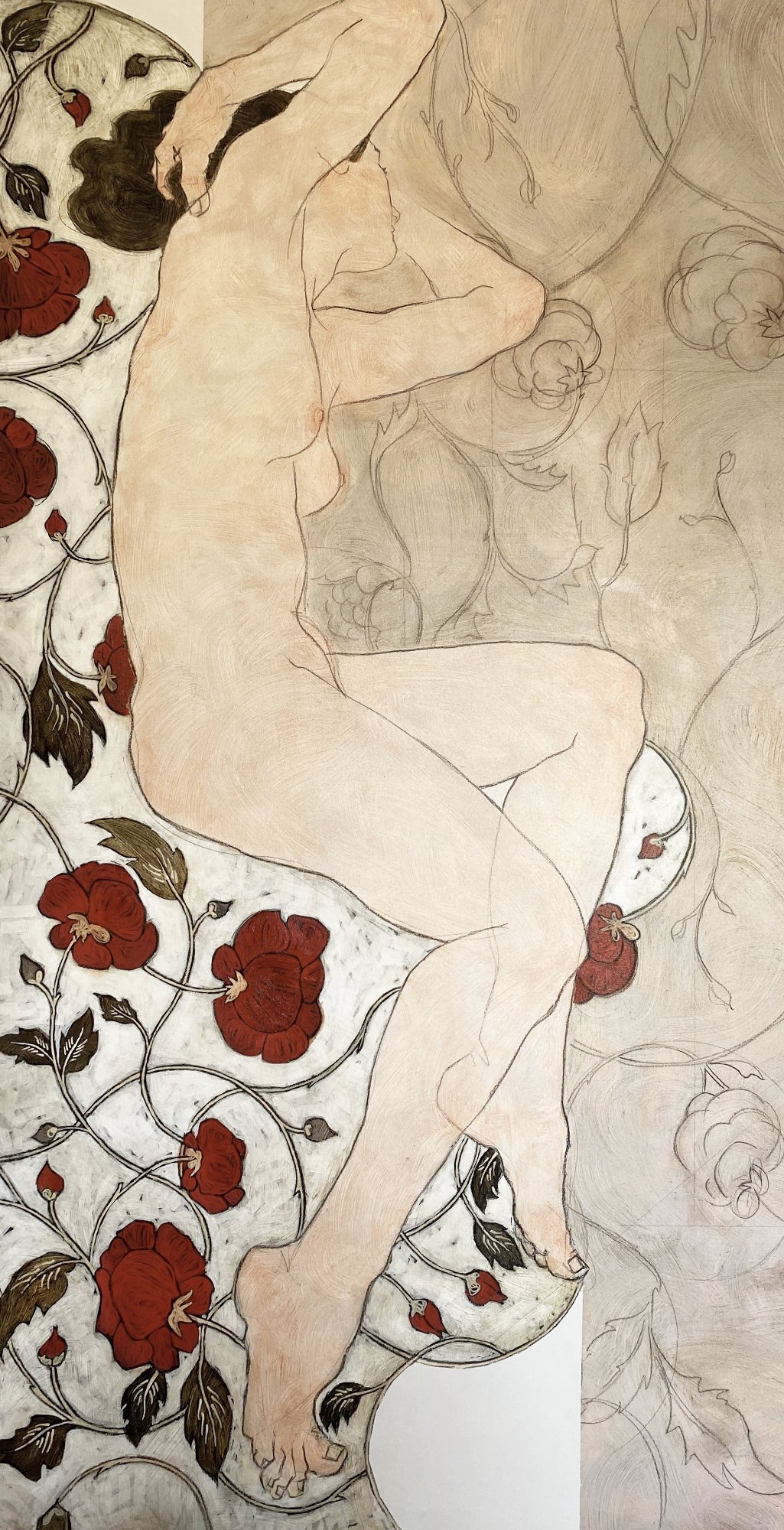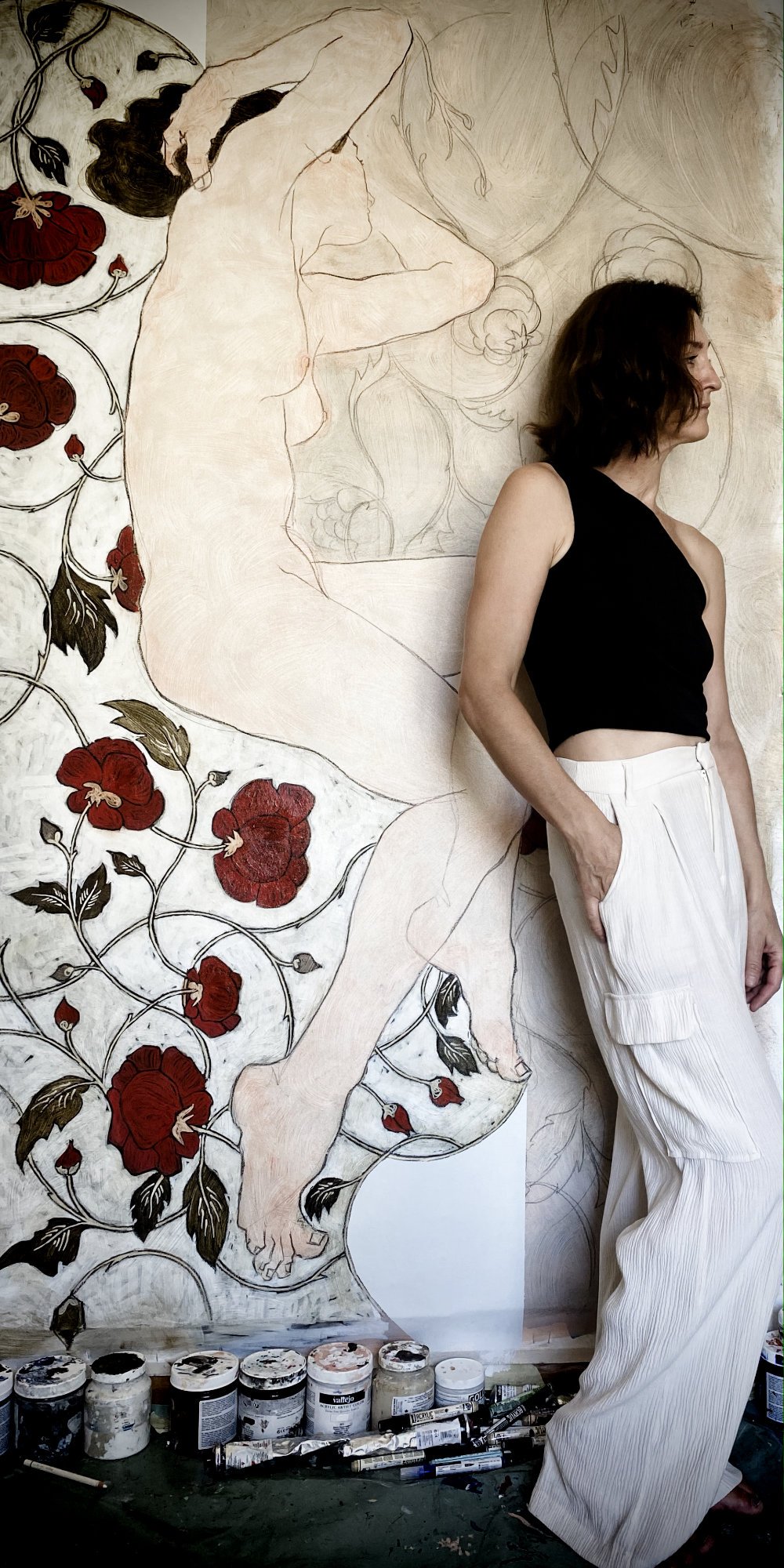EARTHLY PARADISE
EARTHLY PARADISE
The William Morris Collection
“History has remembered the kings and warriors, because they destroyed; art has remembered the people, because they created” - William Morris -
This collection was inspired by the work and life of William Morris and it stands on three corner stones; finding beauty in every detail of life, reviving the ideology of the Romantic Movement and painting the patterns of the heart onto canvas.
In this body of work I seek to describe the tapestry of the heart. This collection tells a story, a story of romanticism, of an ideal garden, an earthly paradise. The muse speaks of the longing for a thousand kisses upon her face. The flowers speak of a thousand secrets whispered in the wind and legends of the past still present in the essence of every petal. The patterns of the heart are a mystery, a whirling mass of energy, never satisfied with one single emotion, always seeking more complex feelings. The heart watches the tapestry of springtime colors, the stillness of a winter day and it beats its unique pattern of life.
William Morris was a British designer, poet and socialist best known for his style of Romanticism, who sought to depict nature in all its glory and beauty. He was also one of the founders of the Pre Raphaelite Brotherhood, a group of artists who aimed to revive the ideals of the Renaissance and to reject the academic styles of their time.
The Romantic Movement emphasized the importance of the moods of the heart, beauty and nostalgia. It is also often associated with the idealism of the muse, which symbolizes the belief that the world is beautiful, and that the imagination is a source of inspiration.
This collection seeks to rediscover the world as a place of wonder and to nurture the emotions through finding beauty in every corner of the heart.
“The true secret of happiness lies in the taking a genuine interest in all the details of daily life.”
- Willam Morris -
(Full version of the ideas and inspirations on this collection at the bottom of this page…)
ROSA AGATHA CHRISTIE - 130 X 182 CM
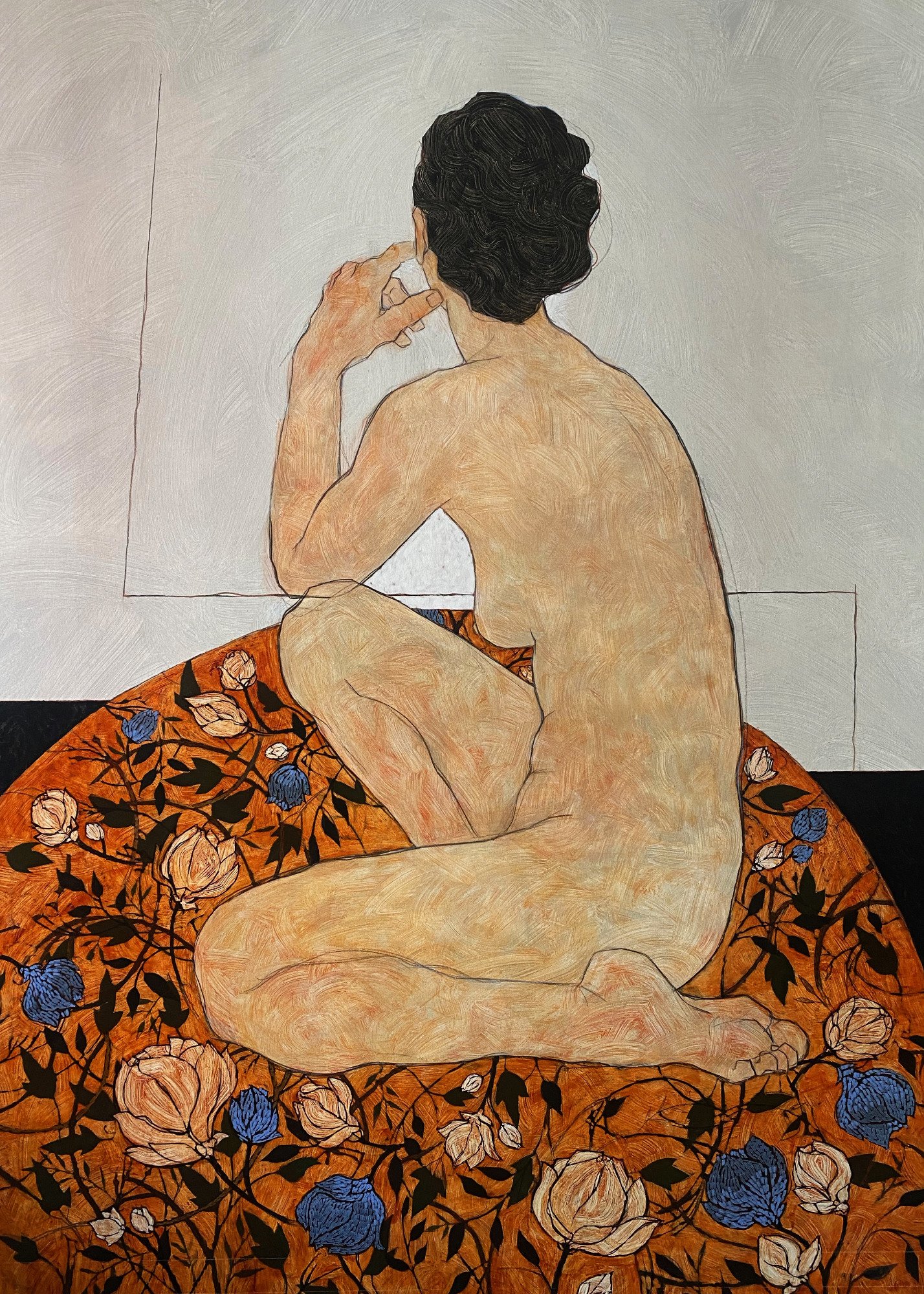
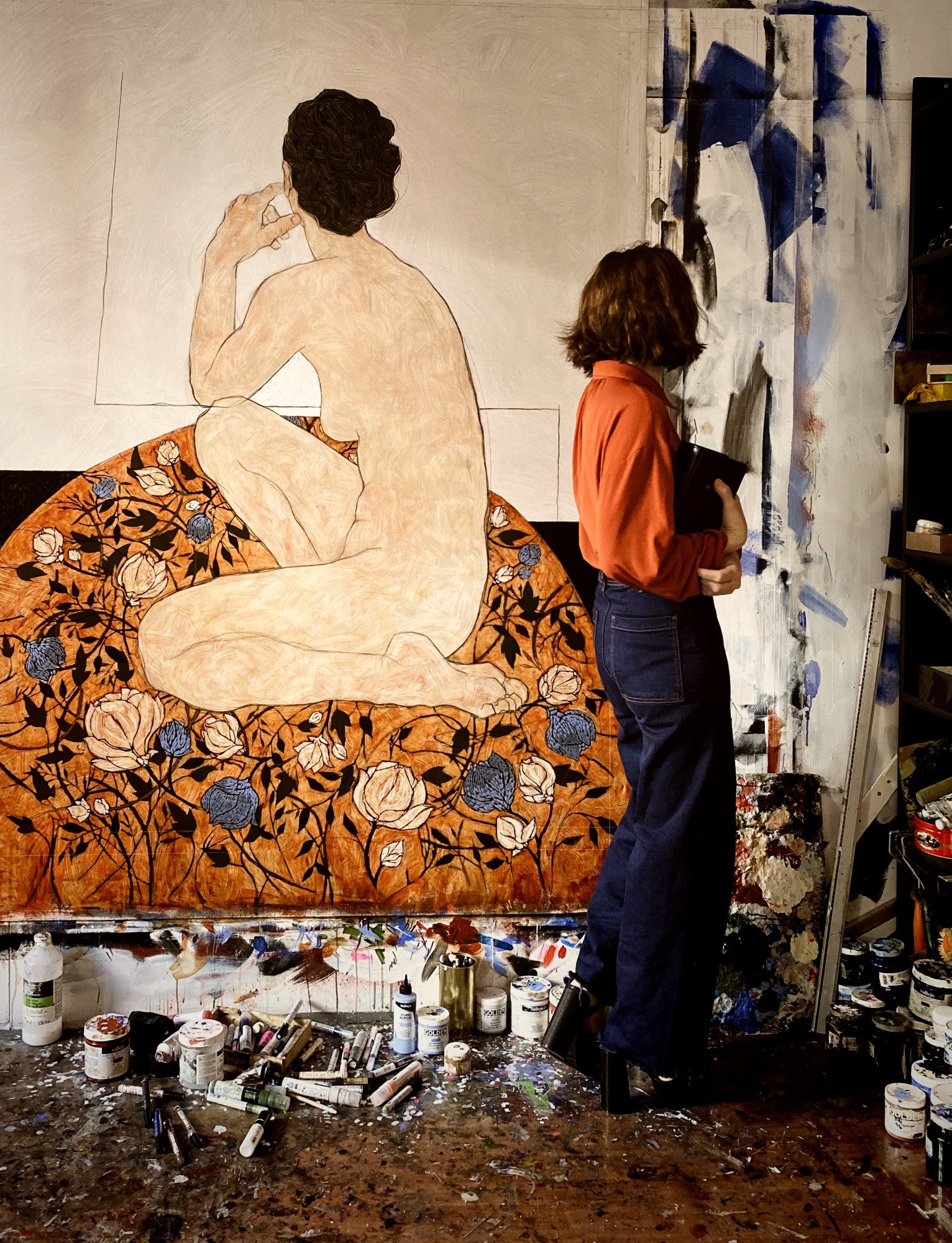
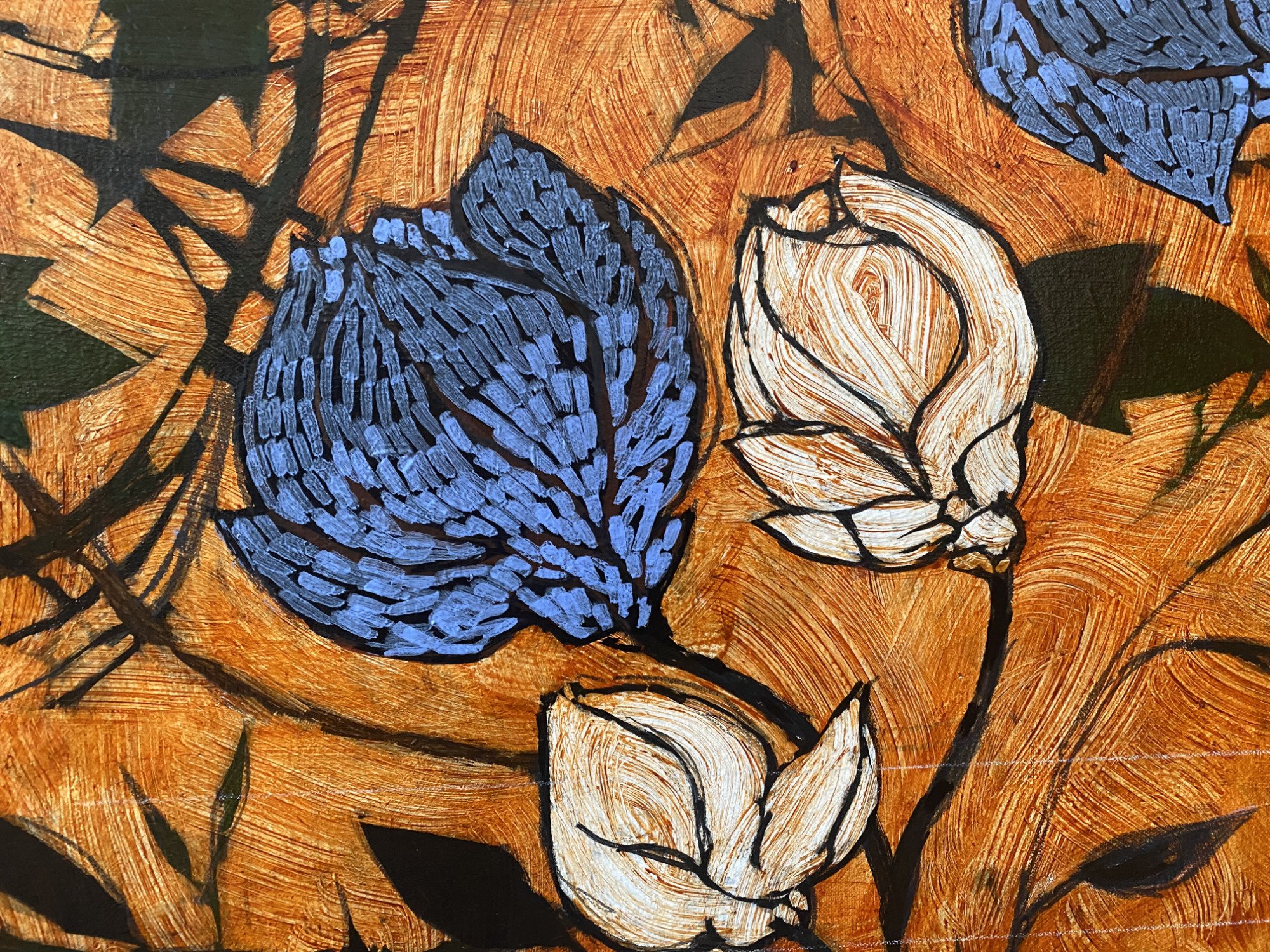
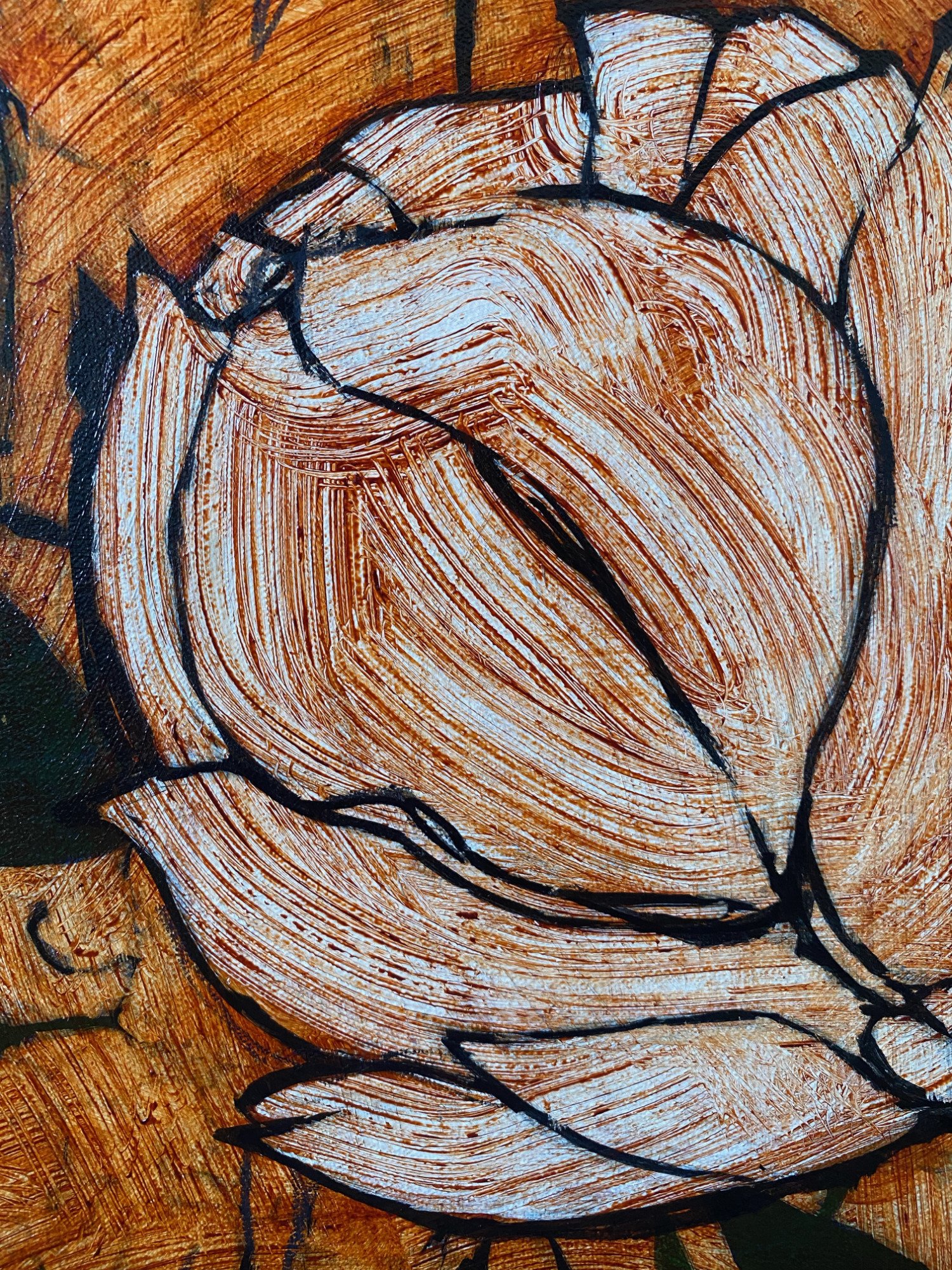
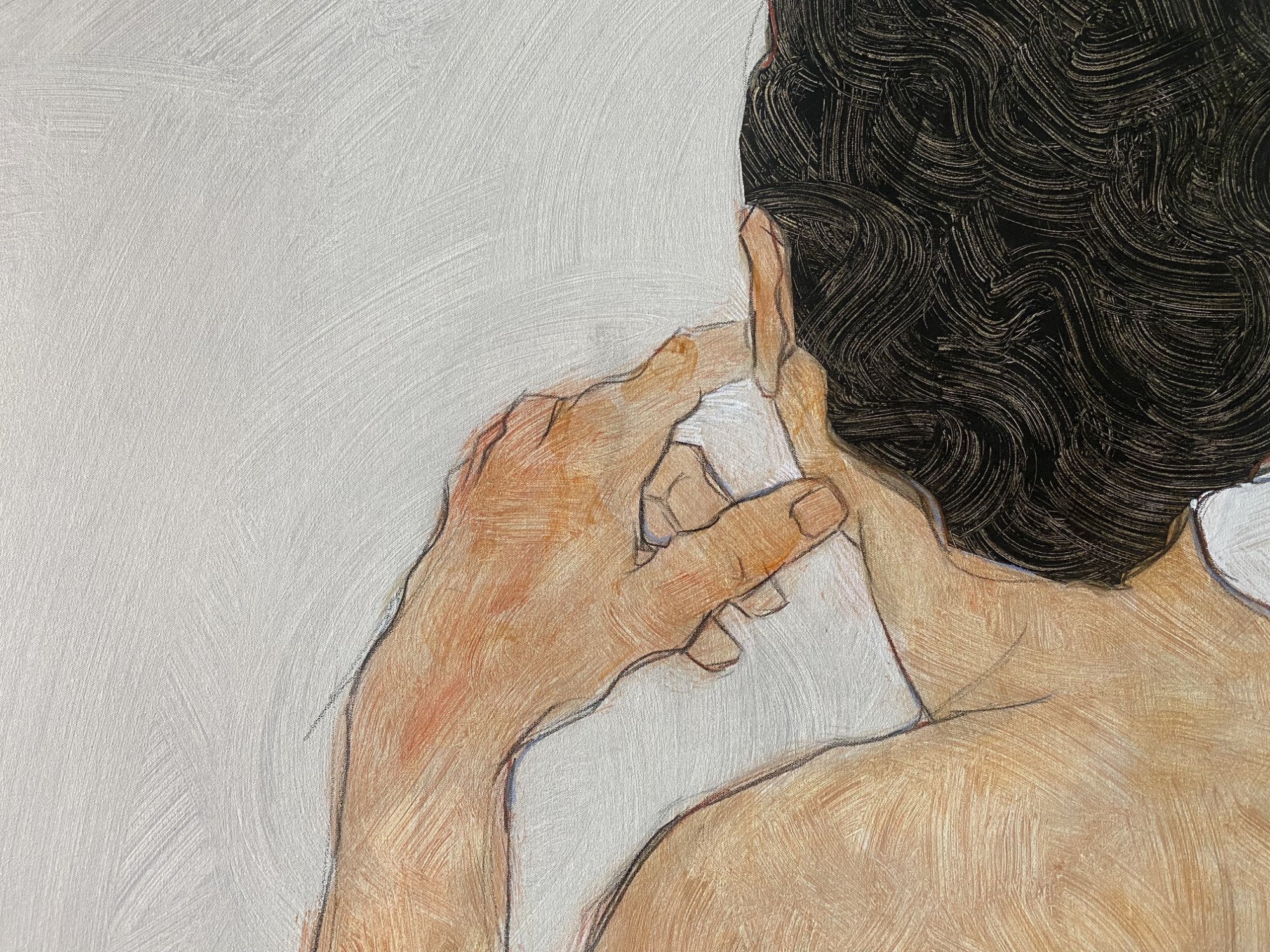
“OUR HANDS HAVE MET”
Our hands have met, our lips have met,
Our souls - who knows when the wind blows
How light souls drift mid longings set,
If thou forget’st , can I forget
The time that was not long ago?
Thou wert not silent then, but told
Sweet secrets dear - I drew so near
Thy shamefaced cheeks grown overbold,
That scarce thine eyes might I behold!
Ah was it then so long ago!
Trembled my lips and thou wouldst turn
But hadst no heart to draw apart,
Beneath my lips thy cheek did burn -
Yet no rebuke that I might learn;
Yea kind looks still, not long ago.
Wilt thou be glad upon the day
When unto me this love shall be
An idle fancy passed away,
And we shall meet and smile and say
”O wasted sighs of long ago!””
ROSA ZEPHIRINE - 160 x 192 CM
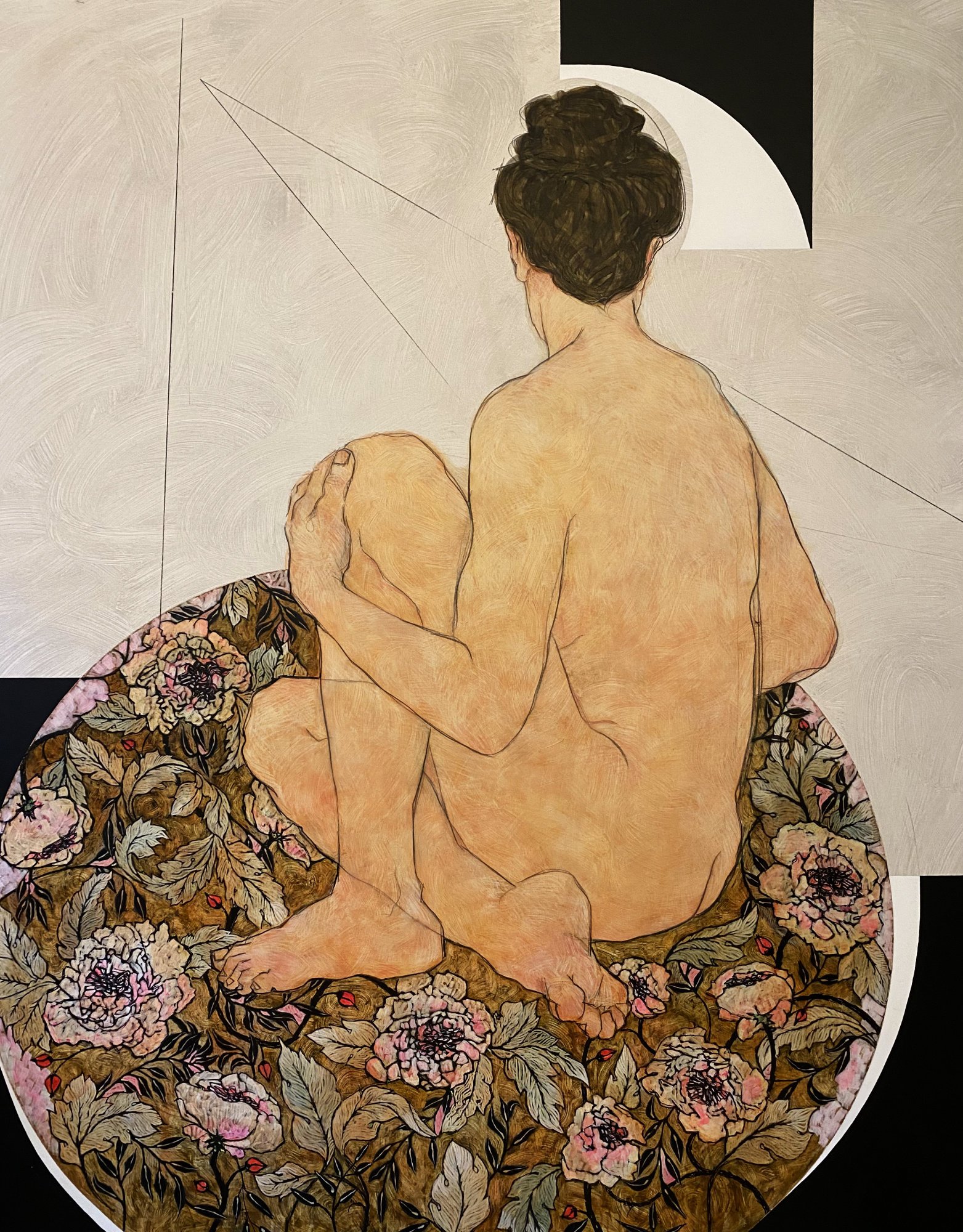
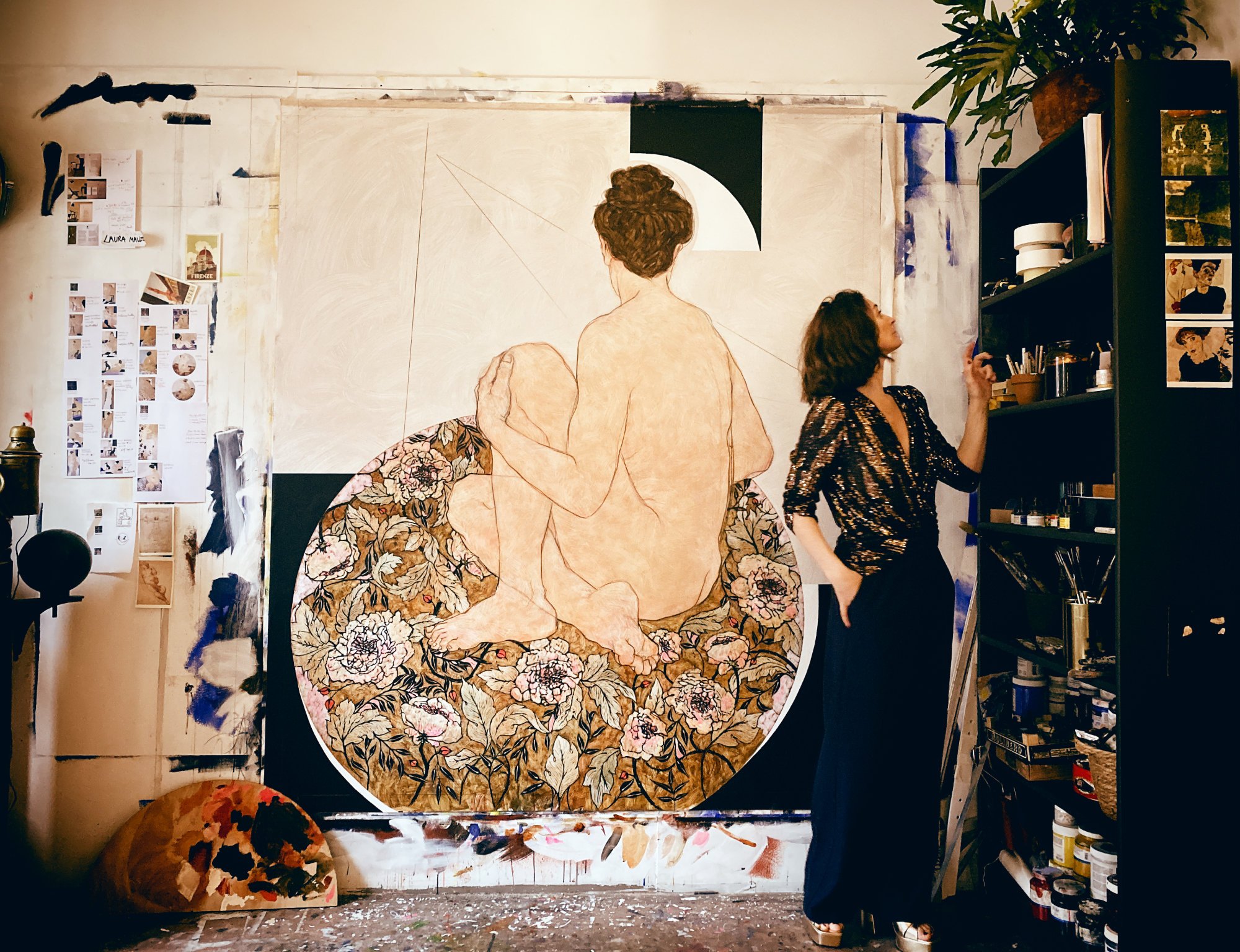
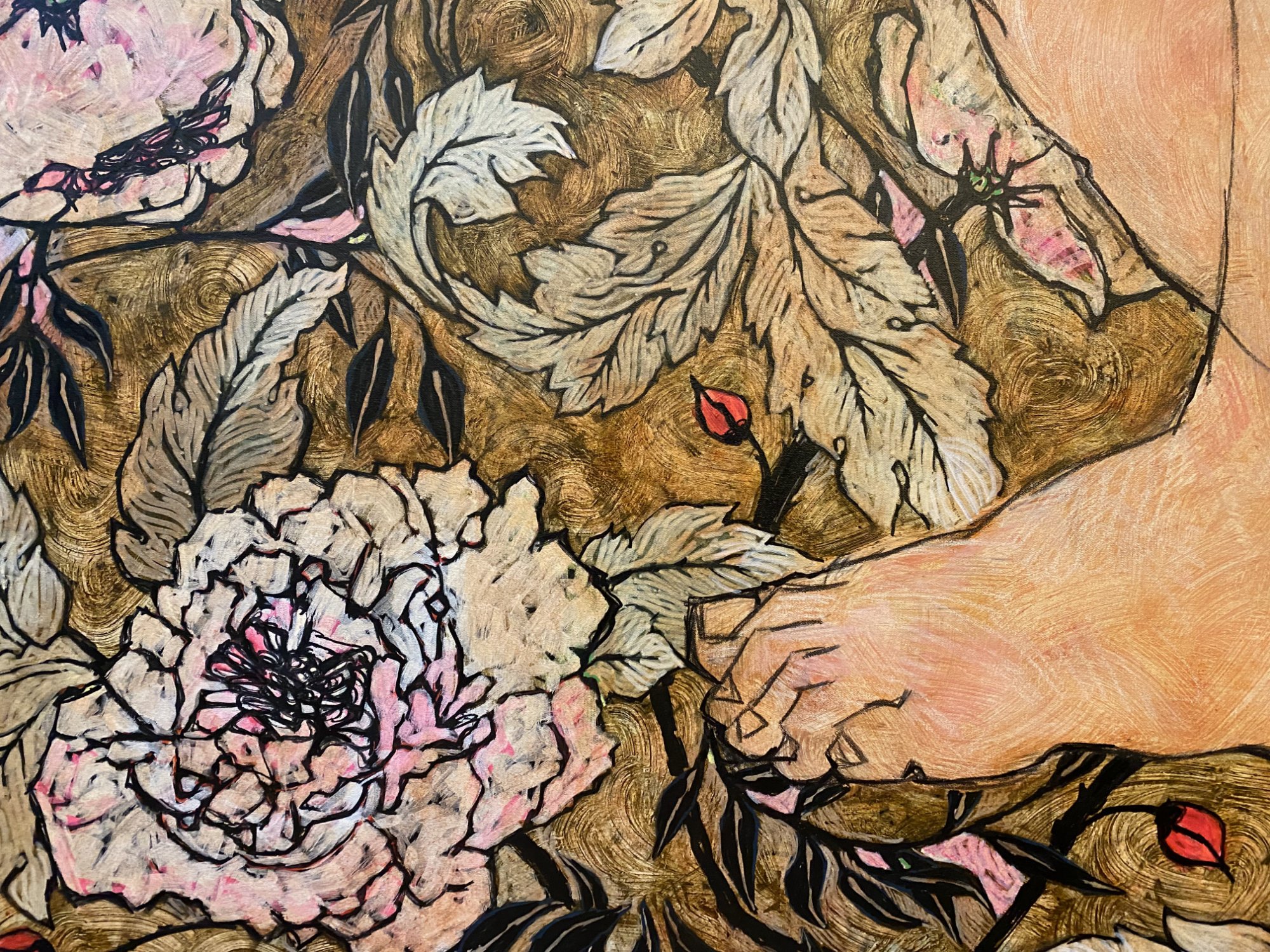
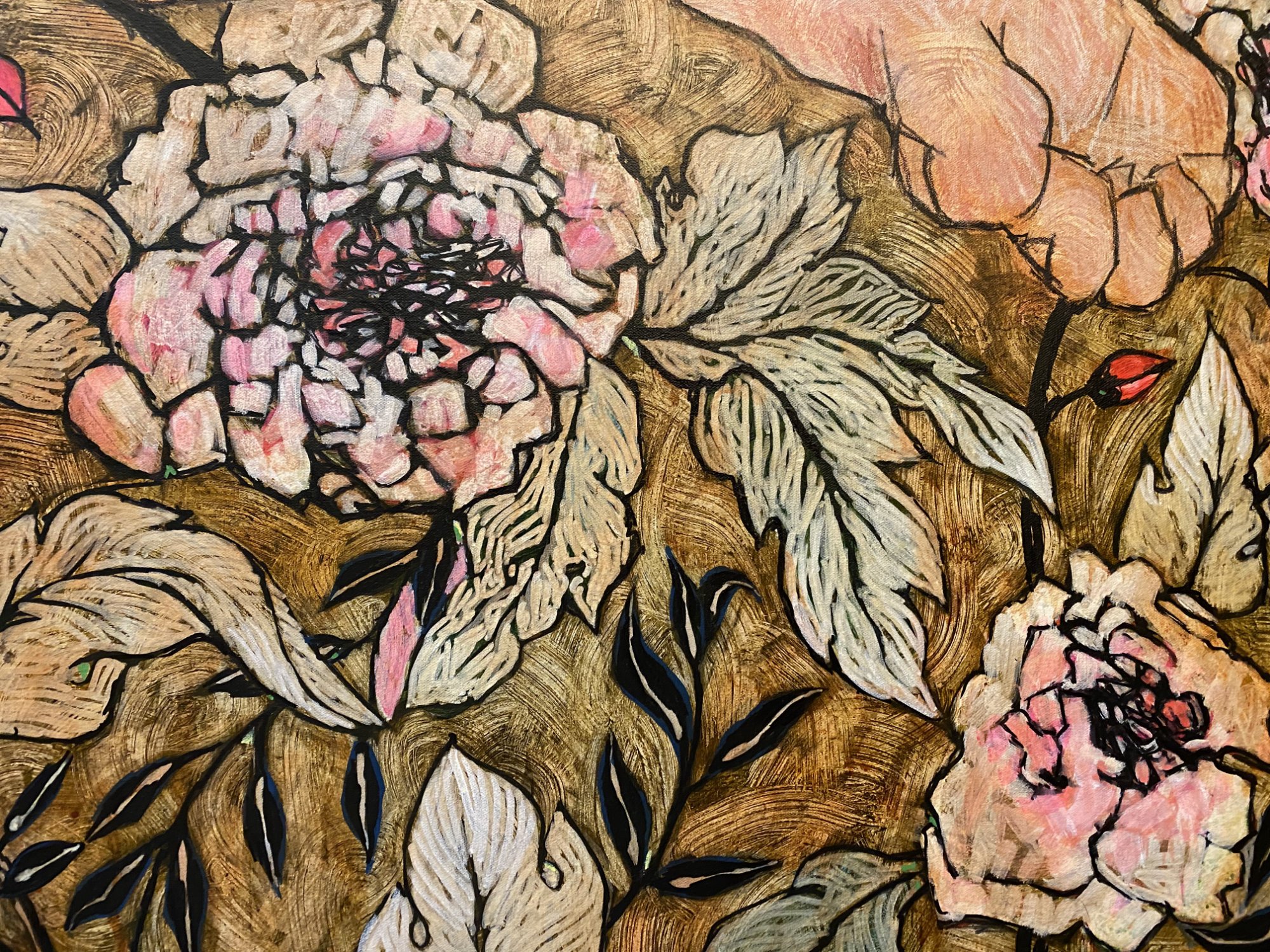
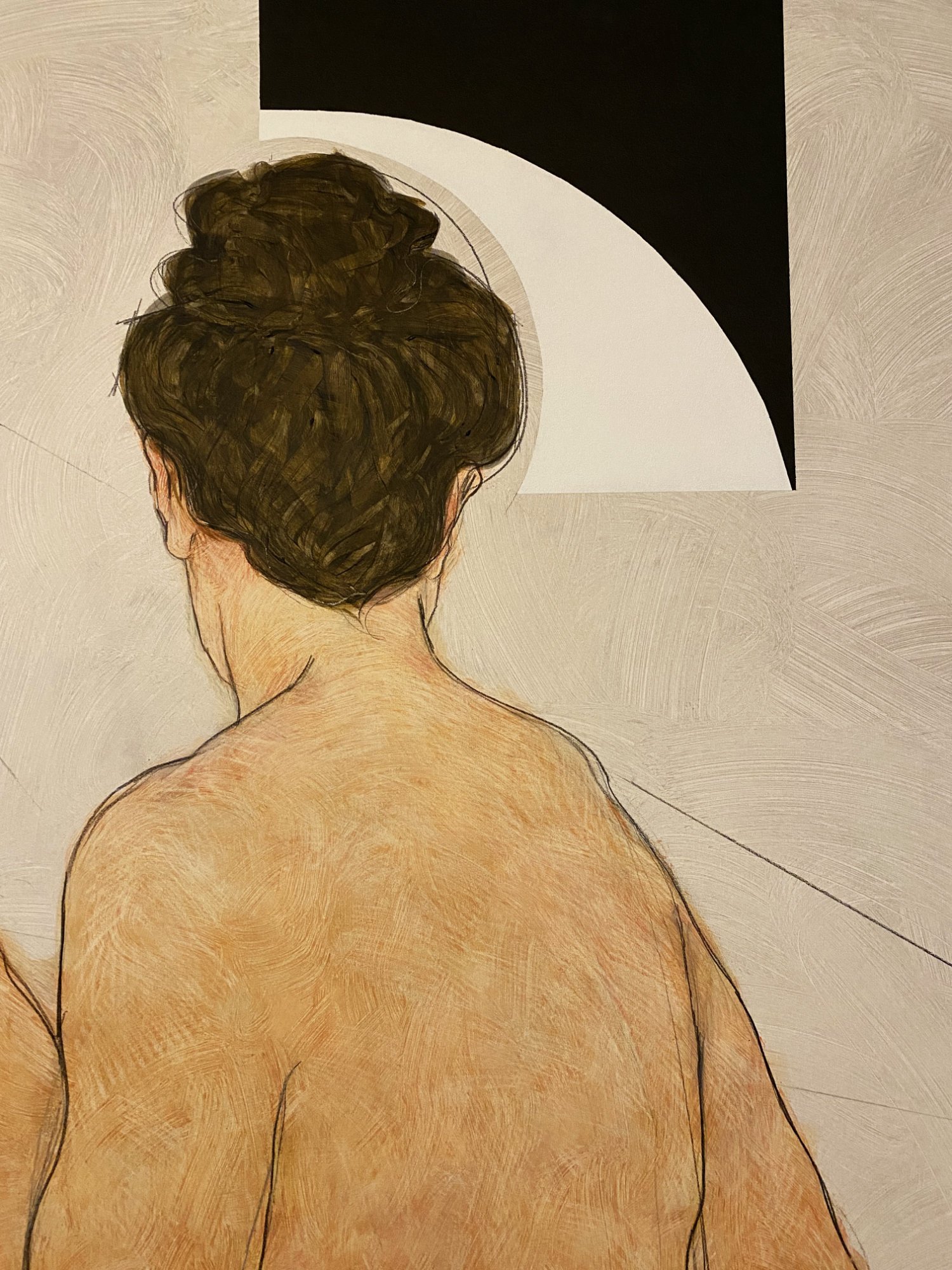
“SEPTEMBER”
O come at last, to whom the springtide’s hope
Looked for through blossoms, what hast thou for me?
Green grows the grass upon the dewy slope
Beneath thy gold-hung, grey-leaved apple-tree
Moveless, e’en as the autumn fain would be
That shades its sad eyes from the rising sun
And weeps at eve because the day is done.
What vision wilt thou give me, autumn morn,
To make thy pensive sweetness more complete?
What tale, ne’er to be told, of folk unborn?
What images of grey-clad damsels sweet
Shall cross thy sward with dainty noiseless feet?
What nameless shamefast longings made alive,
Soft-eyed September, will thy sad heart give?
Look long, O longing eyes, and look in vain!
Strain idly, aching heart, and yet be wise,
And hope no more for things to come again
That thou beheldest once with careless eyes!
Like a new-wakened man thou art, who tries
To dream again the dream, that made him glad
When in his arms his loving love he had.”
BOURGATI OXFORD BLUE - 180 CM diameter
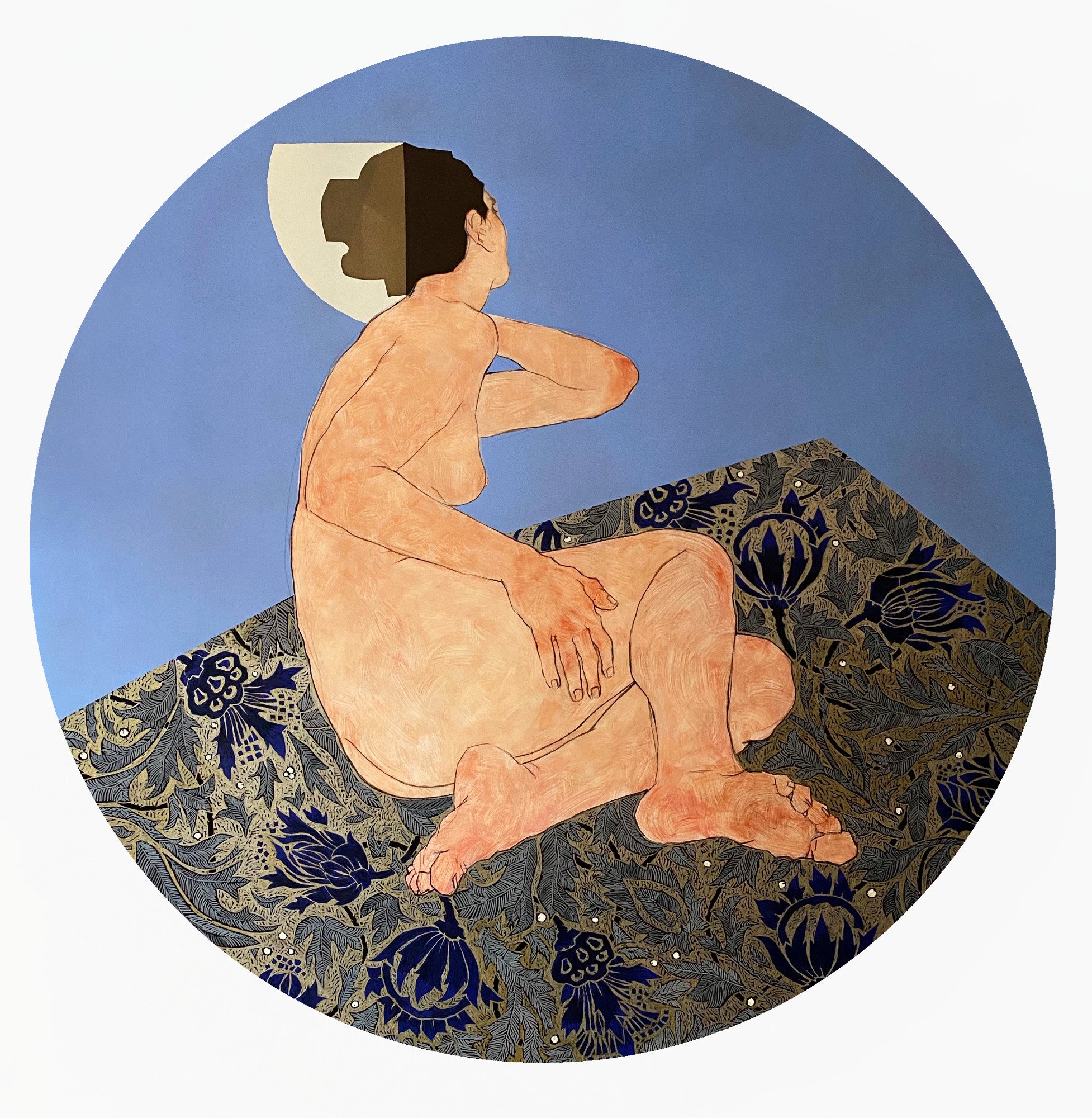

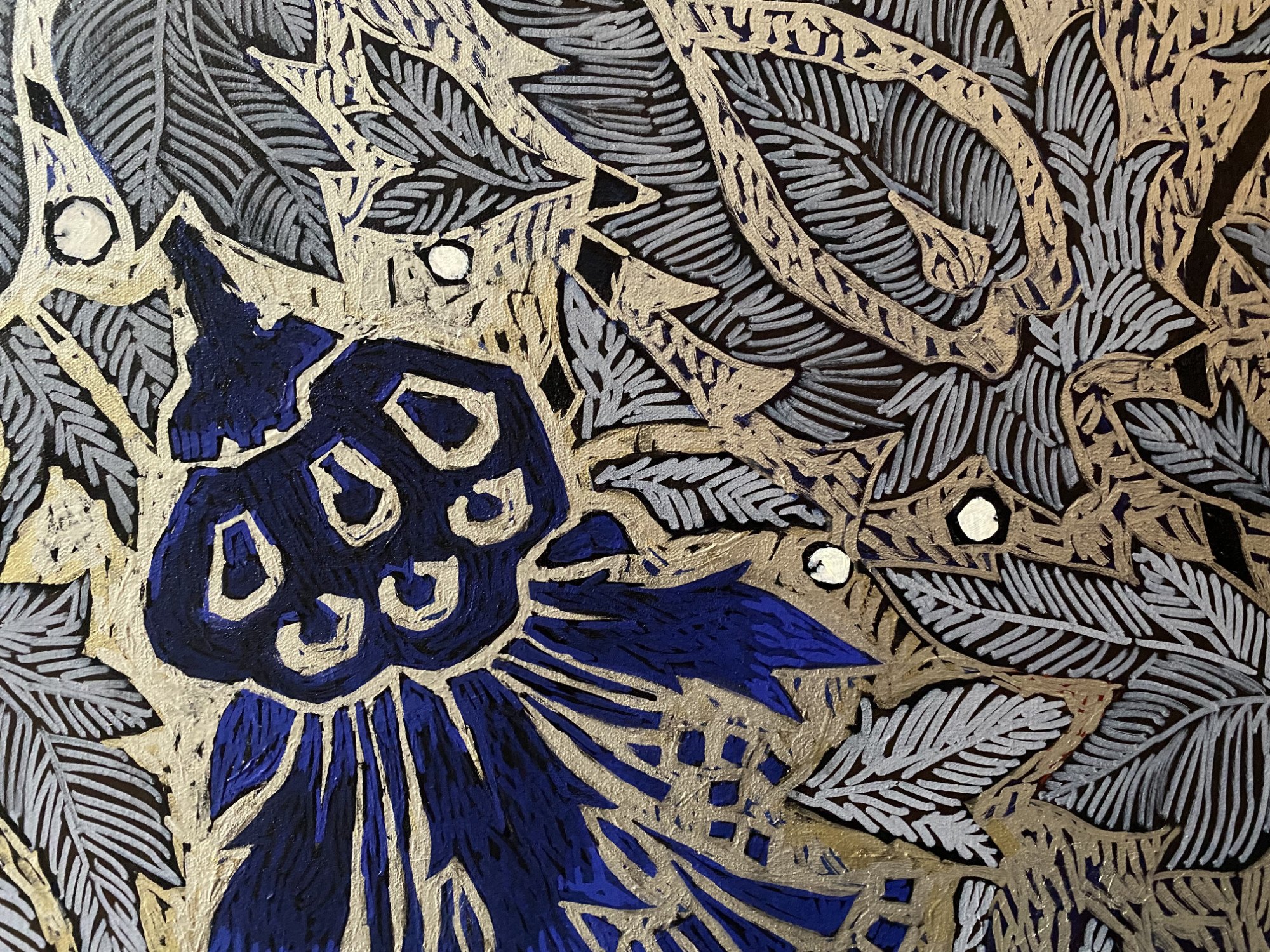

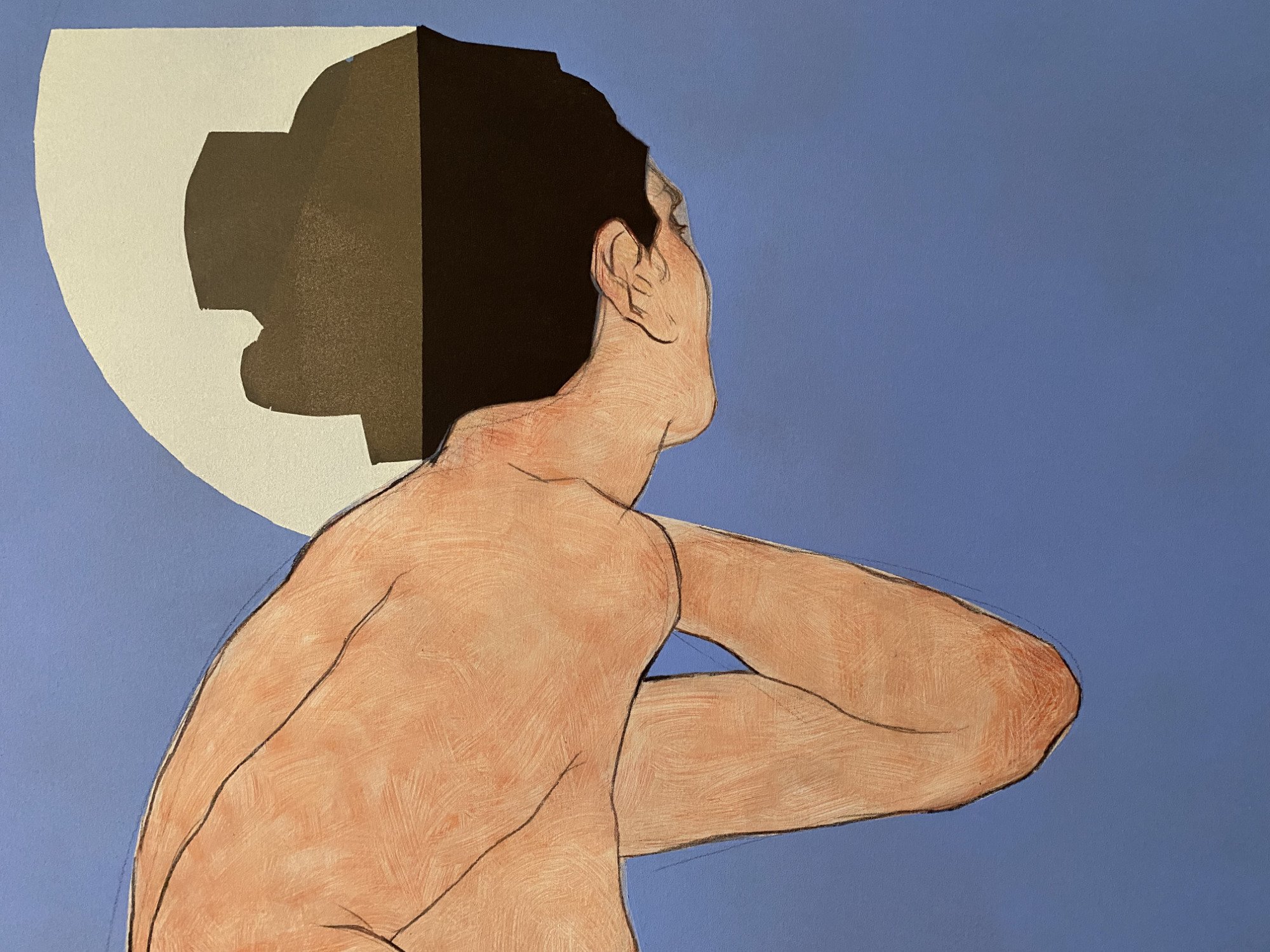
“MARCH”
Slayer of the winter, art thou here again?
O welcome, thou that bring’st the summer nigh!
The bitter wind make not thy victory vain,
Nor will we mock thee for thy faint blue sky.
Welcome, O March! whose kindly days and dry
Make April ready for the throstle’s song,
Thou first redresser of the winter’s wrong!
Yea, welcome March! and though I die ere June,
Yet for the hope of life I give thee praise,
Striving to swell the burden of the tune
That even now I hear thy brown birds raise,
Unmindful of the past or coming days;
Who sing: “O joy! a new year is begun:
What happiness to look upon the sun!”
Ah, what begetteth all this storm of bliss
But Death himself, who crying solemnly,
E’en from the heart of sweet Forgetfulness,
Bids us “Rejoice, lest pleasureless ye die.
Within a little time must ye go by.
Stretch forth your open hands, and while ye live
Take all the gifts that Death and Life may give.”
CARDINALIS - 140 x 192 CM
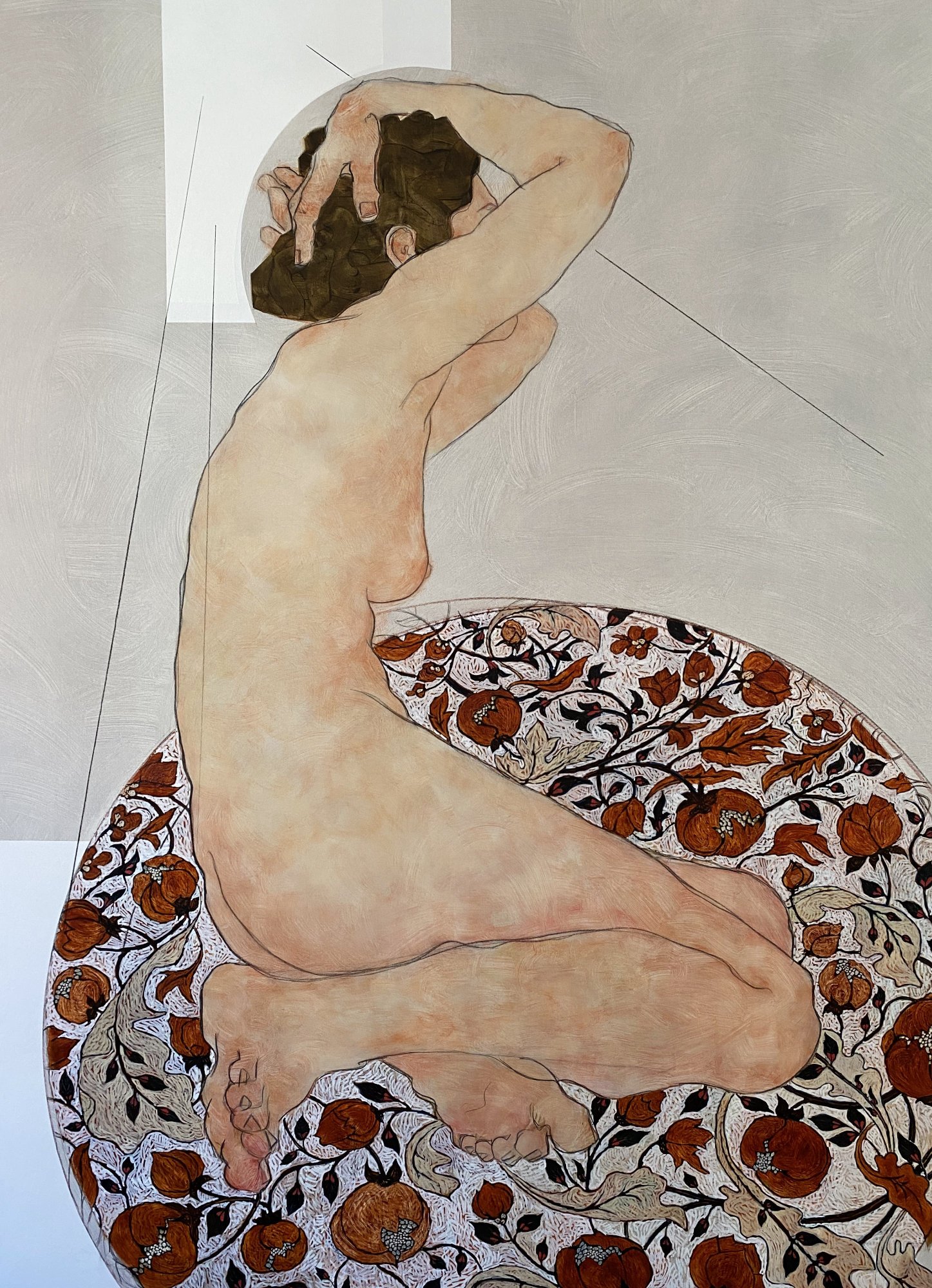

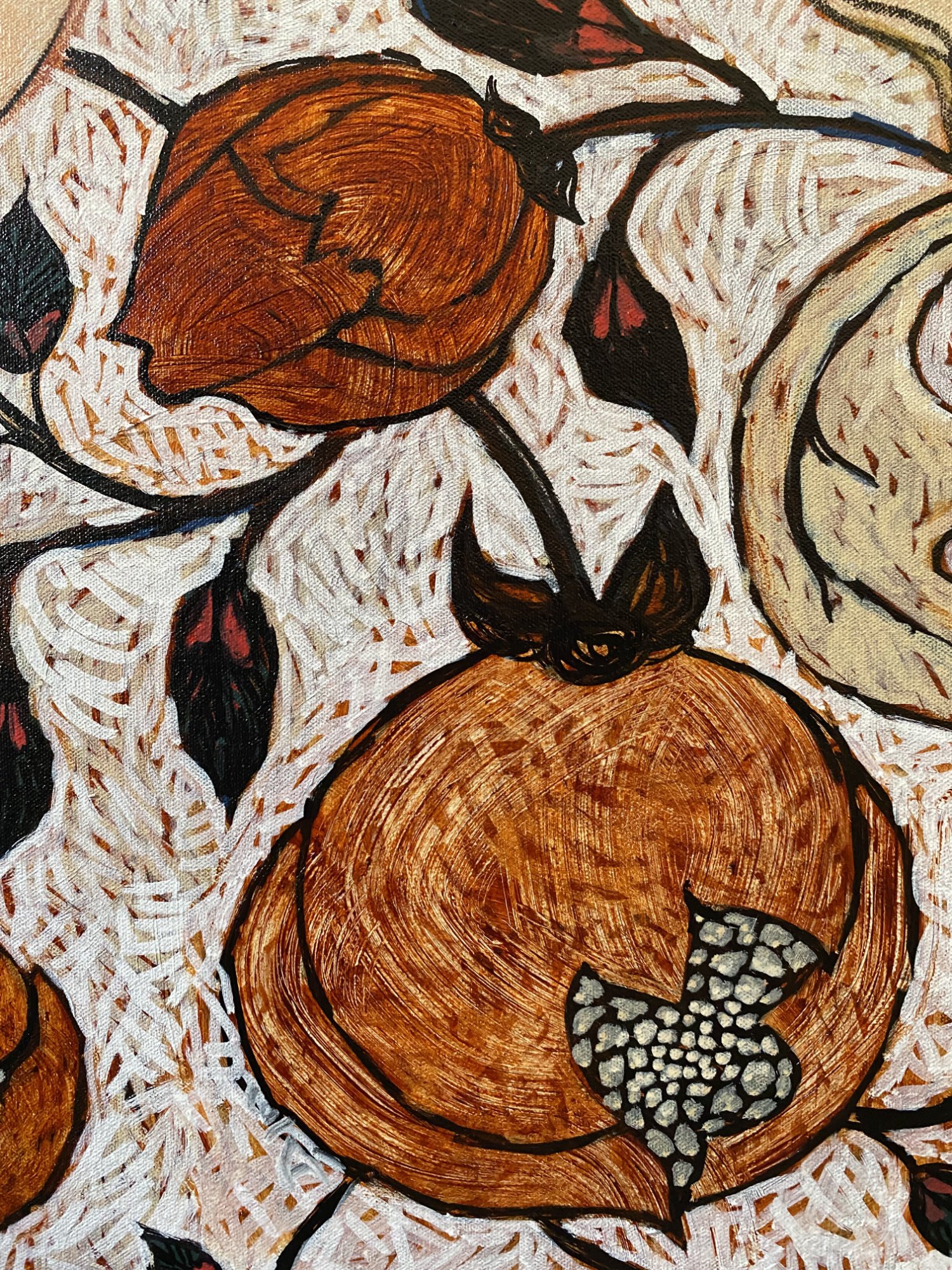
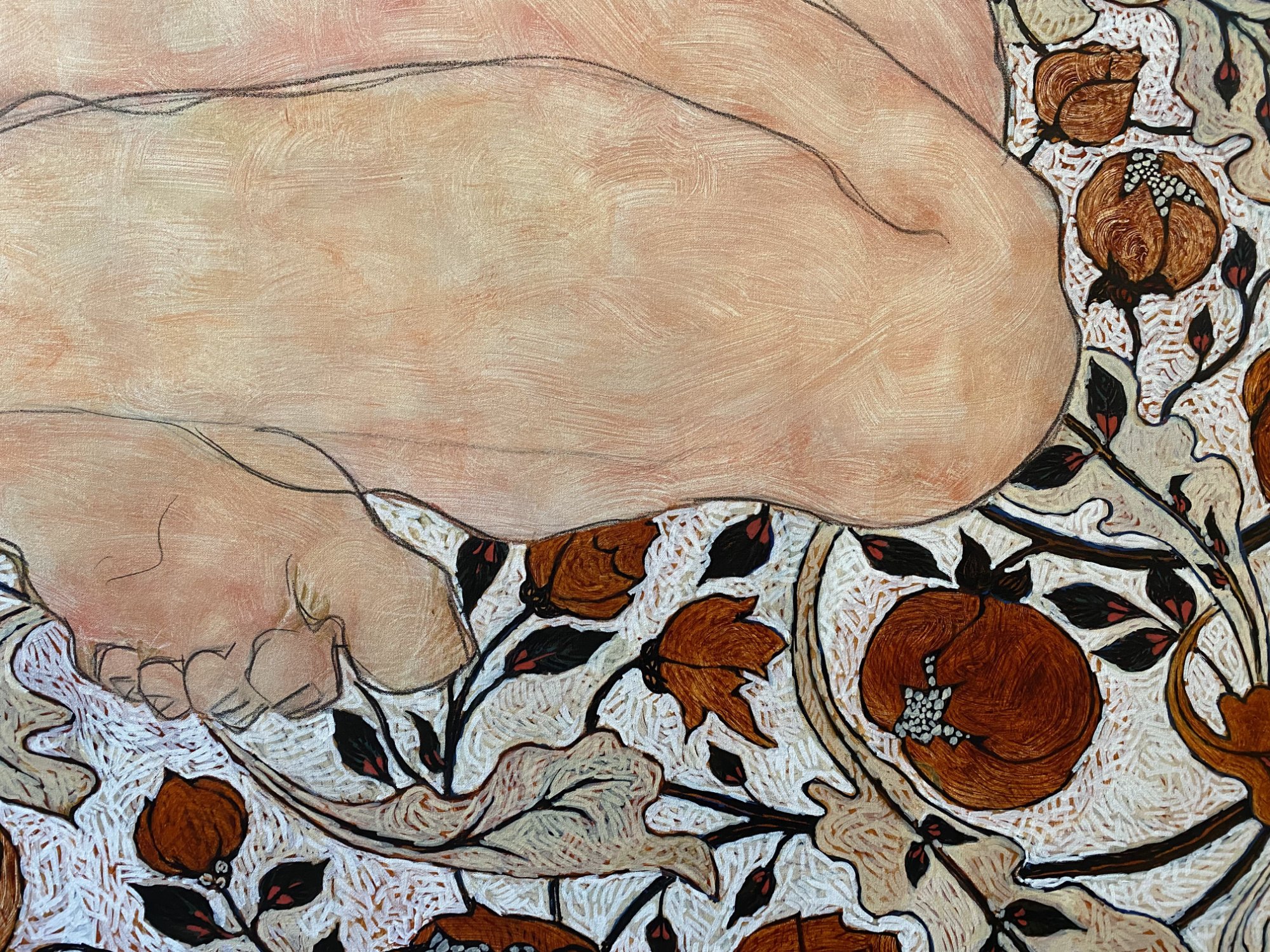
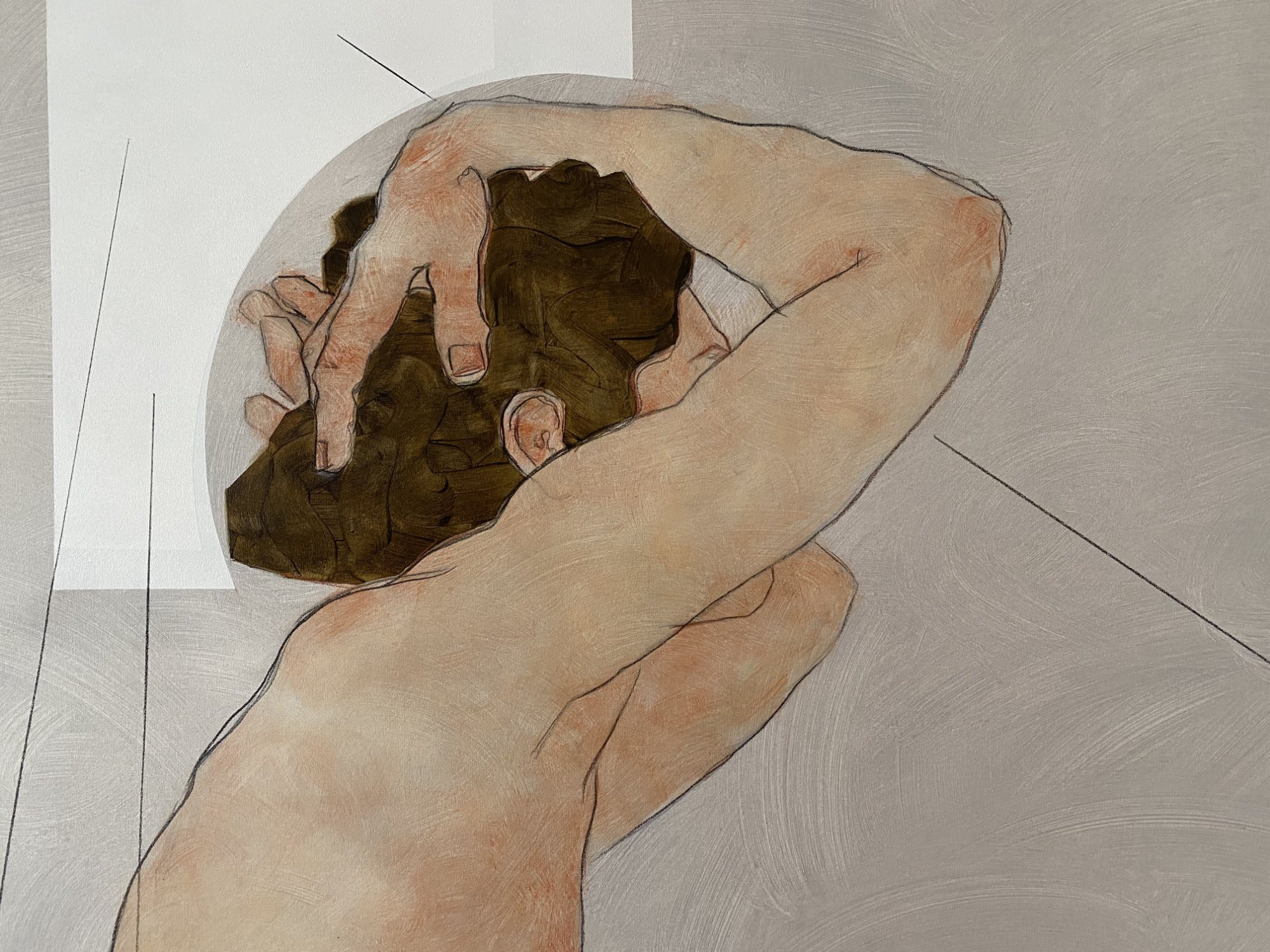
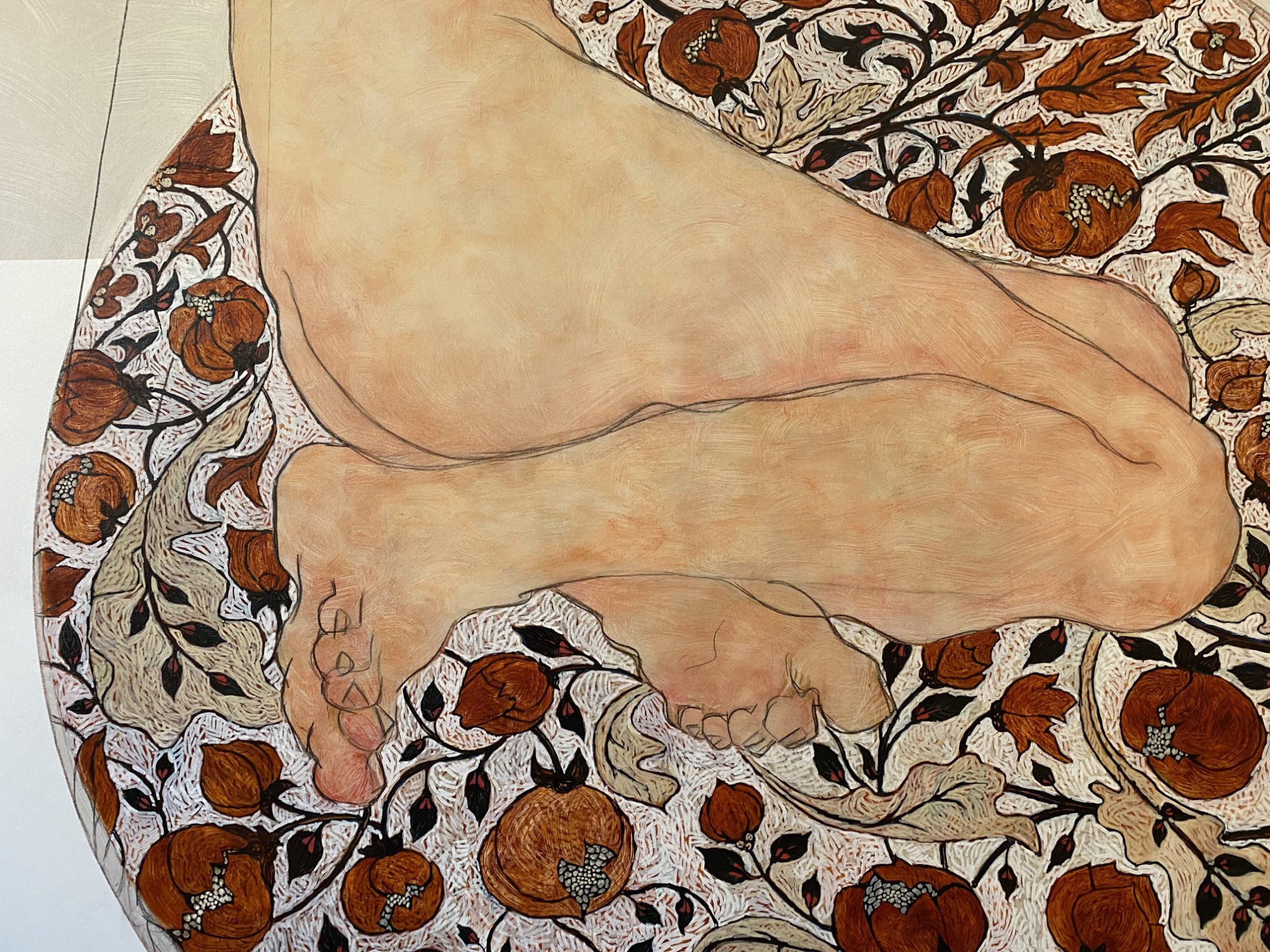
“MAY”
O love, this morn when the sweet nightingale
Has so long finished all he had to say,
That thou hadst slept, and sleep had told his tale;
And midst a peaceful dream had stolen away
In fragrant dawning of the first of May,
Didst thou see aught? didst thou hear voices sing
Ee to the risen sun the bells ‘ gan rig?
For then methought the Lord of Love went by
To take possession of his flowery throne,
Ringed round with maids, and youths, and minstrelsy;
A little while I sighed to find him gone,
A little while the dawning was alone,
And the light gathered; then I held my breath,
And shuddered at the sight of Eld and Death.
Alas! Love passed me in the twilight dun,
His music hushed the wakening ousel’s song;
But on these twain shone out the golden sun,
And o’er their heads the brown bird’s tune was strong,
As shivering, twixt the trees they stole along;
None noted aught their noiseless passing by,
The world had quite forgotten it must die.”
SANGUINEA - 138 CM diameter


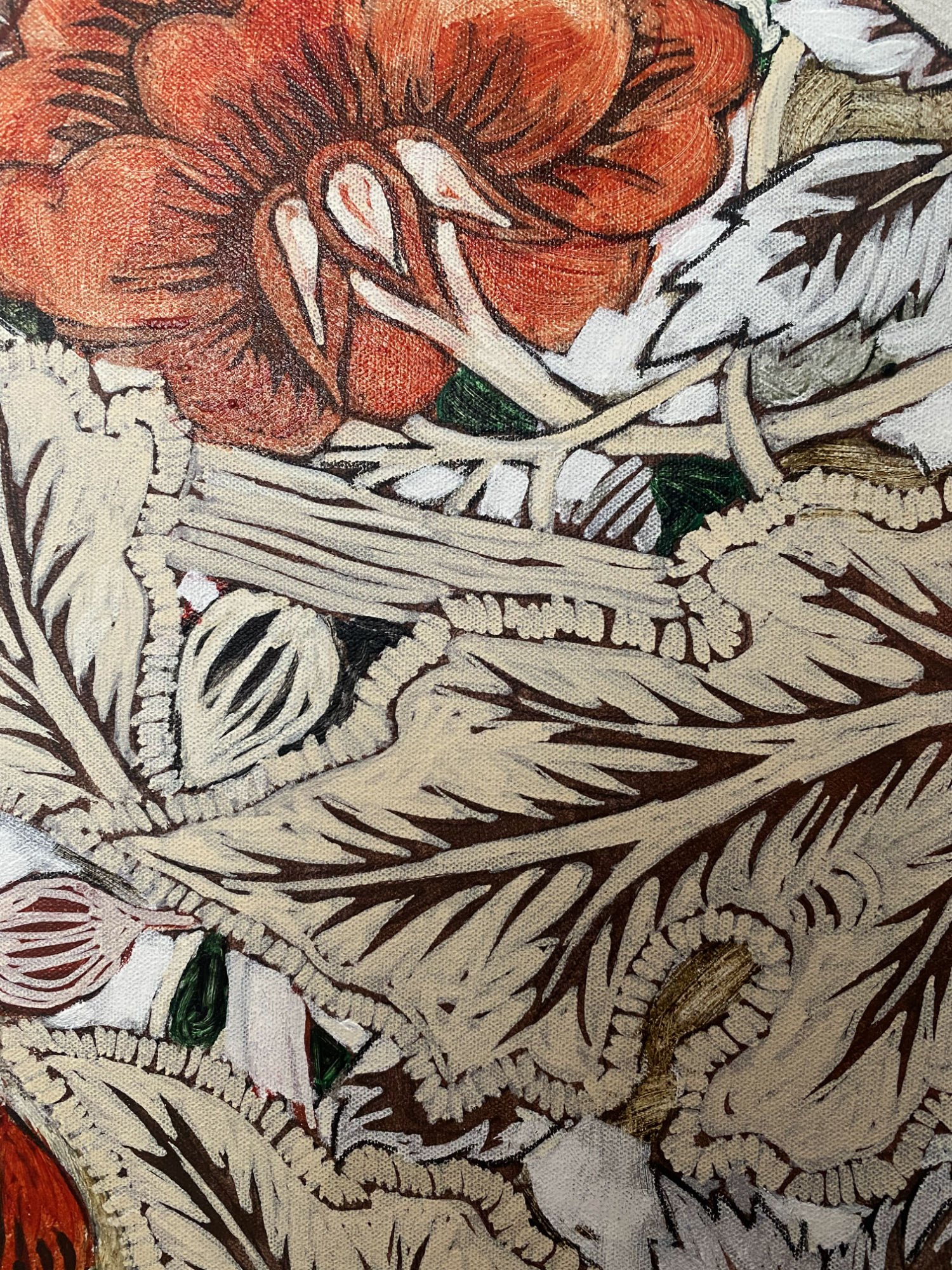
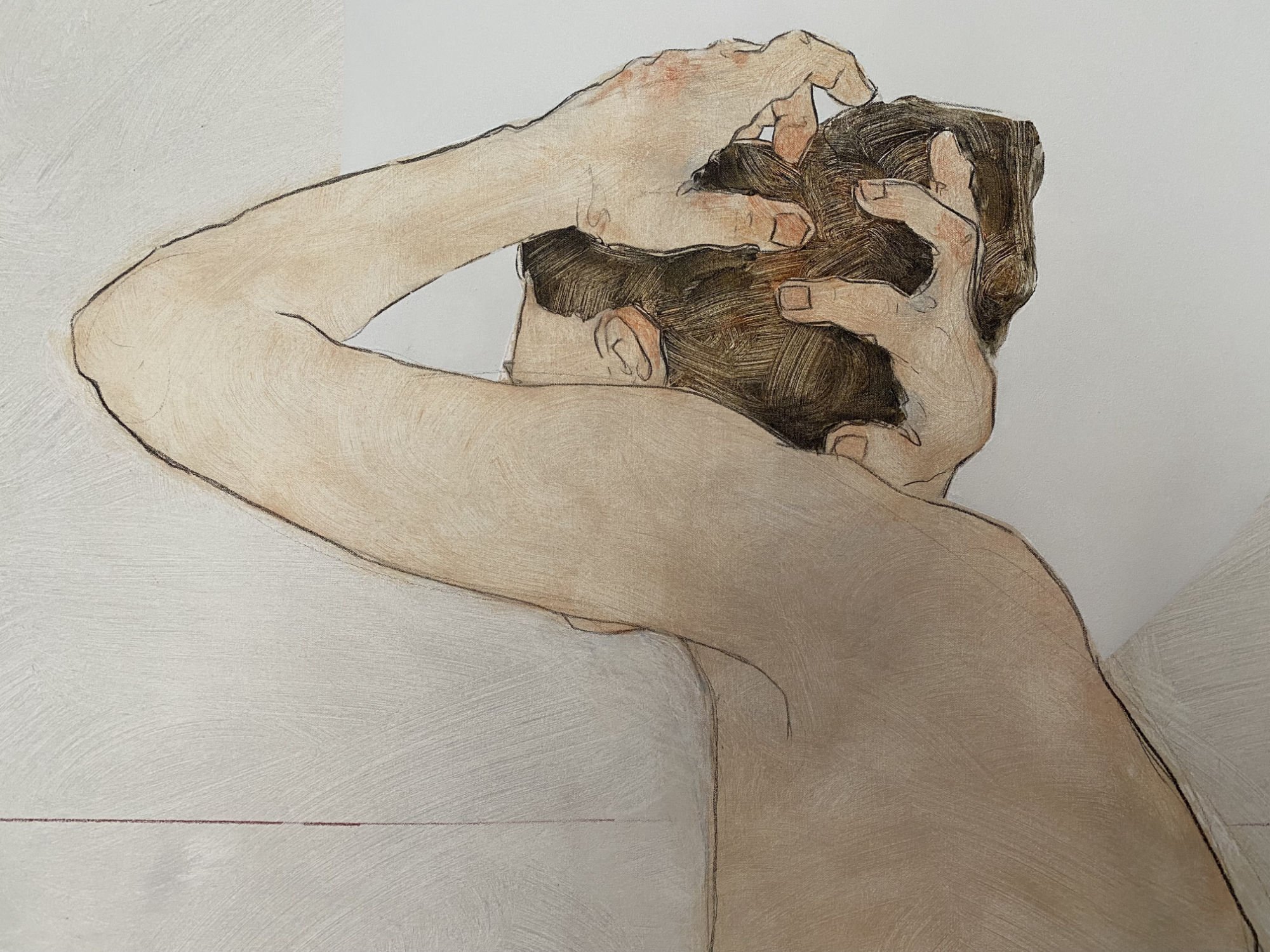
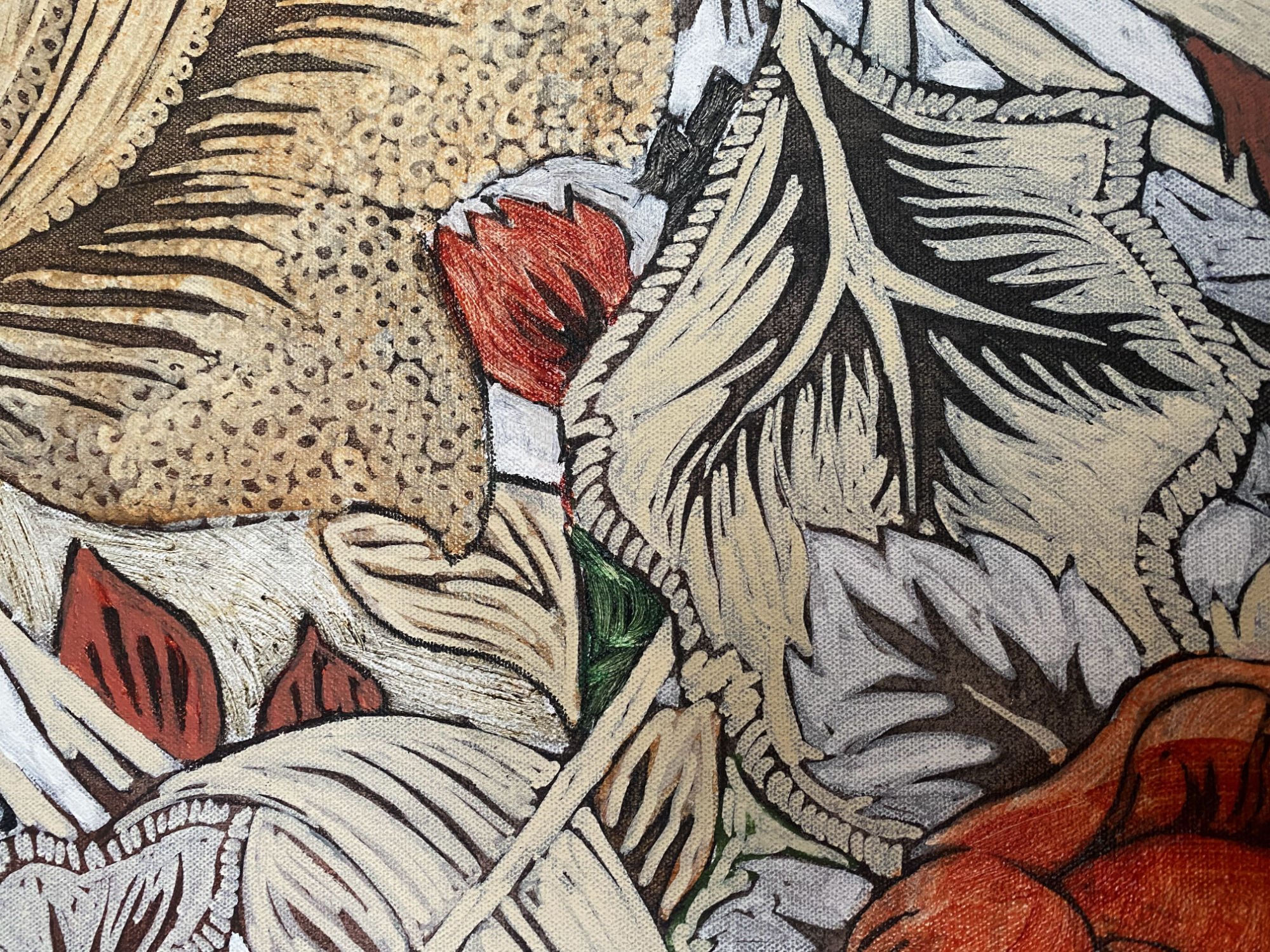
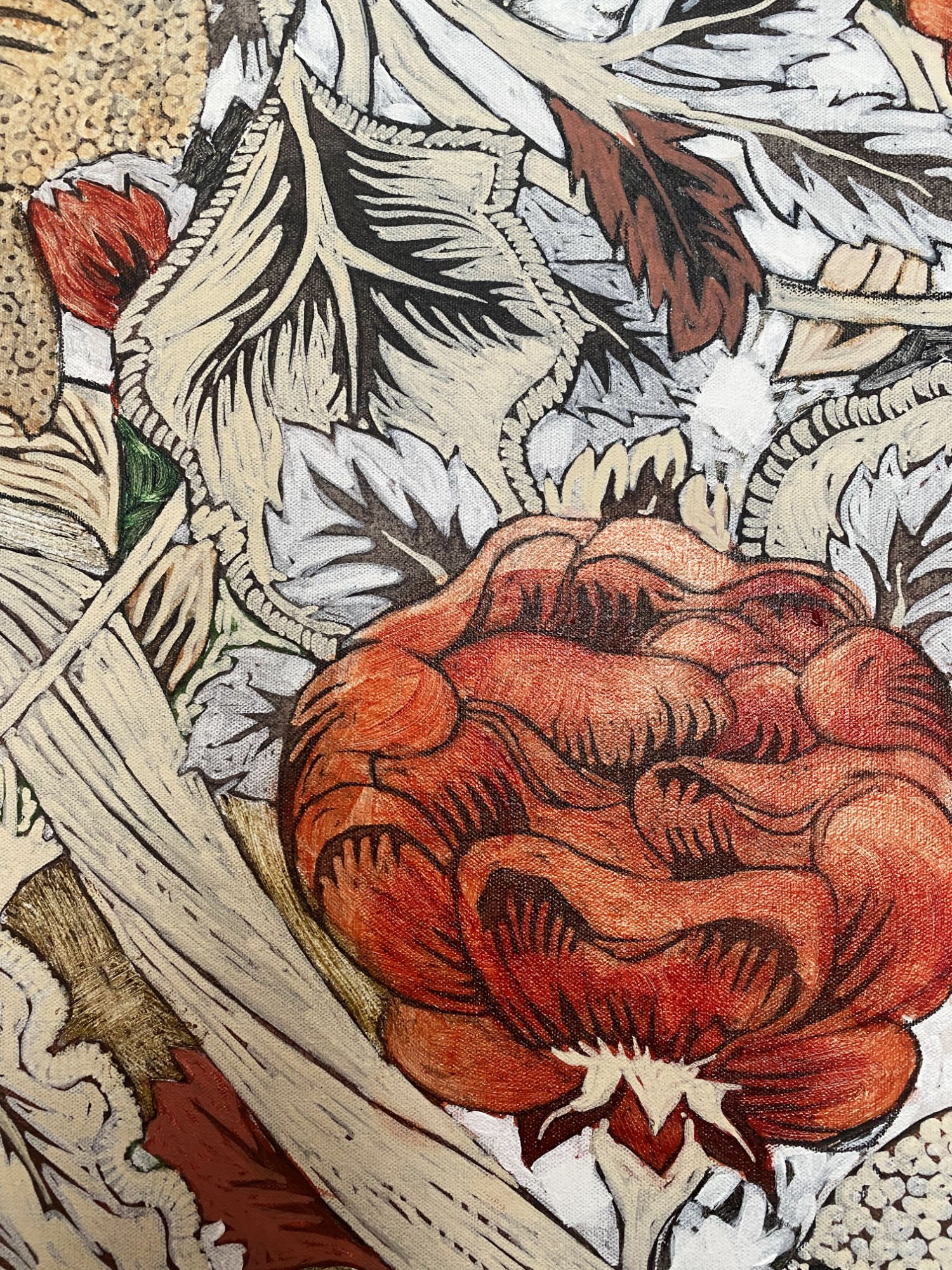

“(iv)”
”Lo, such as is this garden green,
In days past, all the world has been,
And what we know all people knew,
Save this, that undo worse all grew.
”But since the golden age is gone,
This little place is left alone,
Unchanged, unchanging, watched of us,
The daughters of wise Hesperus.
”Surely the heavenly Messenger
Full oft is fain to enter here,
And yet without must he abide;
Nor longeth less the dark king’s bride
To set red lips unto that fruit
That erst made nought her mother’s suit.
Here would Diana rest awhile,
Forgetful of her woodland guile,
Among these beasts that fear her nought.
Nor is it less Pallas’ thought,
Beneath our trees to ponder o’er
The wide, unfathomed sea of lore;
And oft kissed Citheraea, no less
Weary of love, full fain would press
These flowers with soft unsandalled feet.”
RUBENS - 145 CM diameter
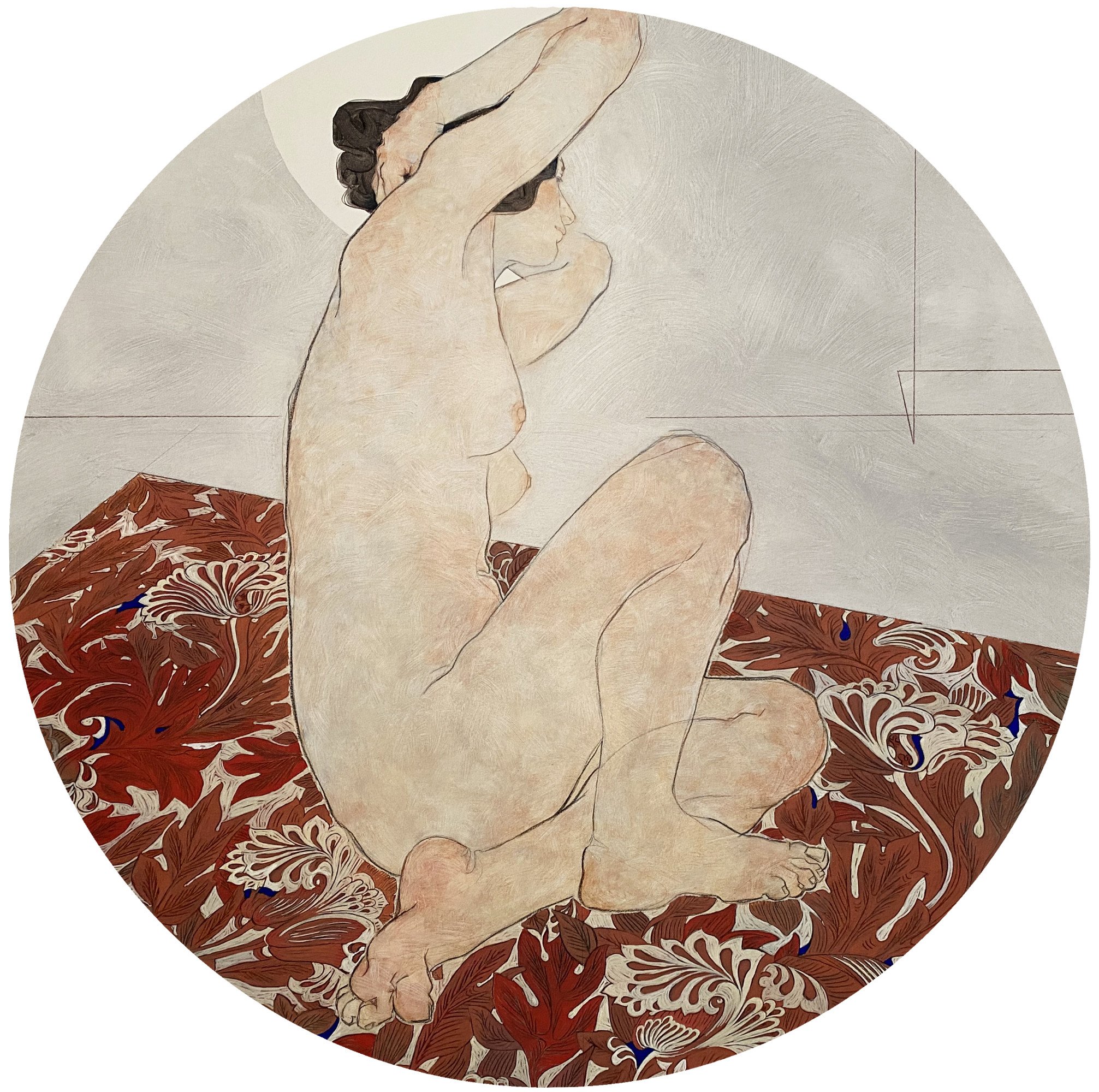
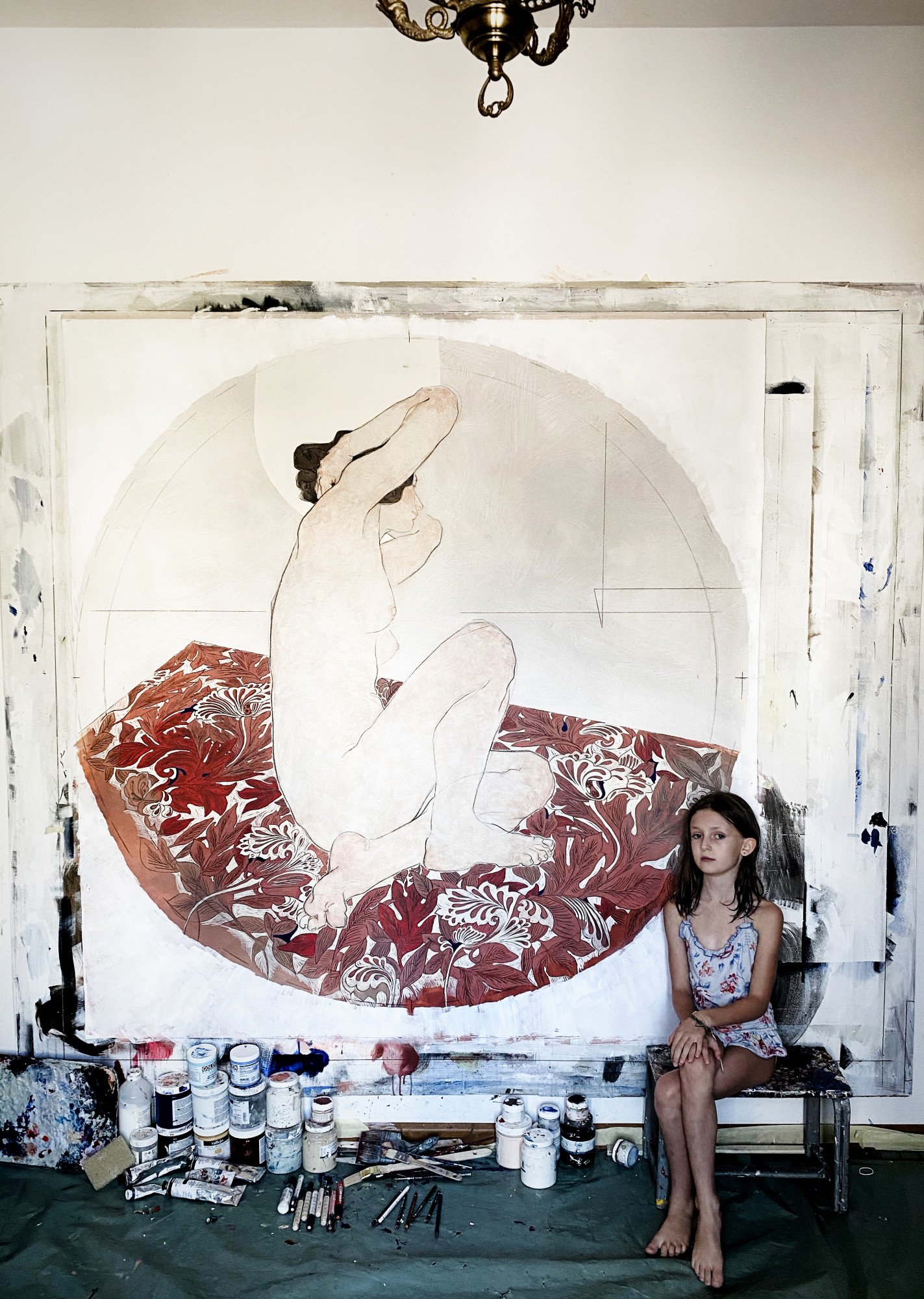

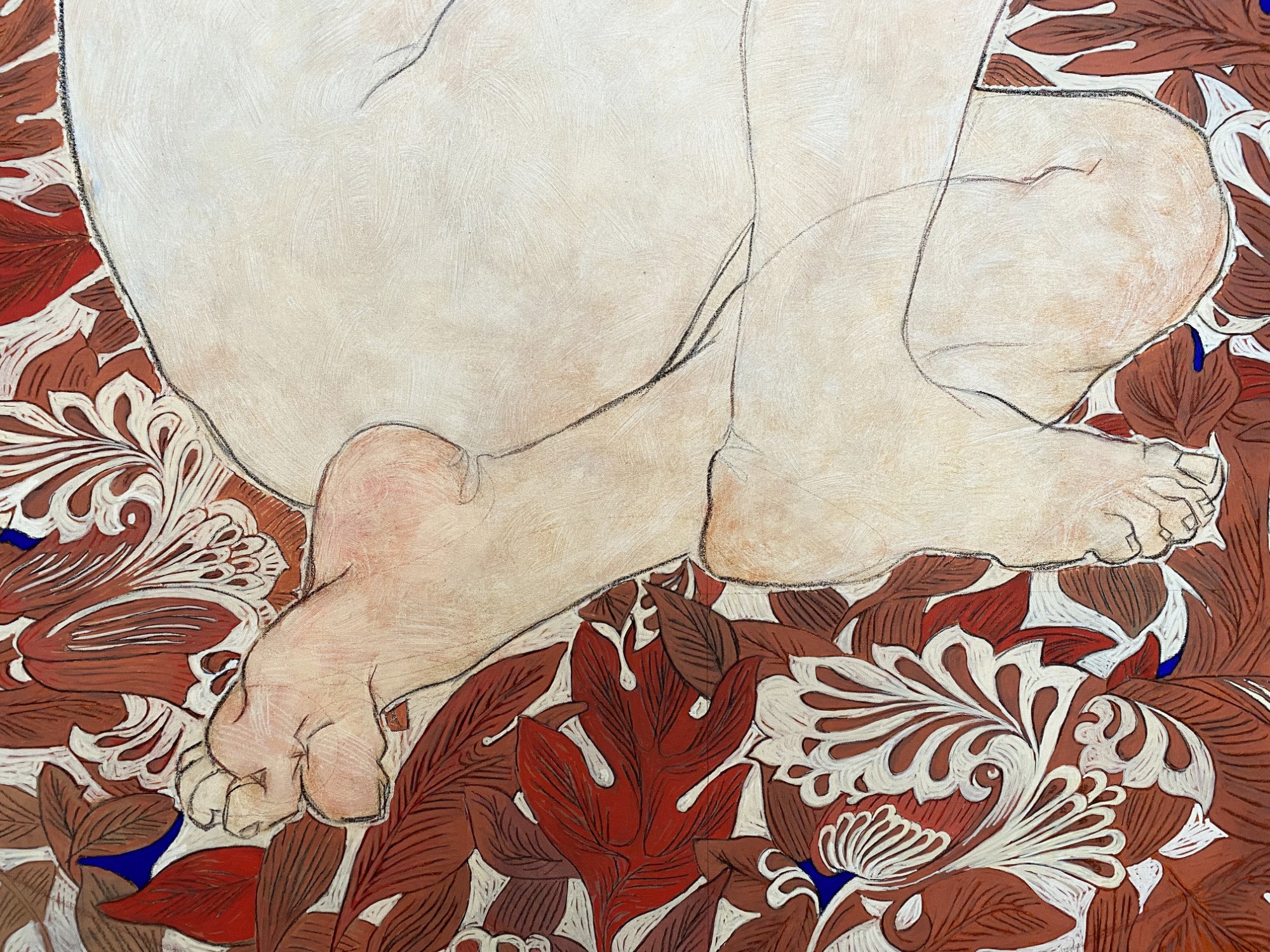
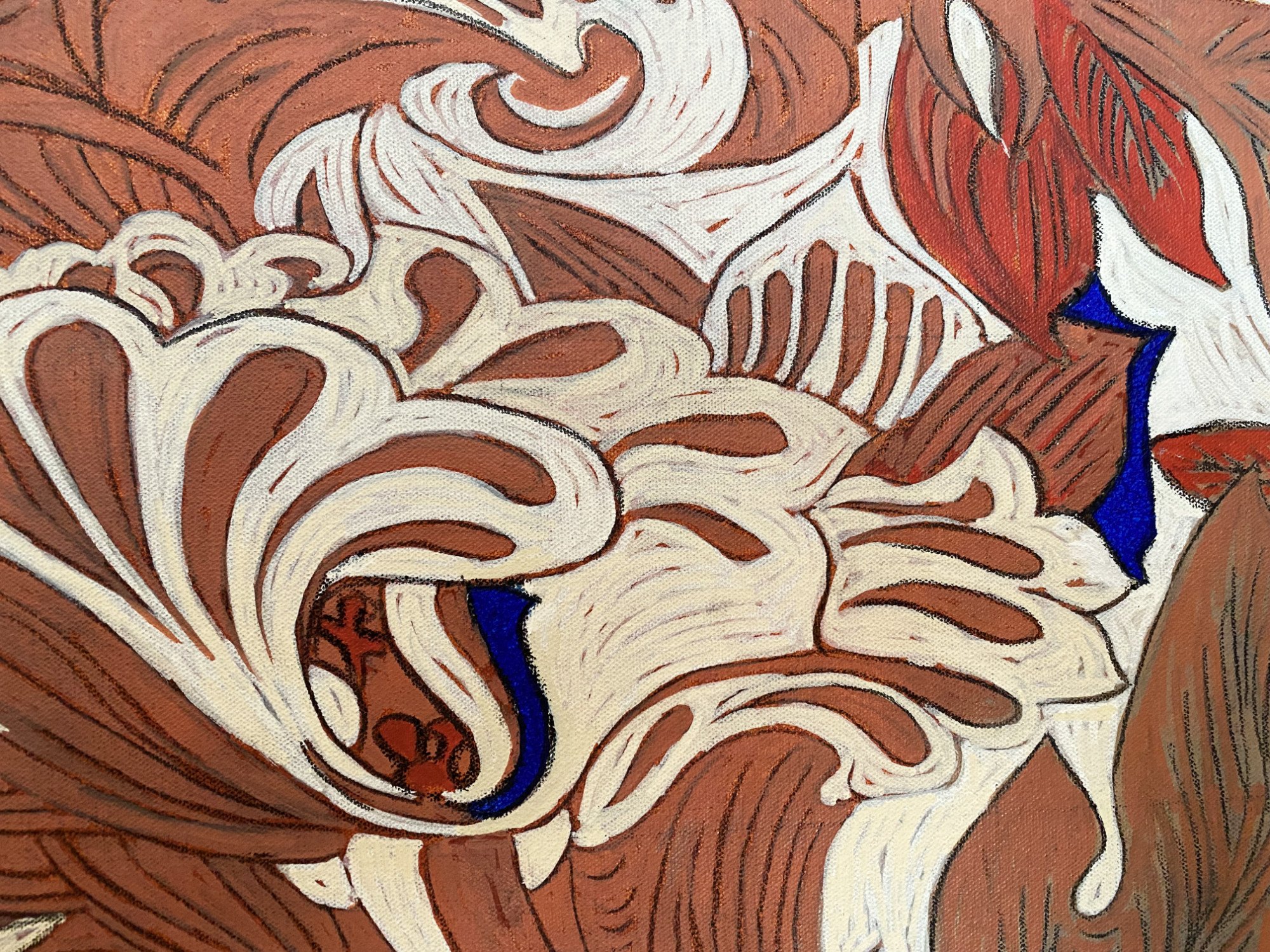
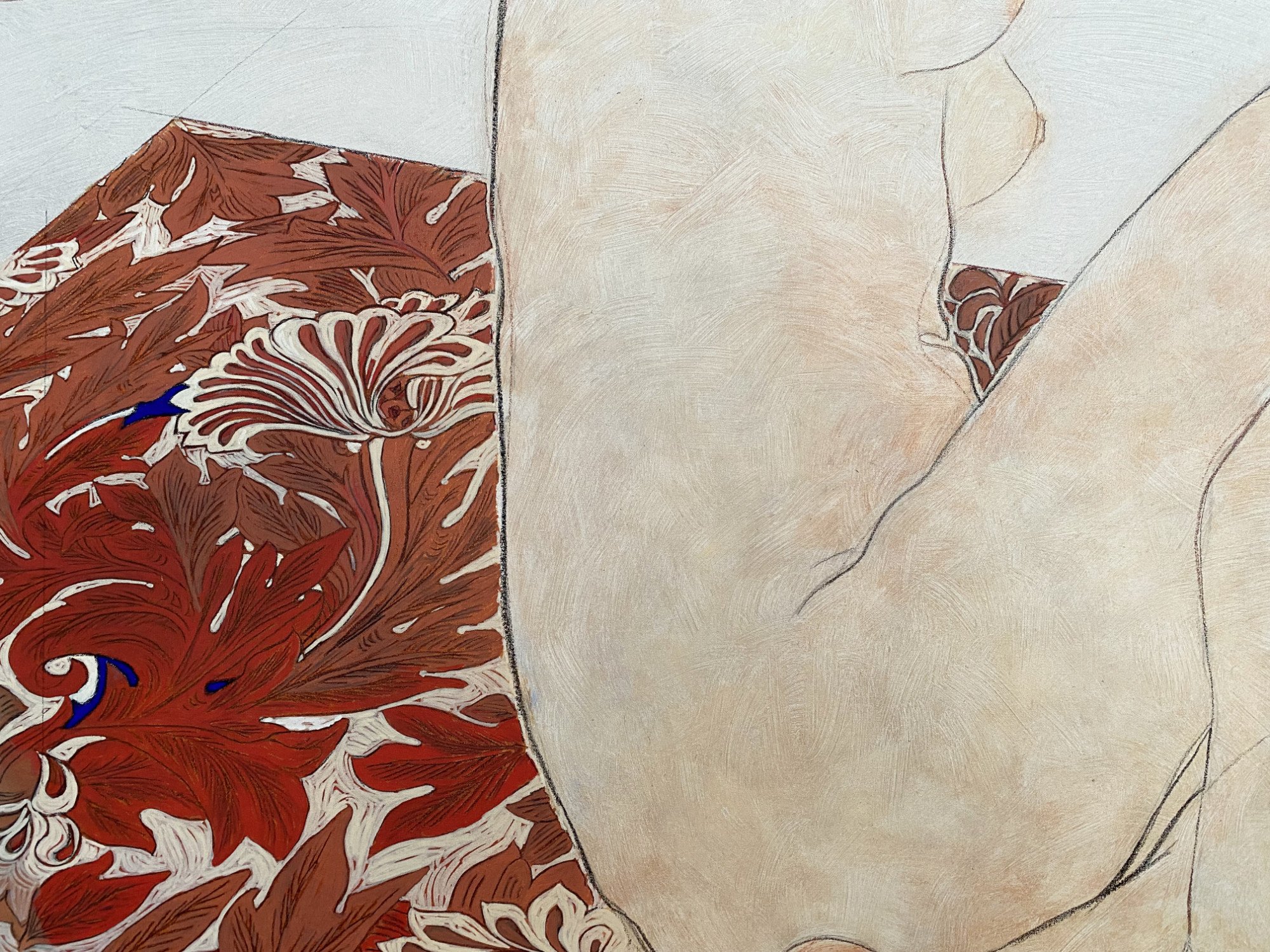
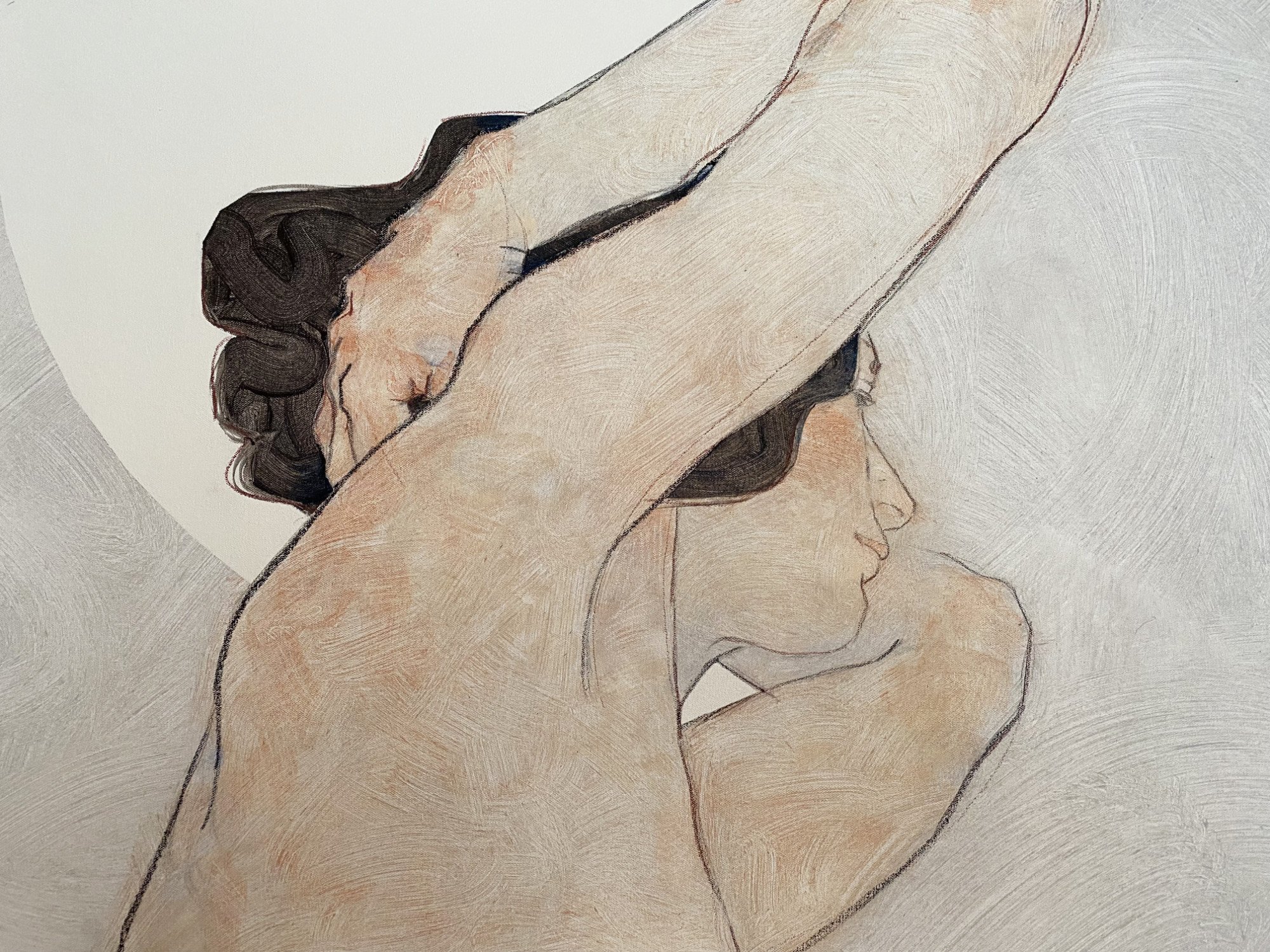
“(i)”
”I know a little garden-close
Set thick with lily and red rose,
Where I would wander if I might
And have one with me wandering.
”And though within it no birds sing,
And though no pillared house is there,
And though the apple boughs are bare
Of fruit and blossom, would to God,
Her feet upon the green grass trod,
And I beheld them as before.
”There comes a murmur from the shore,
And in the place two fair streams are,
Drawn from the purple hills afar,
Drawn down unto the restless sea,
The hills whose flowers ne’er fed the bee,
The shore no ship has ever seen,
Still beaten by the billows green,
Whose murmur comes unceasingly
Unto the place for which I cry.
”For which I cry both day and night,
For which I let slip all delight,
That maketh me both deaf and blind,
Creless to win, unskilled to find,
And quick to lose what all men seek.
”Yet tottering as I am and weak,
Still have I left a little breath
To seek within the jaws of death
An entrance to that happy place,
To seek the unforgotten face
Once seen, once kissed, once reft from me
Anigh the murmuring of the sea.”
GARDENIA - 147 x 177 CM


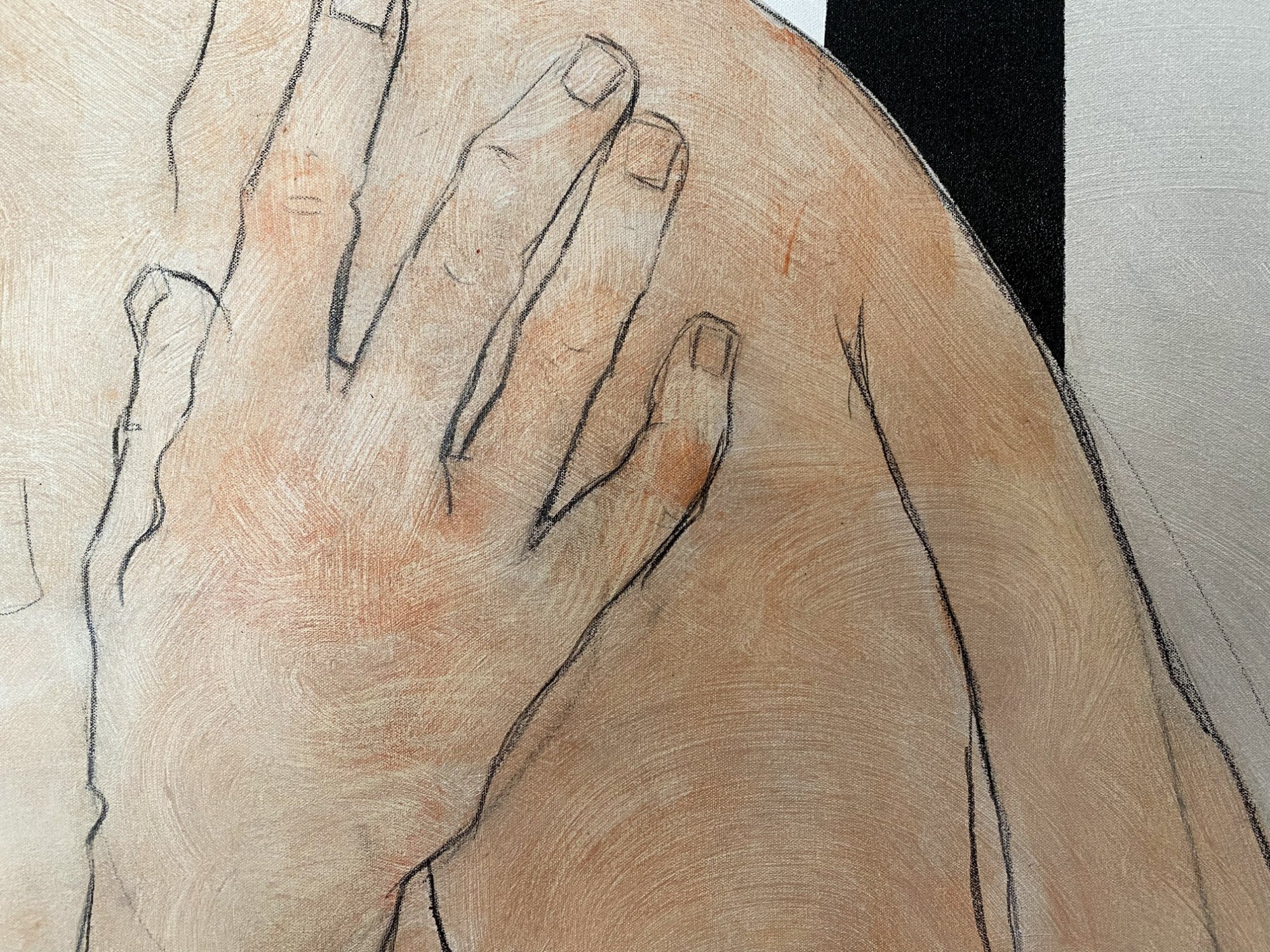
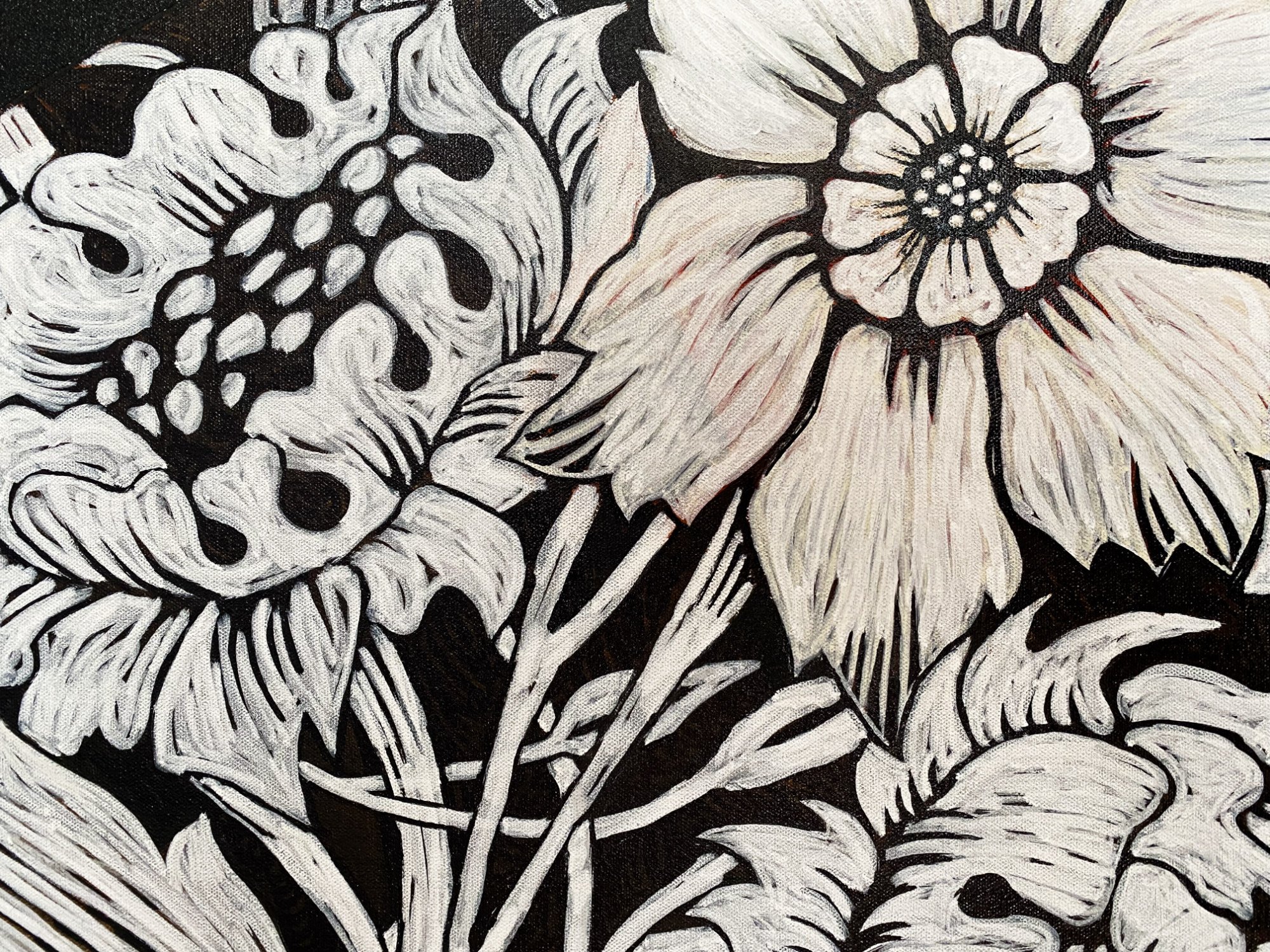
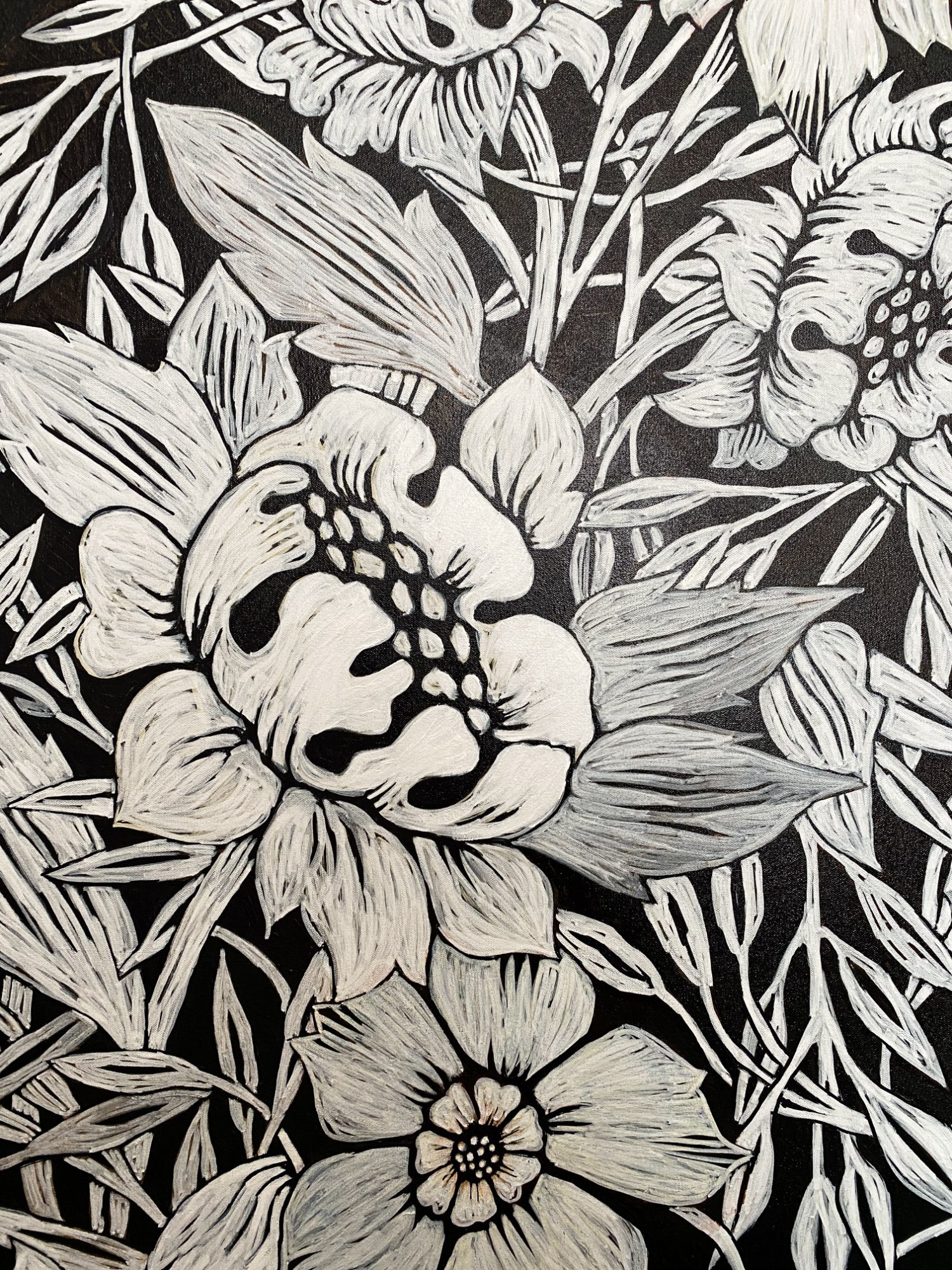
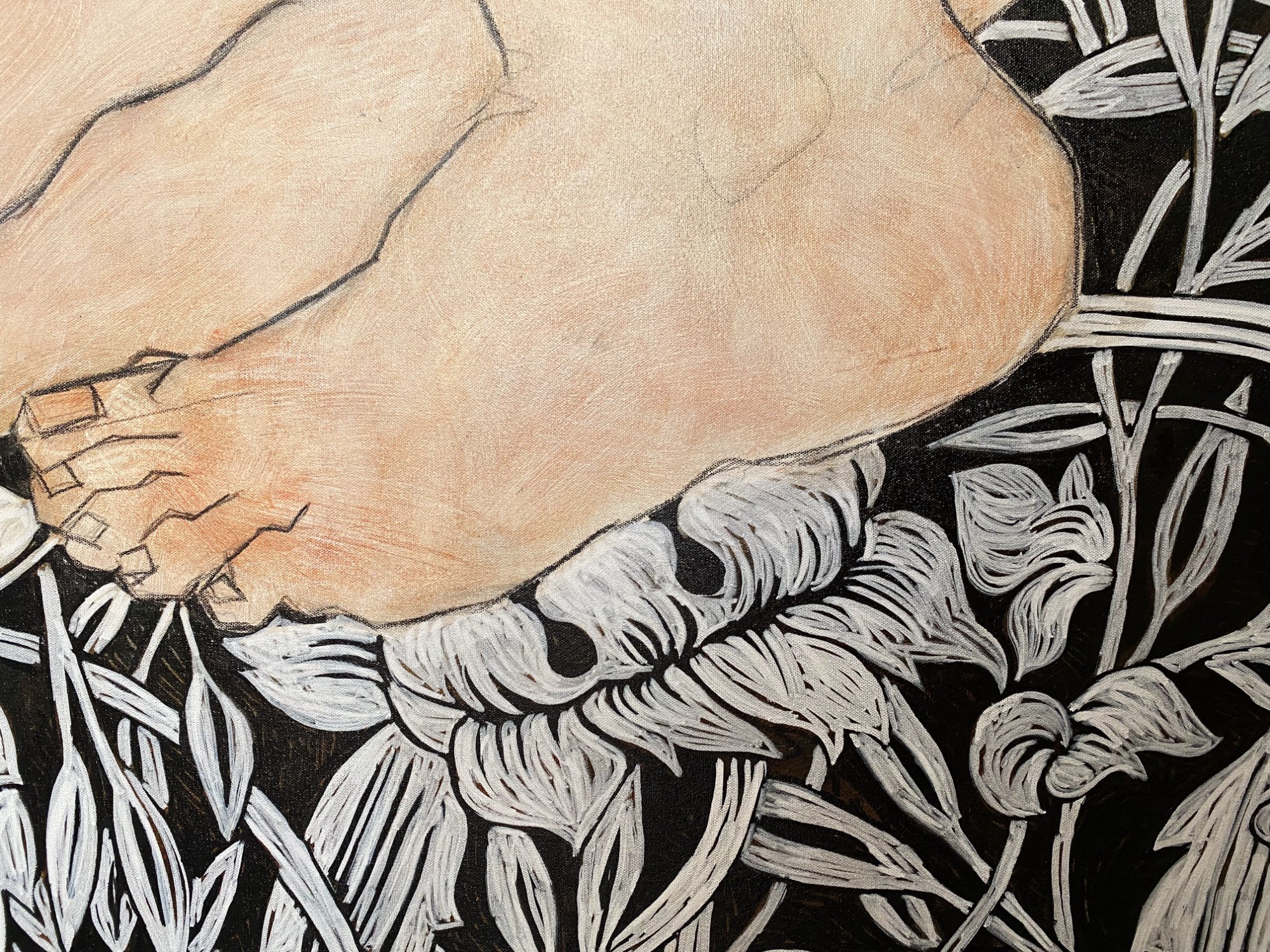

“OCTOBER”
O, love, turn from the unchanging sea, and gaze
Down these grey slopes upon the year grown old,
A-dying mid the autumn-scented haze,
That hangeth o’er that hollow in the wold,Where the wind-bitten ancient elms enfold
Grey church, long barn, orchard, and red-roofed stead,
Wrought in dead days for men a long while dead.
Come down, O love; may not our hands still meet,
Since still we live to-day, forgetting June,
Forgetting May, deeming October sweet -
- O hearken, hearken! through the afternoon,
The grey tower sings a strange old tinkling tune!
Sweet, sweet, and sad, the toiling year’s last breath,
Too satiate to life to strive with death.
And we too - will it not be soft and kind,
That rest from life, from patience and from pain,
That rest from bliss we know not when we find,
That rest from Love which ne’er the end can gain? -
- Hark, how the tune swells, that erewhile did wane!
Look up, love! - ah, cling close and never move!
How can I have enough of life and love?”
ROSEA - 96 x 192 CM
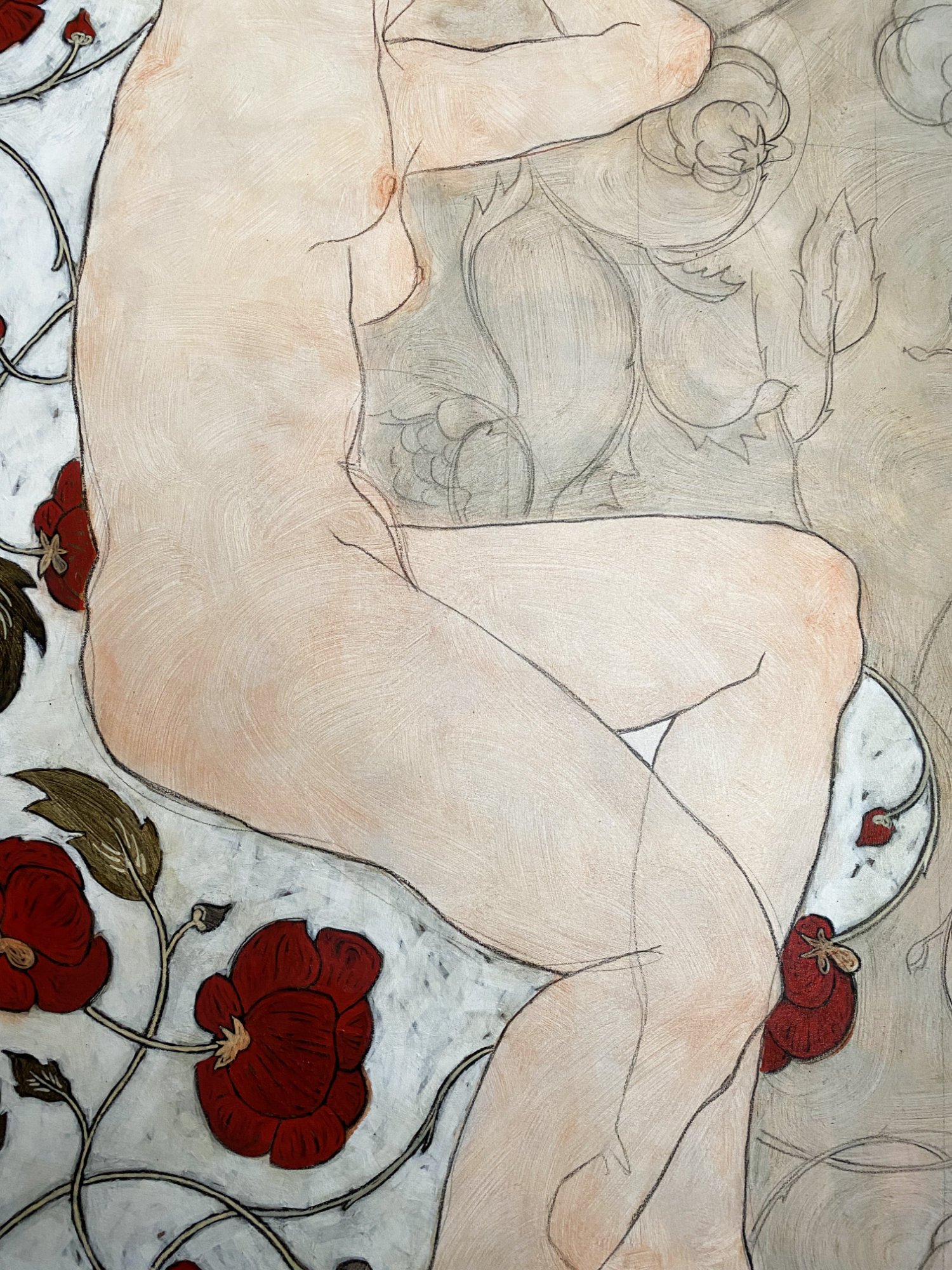
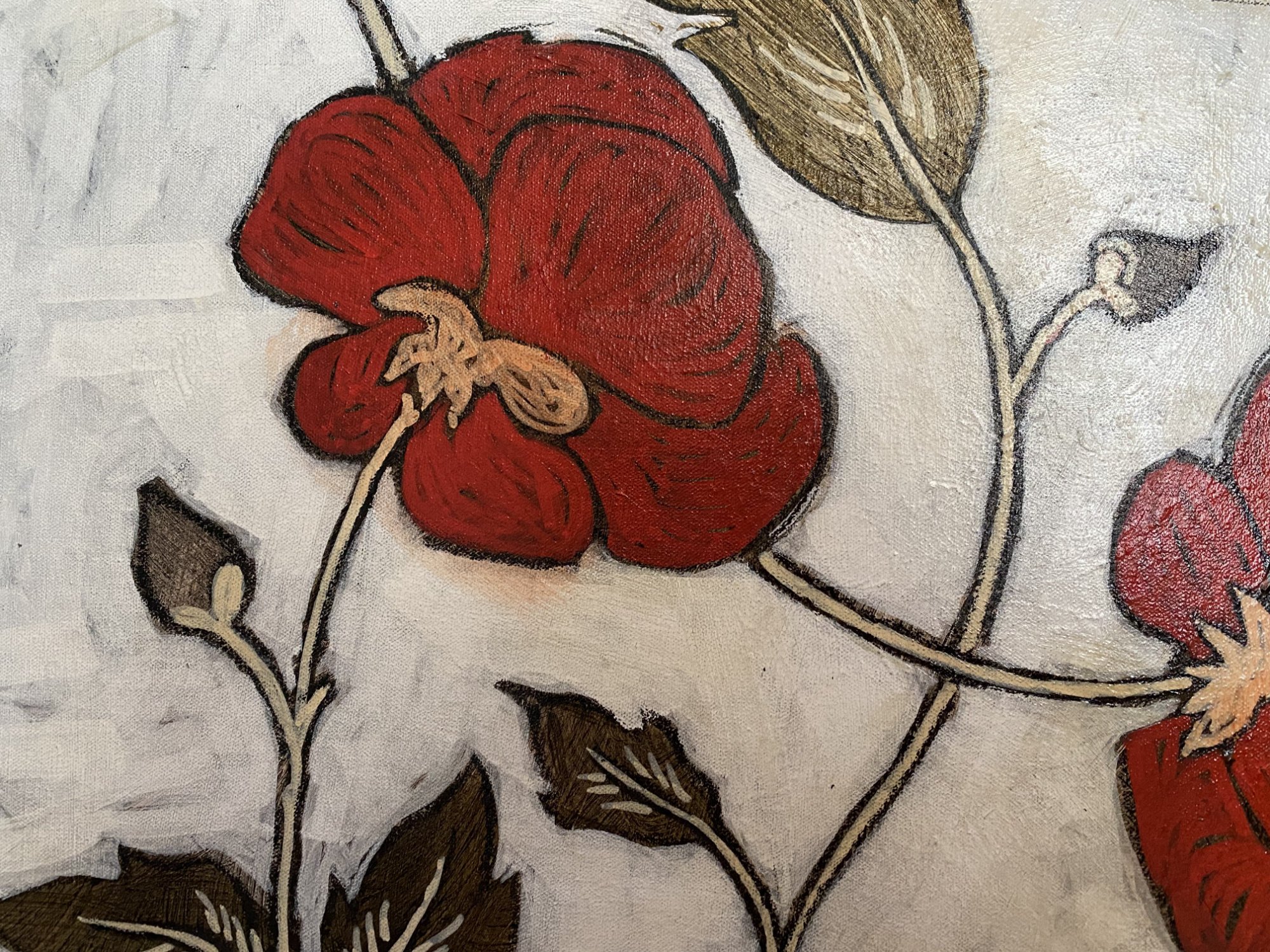
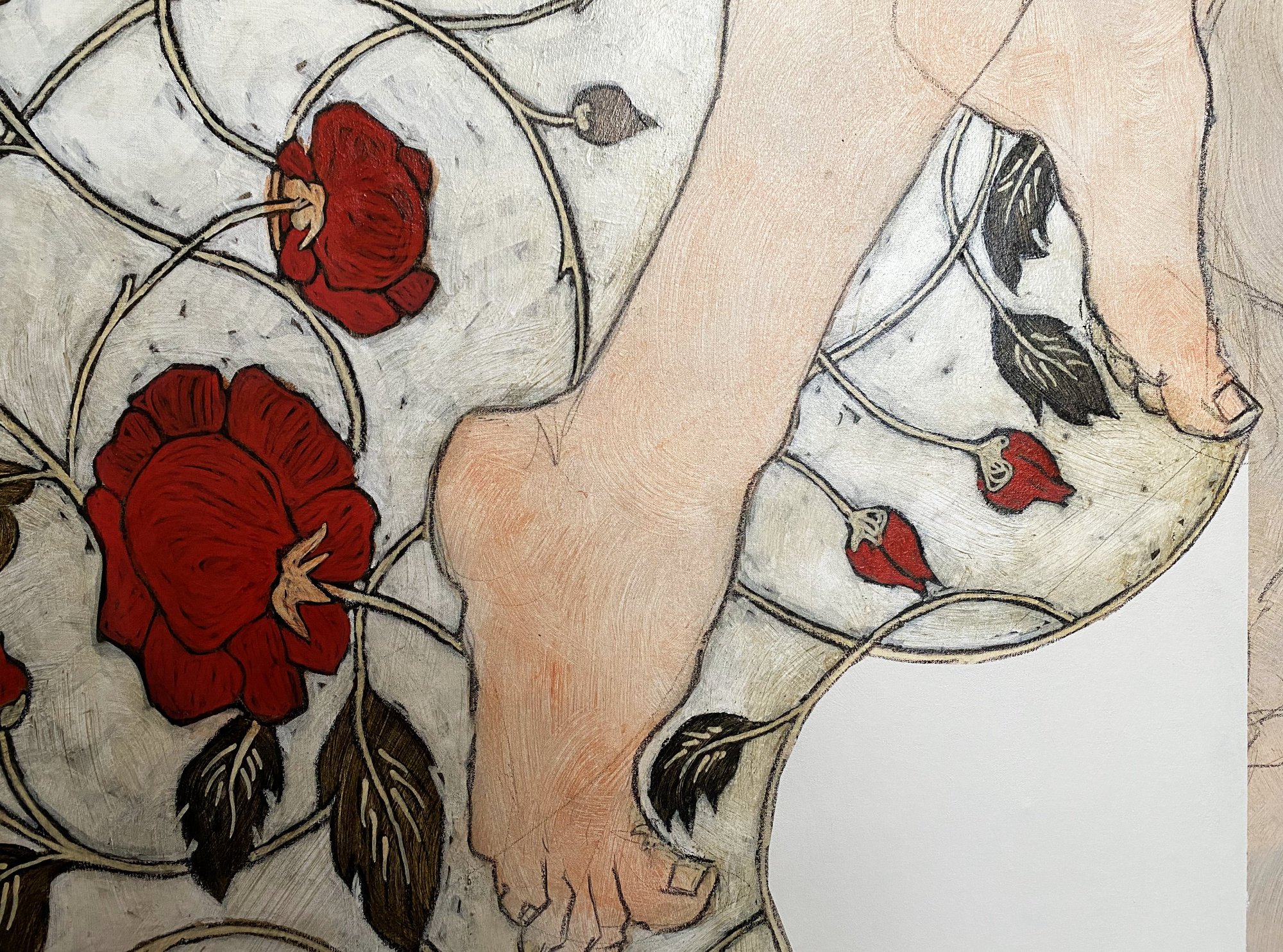
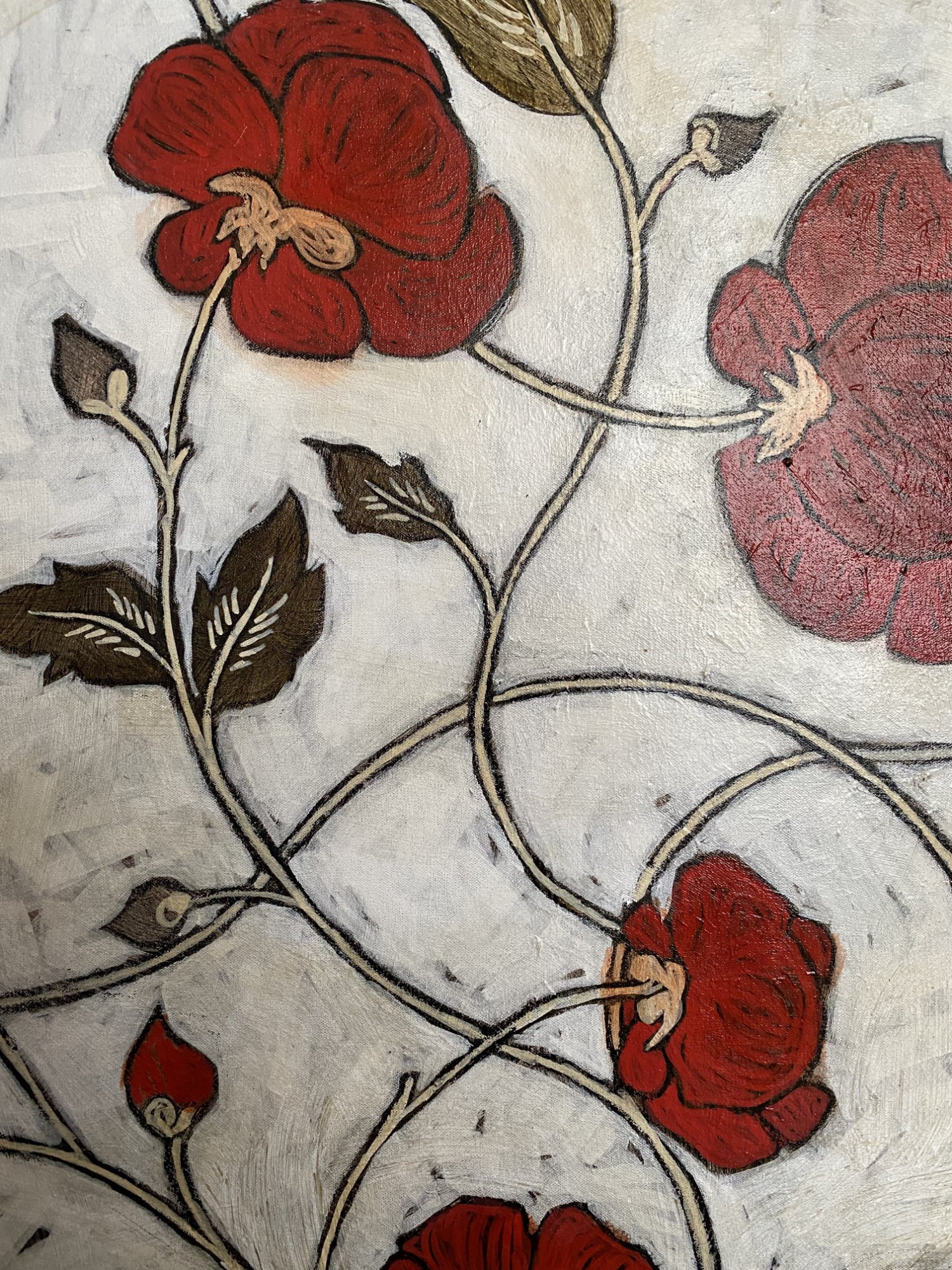

“APRIL”
O fair midspring, besung so oft and oft,
How can I praise thy loveliness enow?
Thy sun that burns not, and thy breezes soft
That o’er the blossoms of the orchard blow,
The thousand things that ‘ neath the young leaves grow,
The hopes and changes of the growing year,
Winter forgotten long, and summer near.
When Summer brings the lily and the rose,
She brings us fear; her very death she brings
Hid in her anxious heart, the forge of woes;
And, dull with fear, no more the mavis sings.
But thou! thou diest not, but thy fresh life clings
About the fainting autumn’s sweet decay,
When in the earth the hopeful seed they lay.
Ah! life of all the year, why yet do I
Amid thy snowy blossoms’ fragrant drift,
Still long for that which never draweth nigh,
Striving my pleasure from my pain to sift,
Some weight from off my fluttering mirth to life?
Now, when far bells are ringing, “Come again,
Come back, past years! Why will ye pass in vain?”
IGNEA - 118 x 180 CM

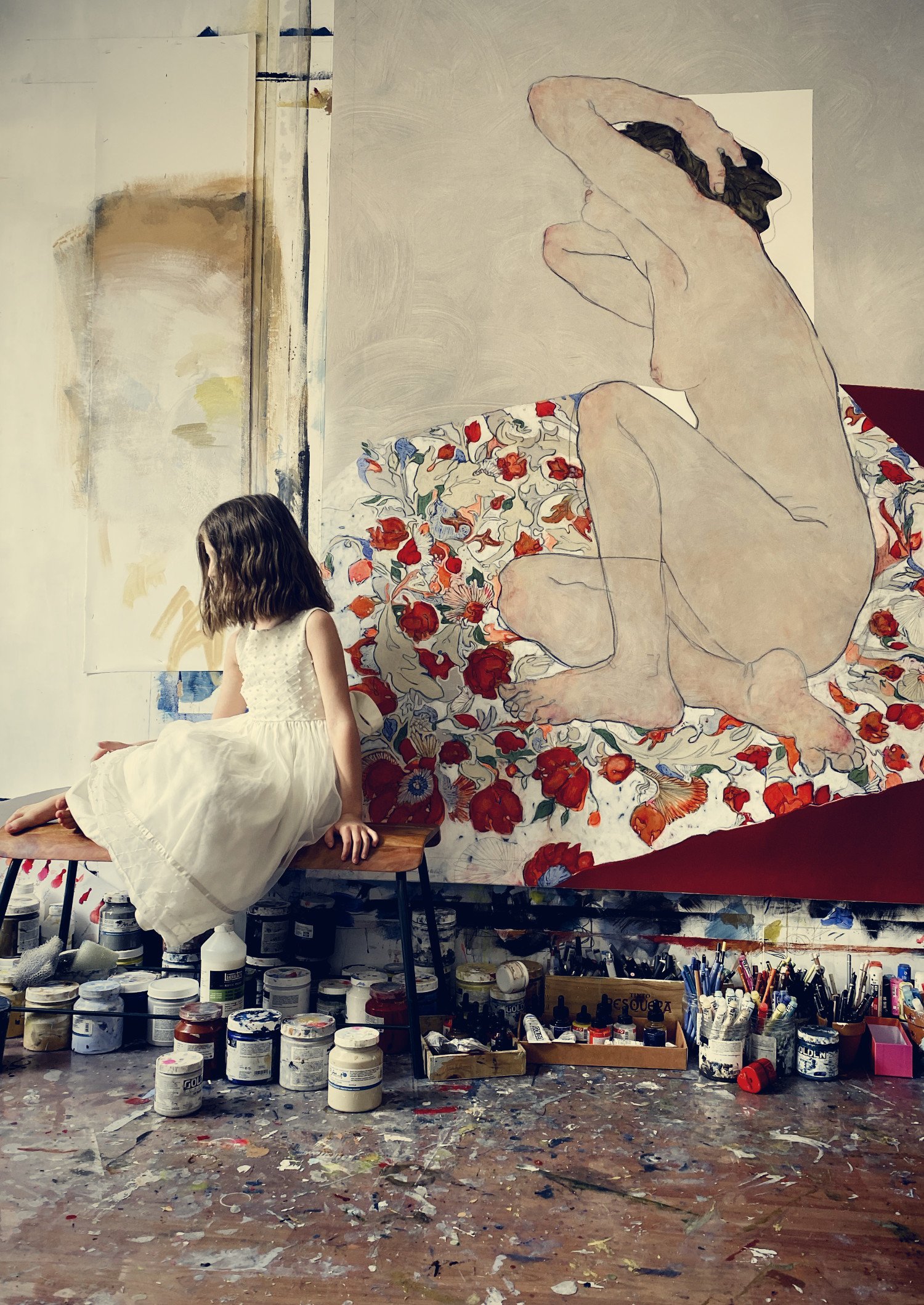
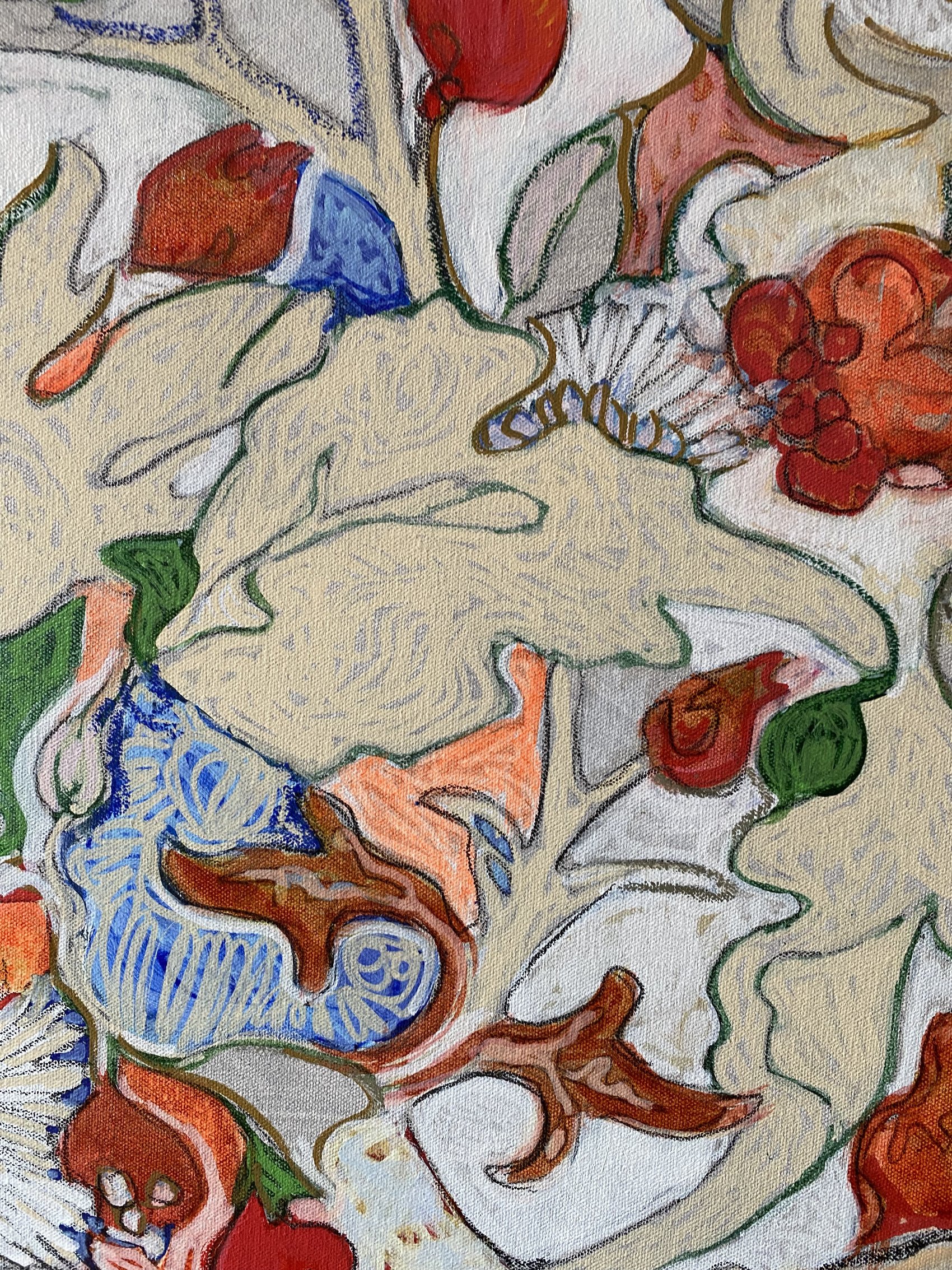
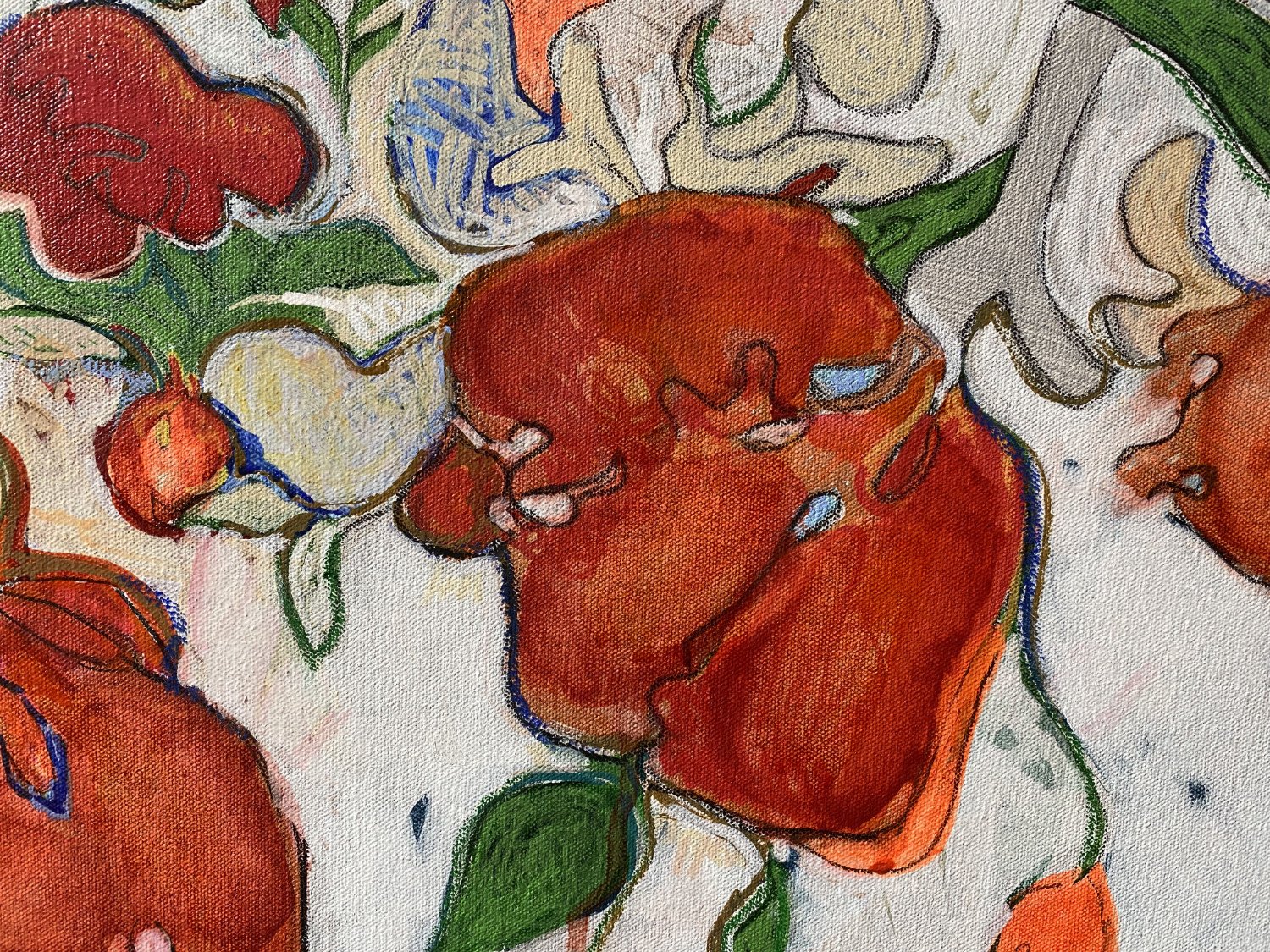
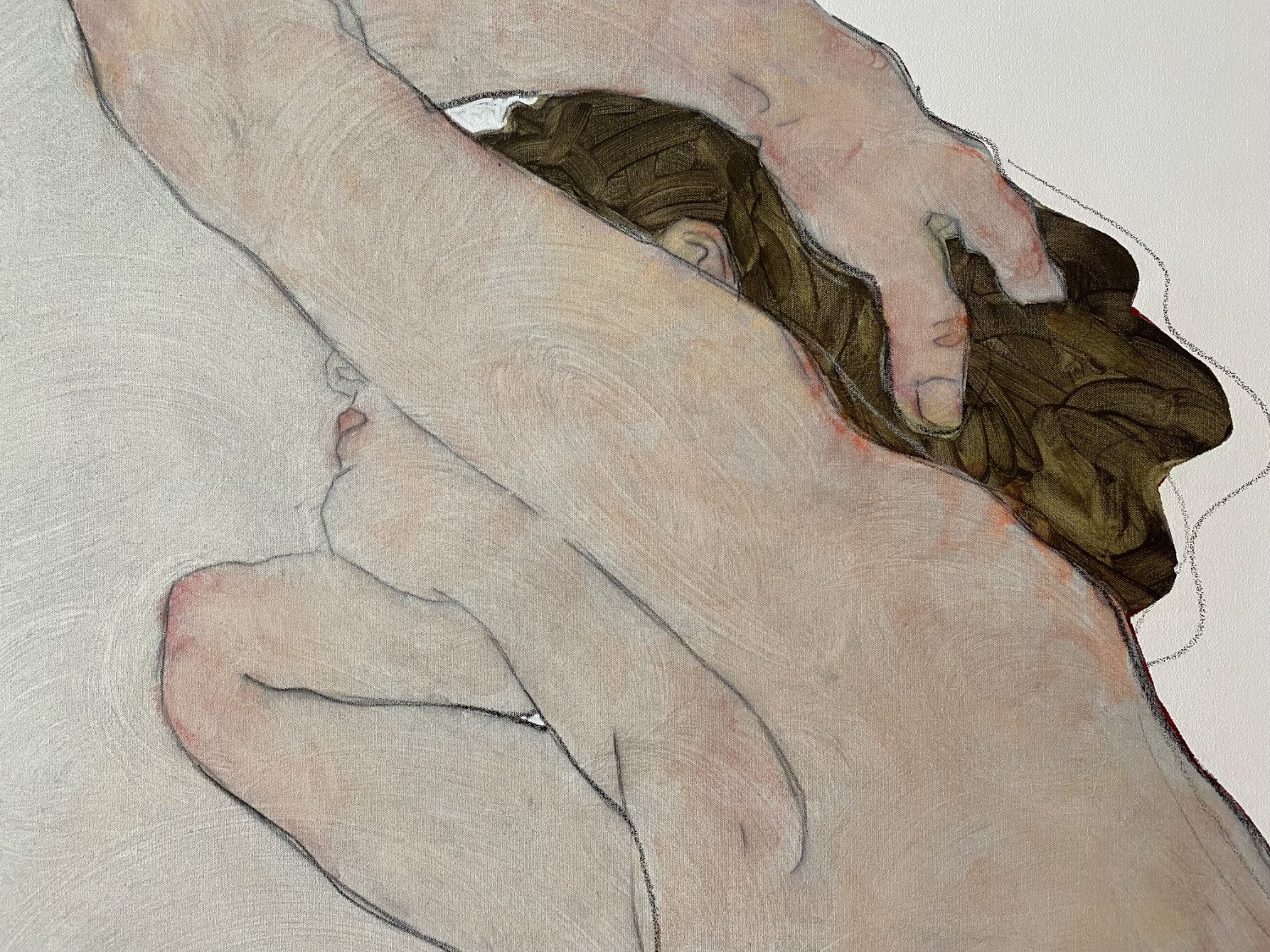


“SPRING’S BEDFELLOW”
Spring went about the woods to-day,
The soft-foot winter-thief,
And found where idle sorrow lay
’Twixt flower and faded leaf.
She looked on him, and found him fair
For all she had been told;
She knelt adown beside him there,
And sang of days of old.
His open eyes beheld her nought,
Yet ’gan his lips to move;
But life and deeds were in her thought,
And he would sing of love.
So sang they till their eyes did meet,
And faded fear and shame;
More bold he grew, and she more sweet,
Until they sang the same.
Until, say they who know the thing,
Their very lips did kiss,
And Sorrow laid abed with Spring
Begat an earthly bliss.”
CYANEA - 121 cm x 155 CM


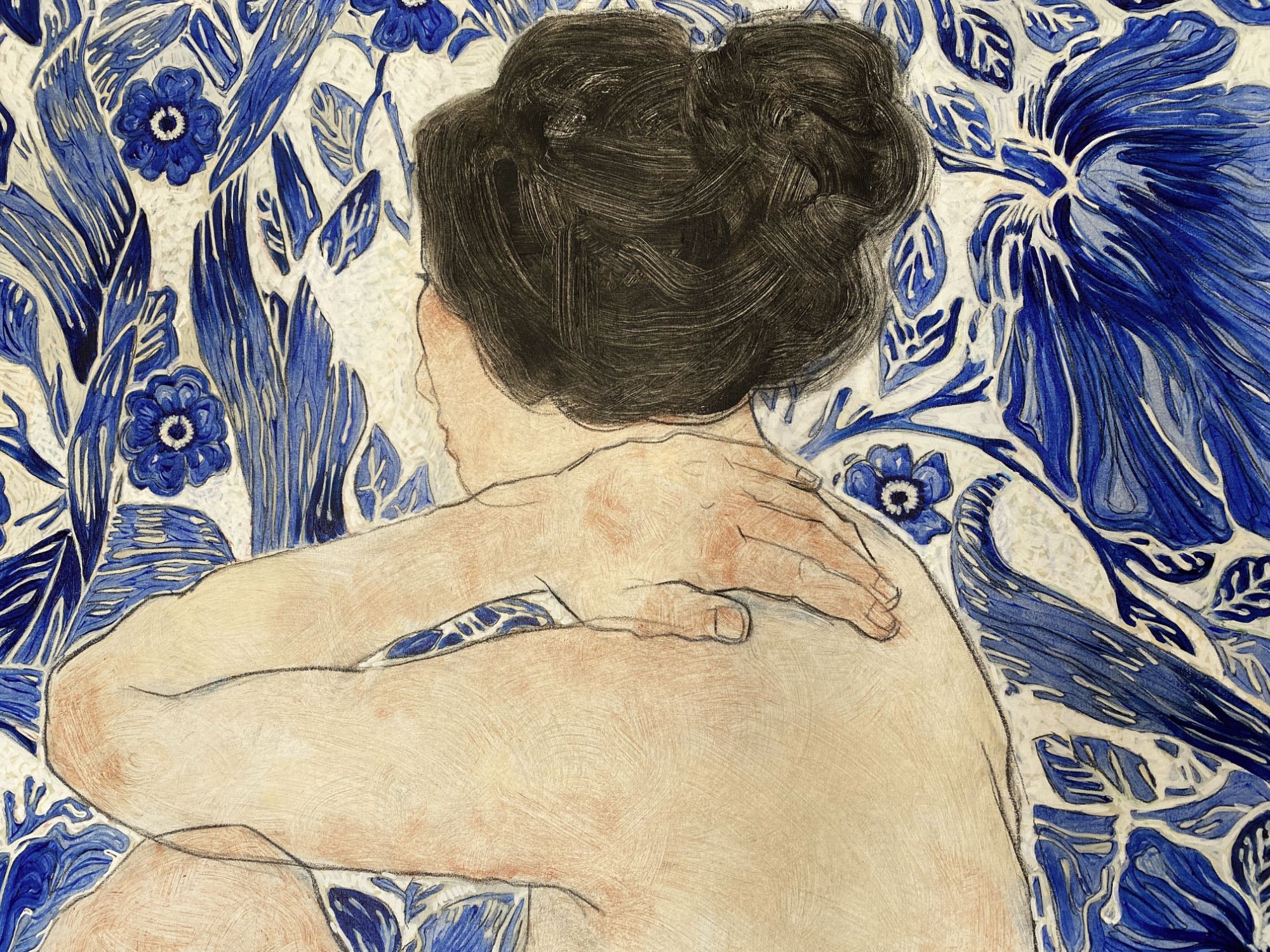
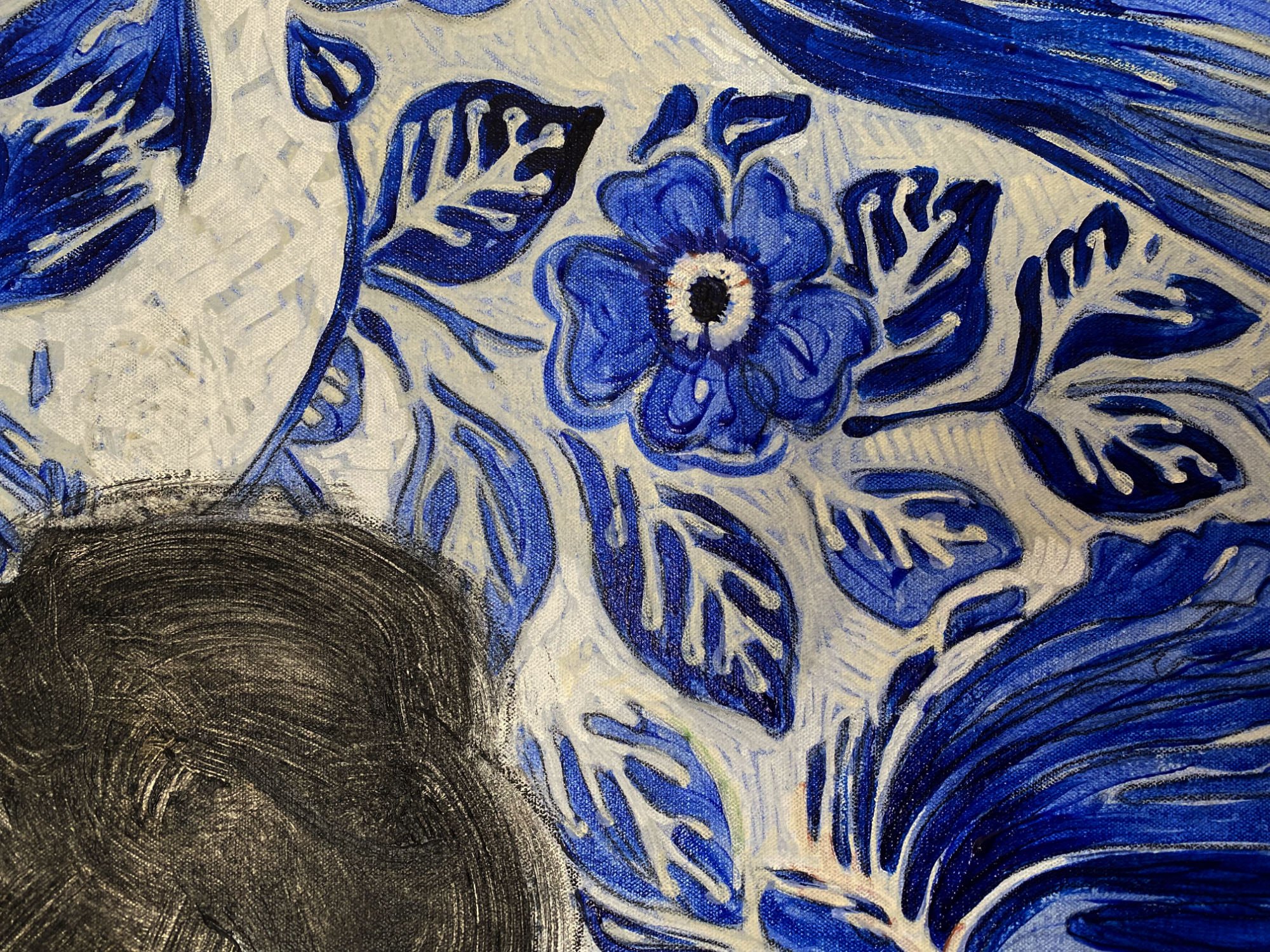
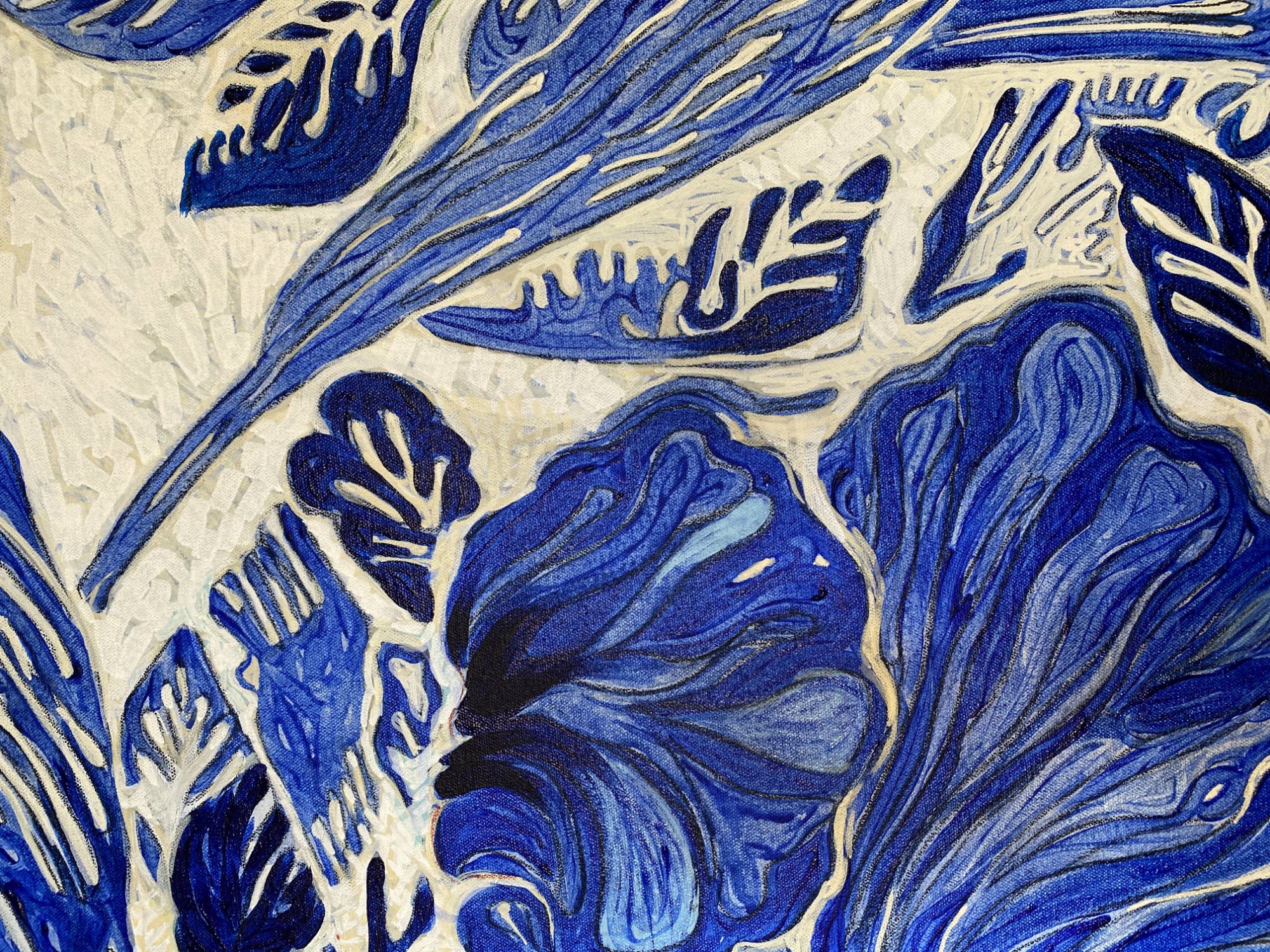
“THE WIND”
...
So I will sit and think of love that is over and past,
O! so long ago - yes, I will be quiet at last;
Whether I like it or not, a grim half-slumber is cast
Over my worn old brains, that toughes the roots of my heart,
And above my half-shut eyes the blue roof ‘ gins to part,
And show rgw blue spring sky, till I am ready to start
From out of the green-hung chair; but something keeps me still,
And I fall in a dream that Iwalk’d with her on the side of a hill,
Dotted - for was it not spring? - with tufts of the daffodil.
Wind, wing ! thou art sad, art thou kind?
Wind, wind, unhappy! thou art blind,
Yet still thou wanderest the lily-seed to find.
And Margaret as she walk’d held a painted book in her hand;
Her finger kept the place; I caught her, we both did stand
Face to face, on top of the highest him in the land.
Wind, wing ! thou art sad, art thou kind?
Wind, wind, unhappy! thou art blind,
Yet still thou wanderest the lily-seed to find.
I held to her long bare arms, but she shudder’d away from me,
While the flush went out of her face as her head fell back on a tree,
And a spasm caught her mouth, fearful for me to see;
And still I held to her arms till her shoulder touch’d my mail,
Weeping she totter’d forward, so glad that I should prevail,
And her hair went over my robe, like a gold flag over a sail.
Wind, wing ! thou art sad, art thou kind?
Wind, wind, unhappy! thou art blind,
Yet still thou wanderest the lily-seed to find.”
COERULEUS - 118 x 163 CM
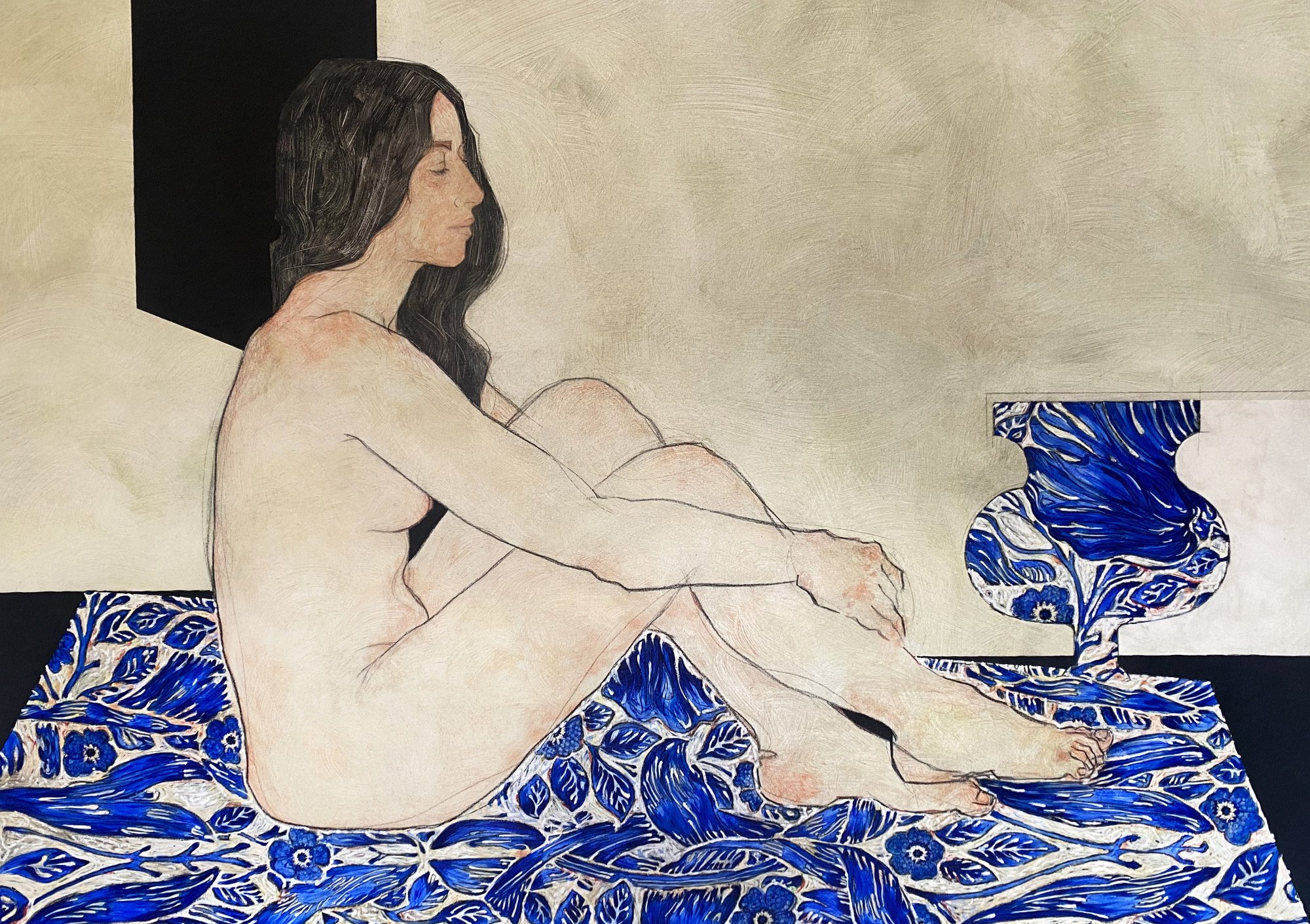

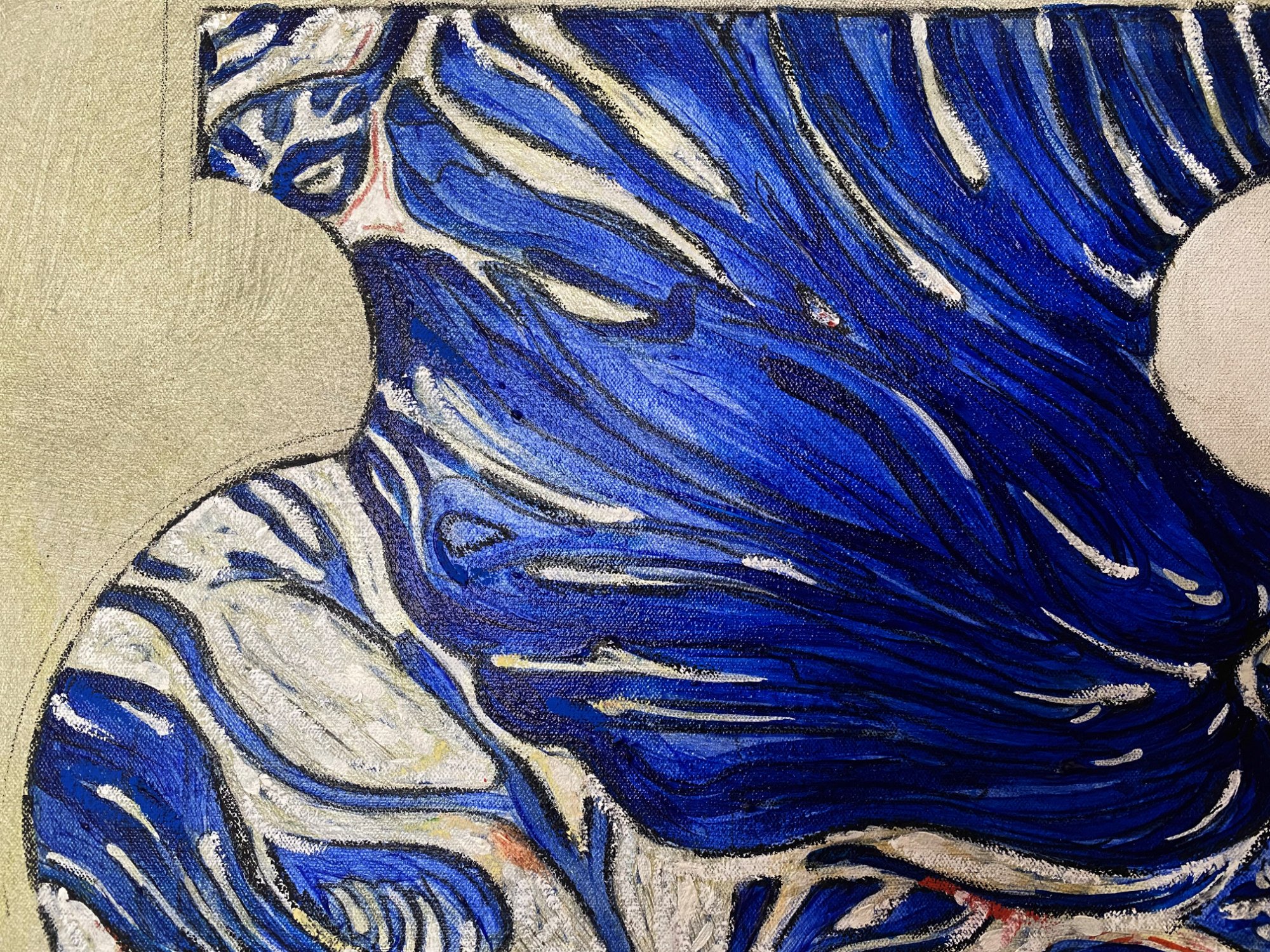

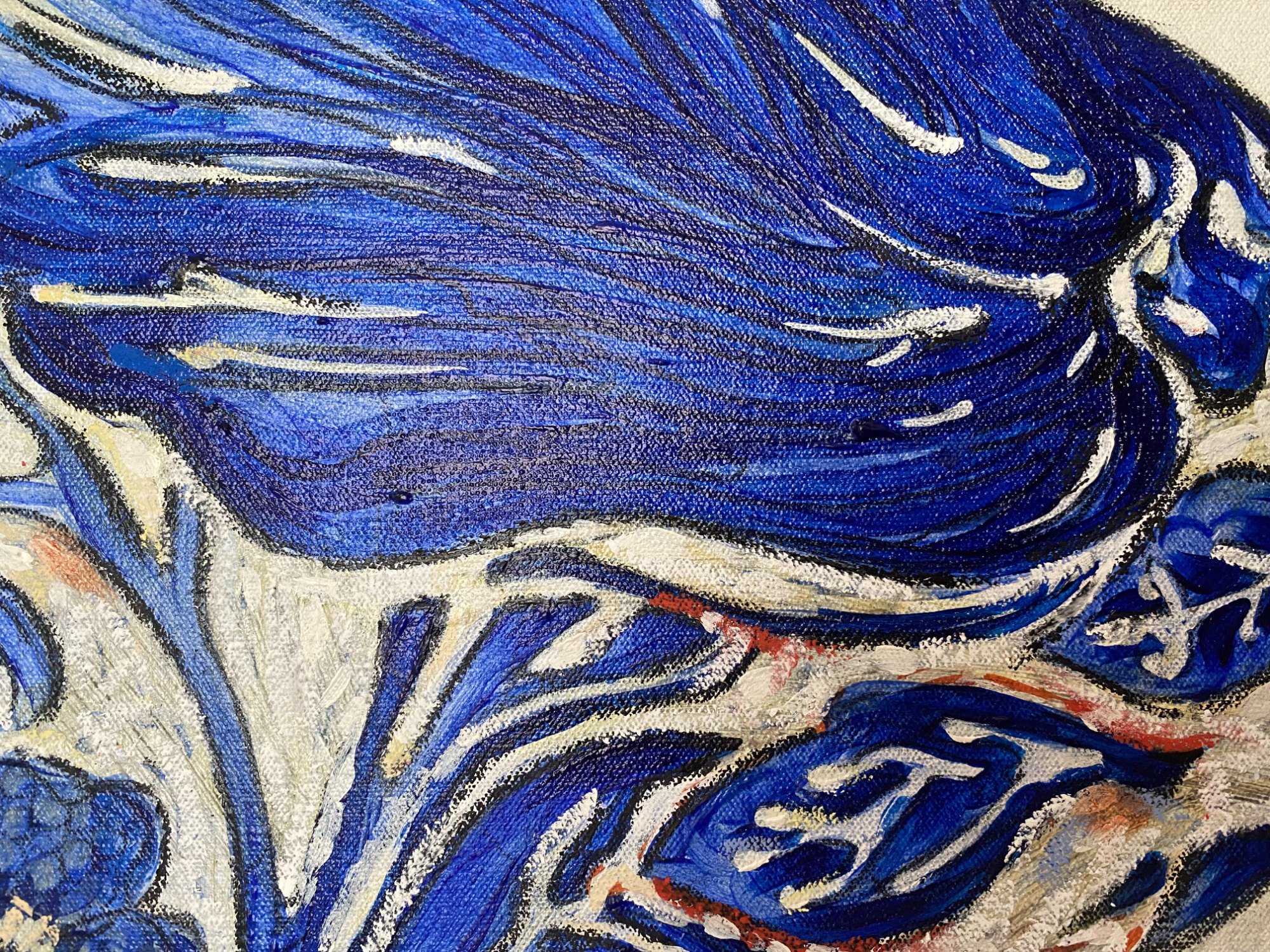
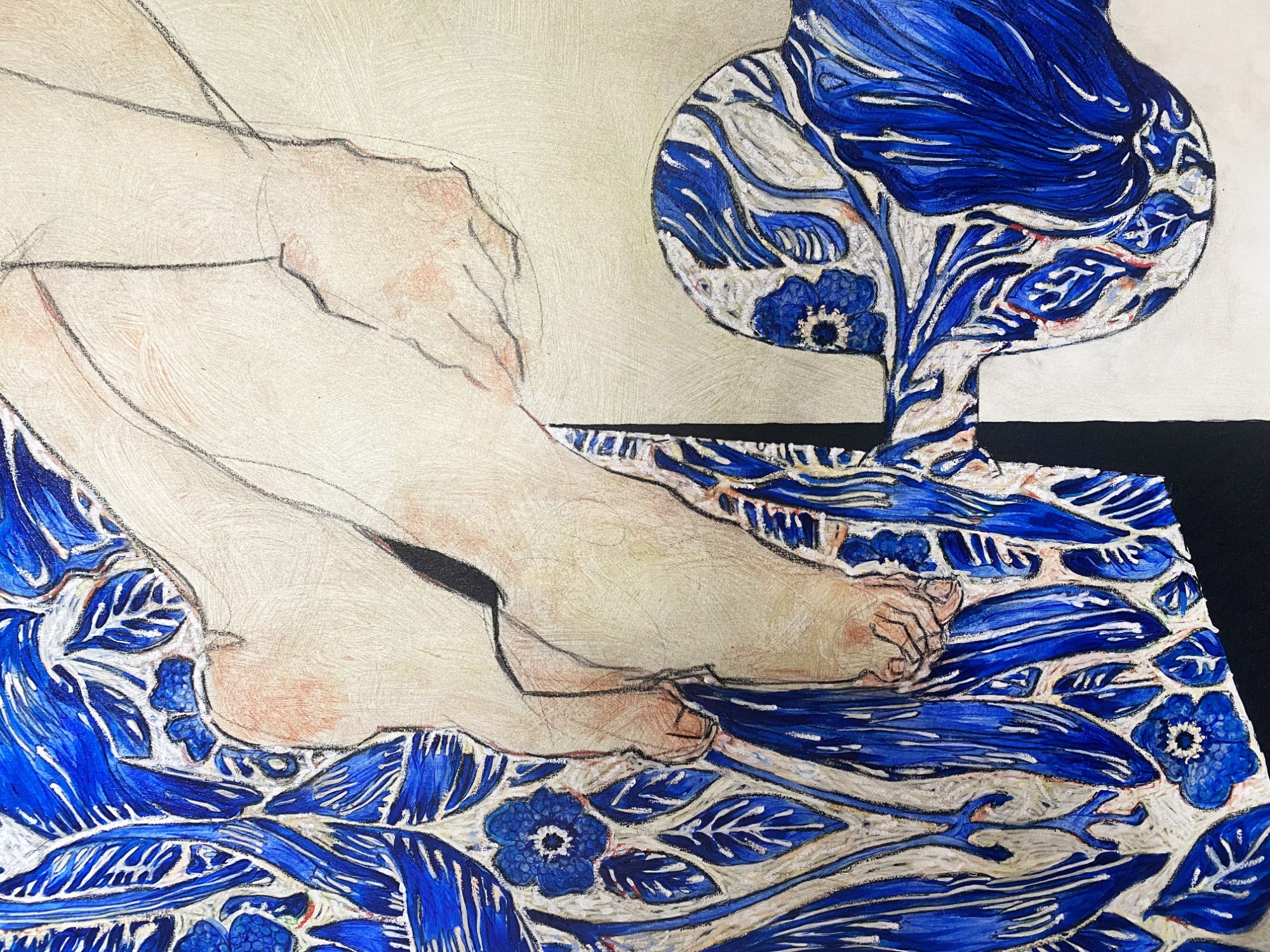
“PRAISE OF MY LADY”
My lady seems of ivory
Forehead, straight nose, and cheeks that be
Hollow’d a little mournfully.
Beata mea Domina!
Her forehead, overshadow’d much
By bows of hair, has a wave such
As God was good to make for me.
Beata mea Domina!
Not greatly long my lady’s hair,
Nor yet with yellow colour fair,
But thick and crisped wonderfully:
Beata mea Domina!
Heavy to make the pale face sad,
And dark, but dead as though it had
Been forged by God most wonderfully
Beata mea Domina!
Of some strange metal, thread by thread,
To stand out from my lady’s head,
Not moving much to tangle me.
Beata mea Domina!
Beneath fer brows the lids fall slow,
The lashes a clear shadow throw
Where I would wish my lips to be.
Beata mea Domina!
Her great eyes, standing far apart,
Draw up some memory from her heart,
And gaze out very mournfully;
Beata mea Domina!”
CAERULESCENS - 130 x 183 CM

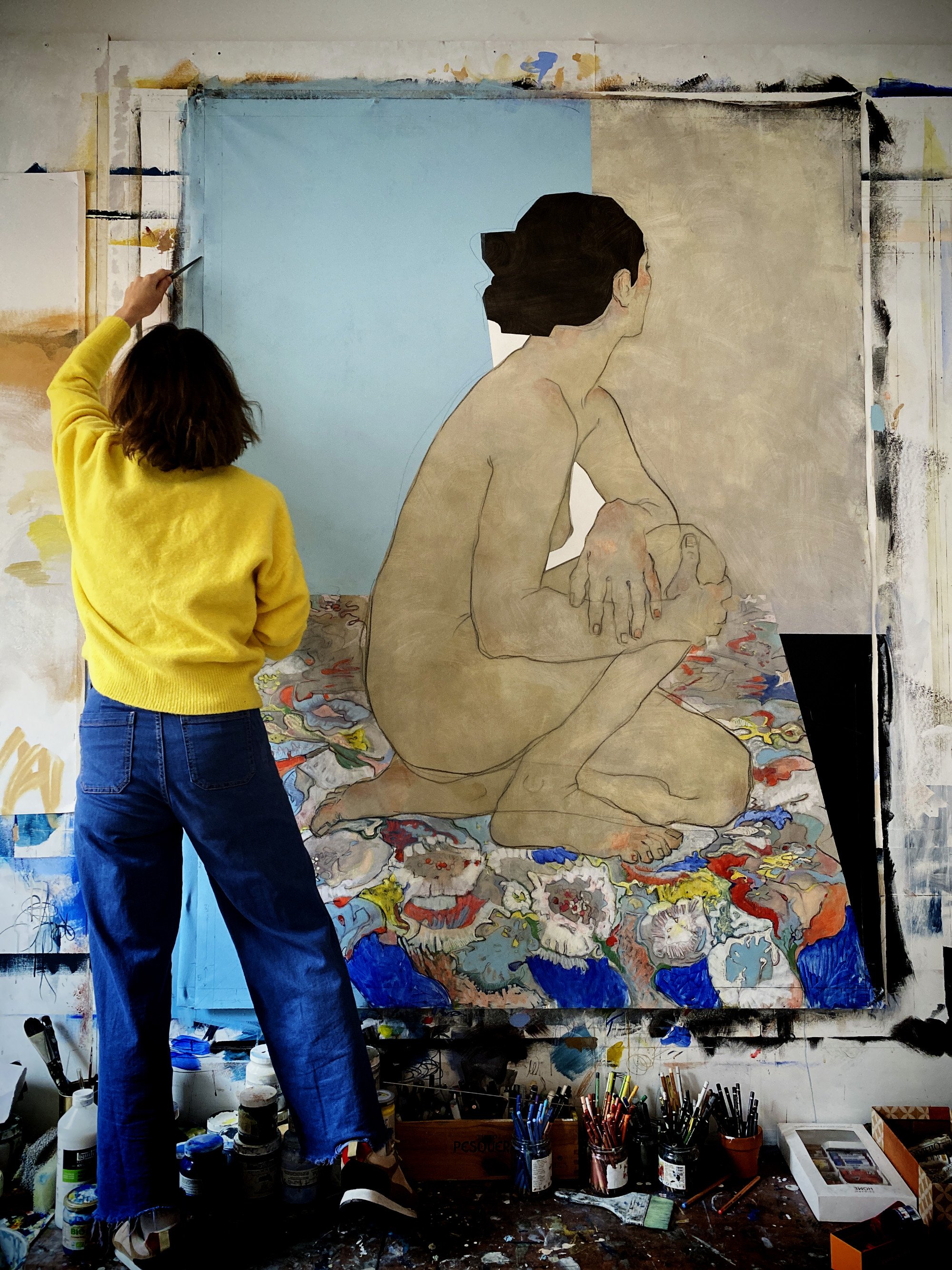
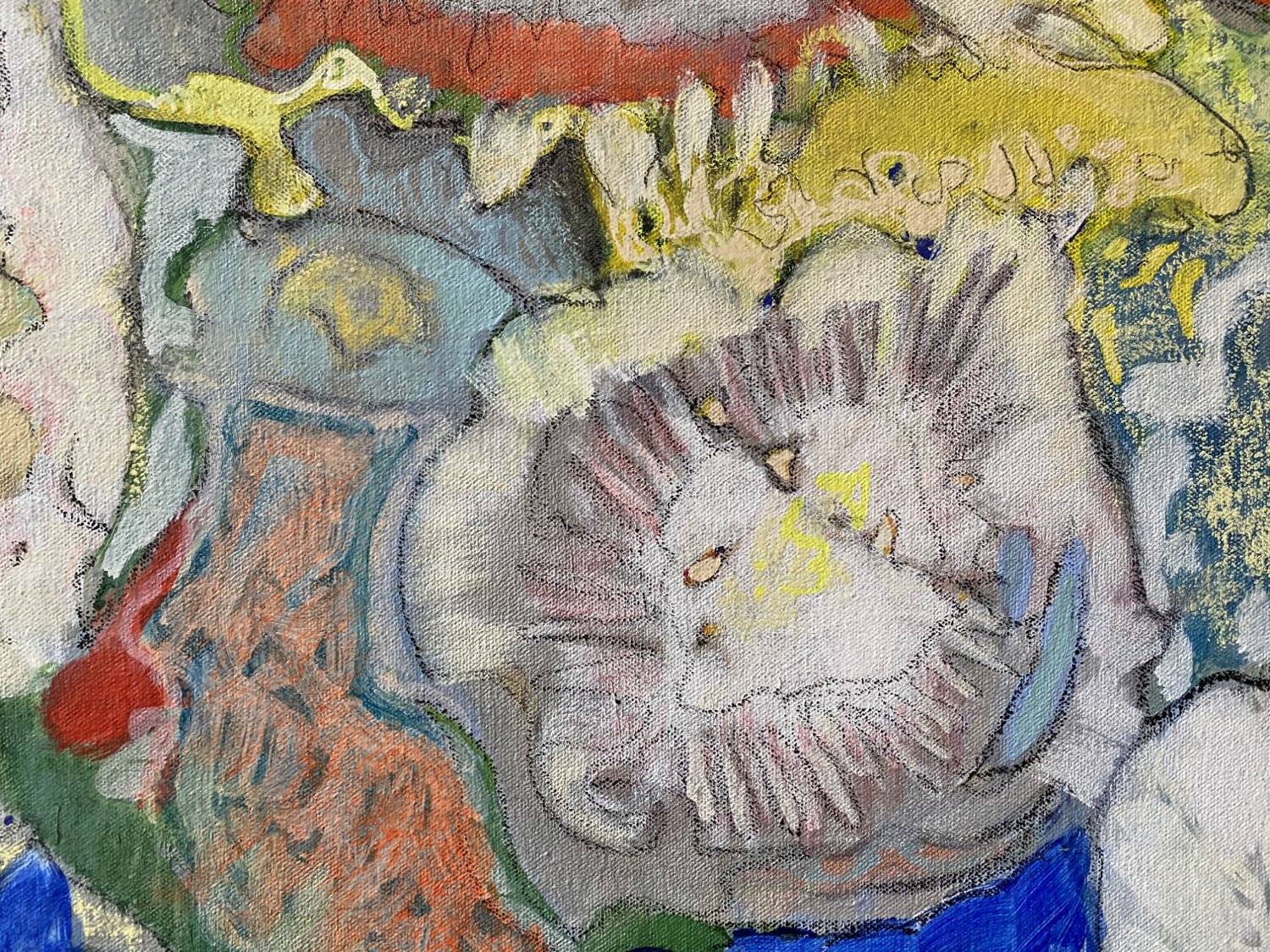
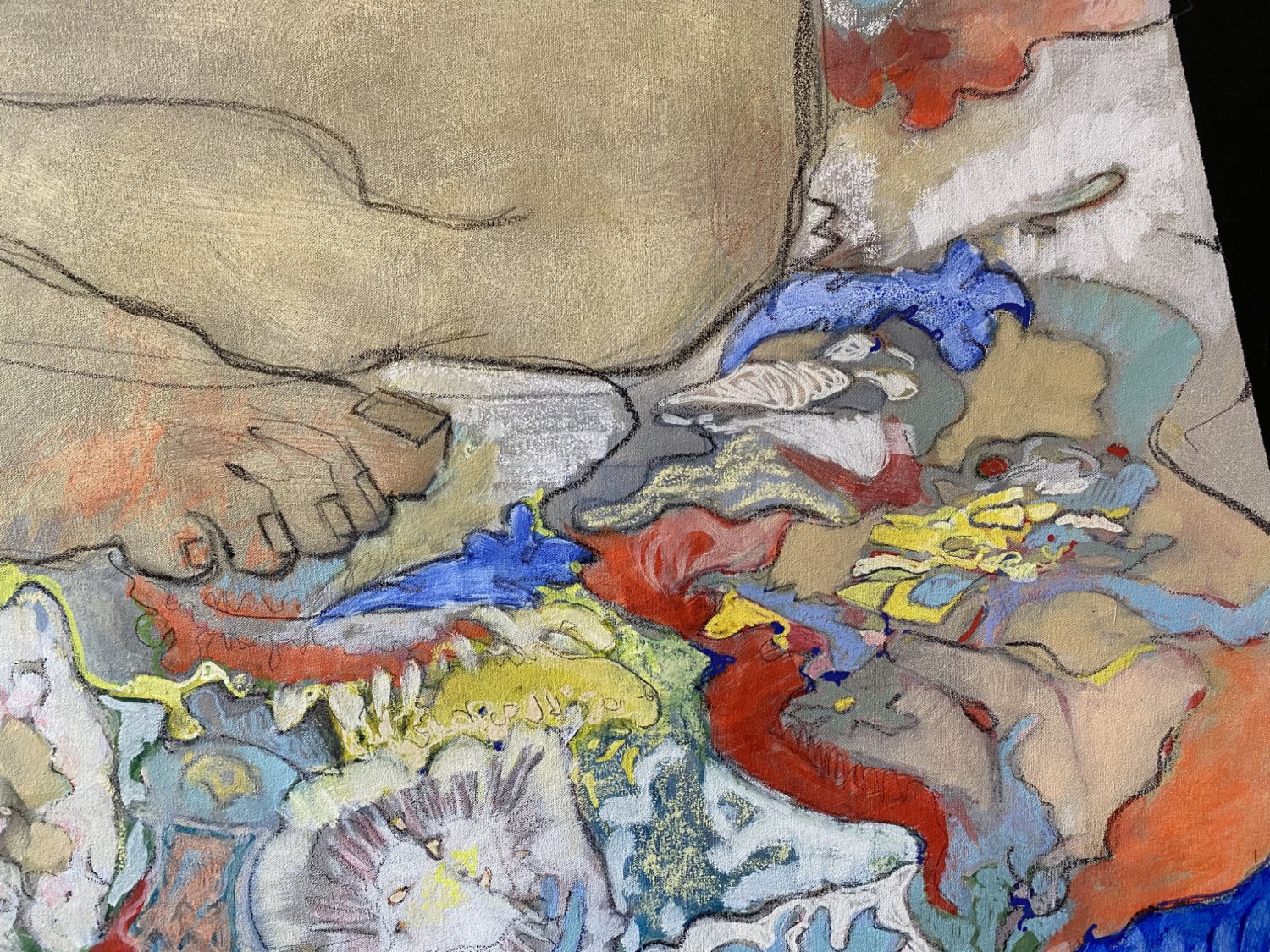
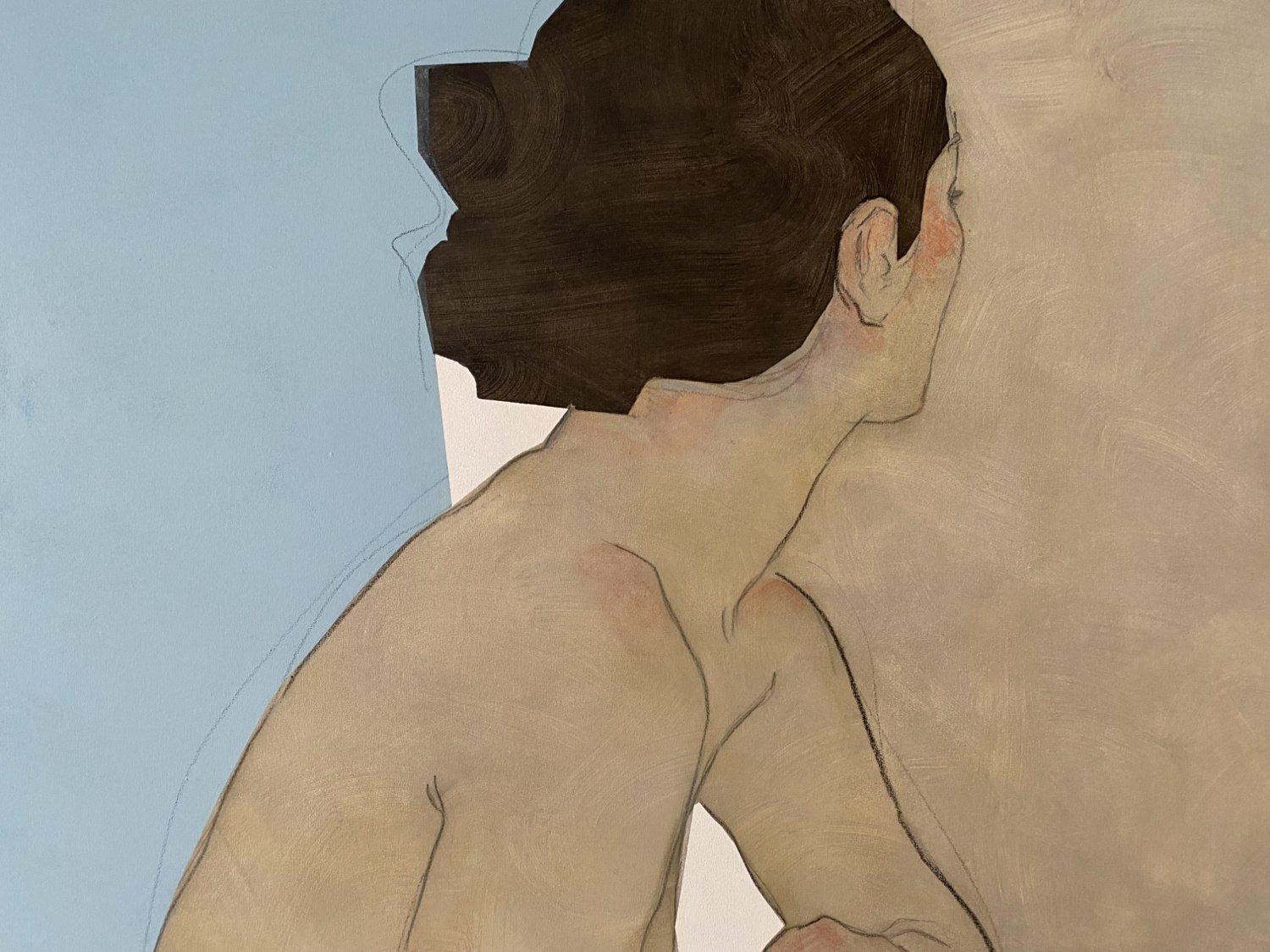
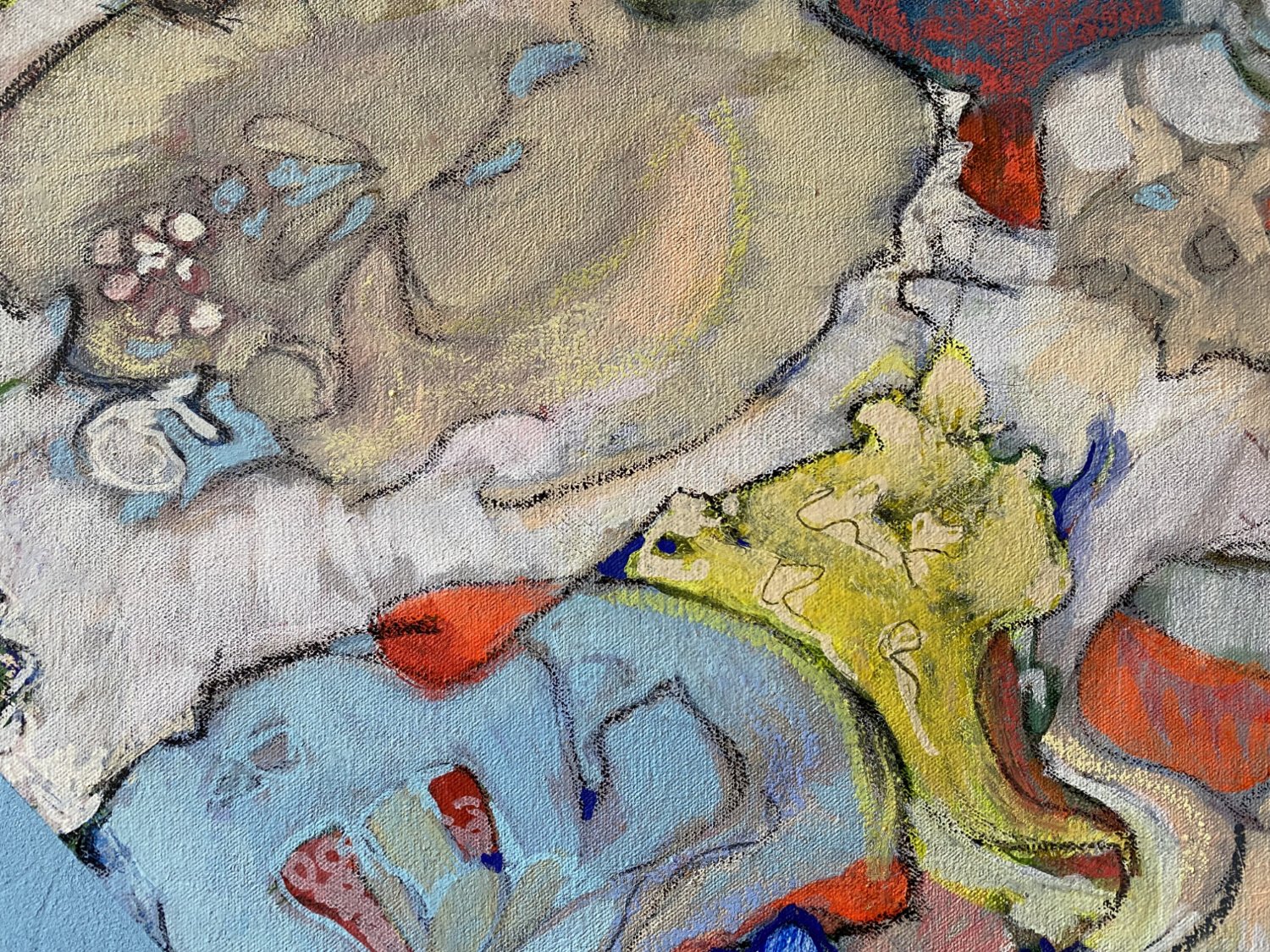
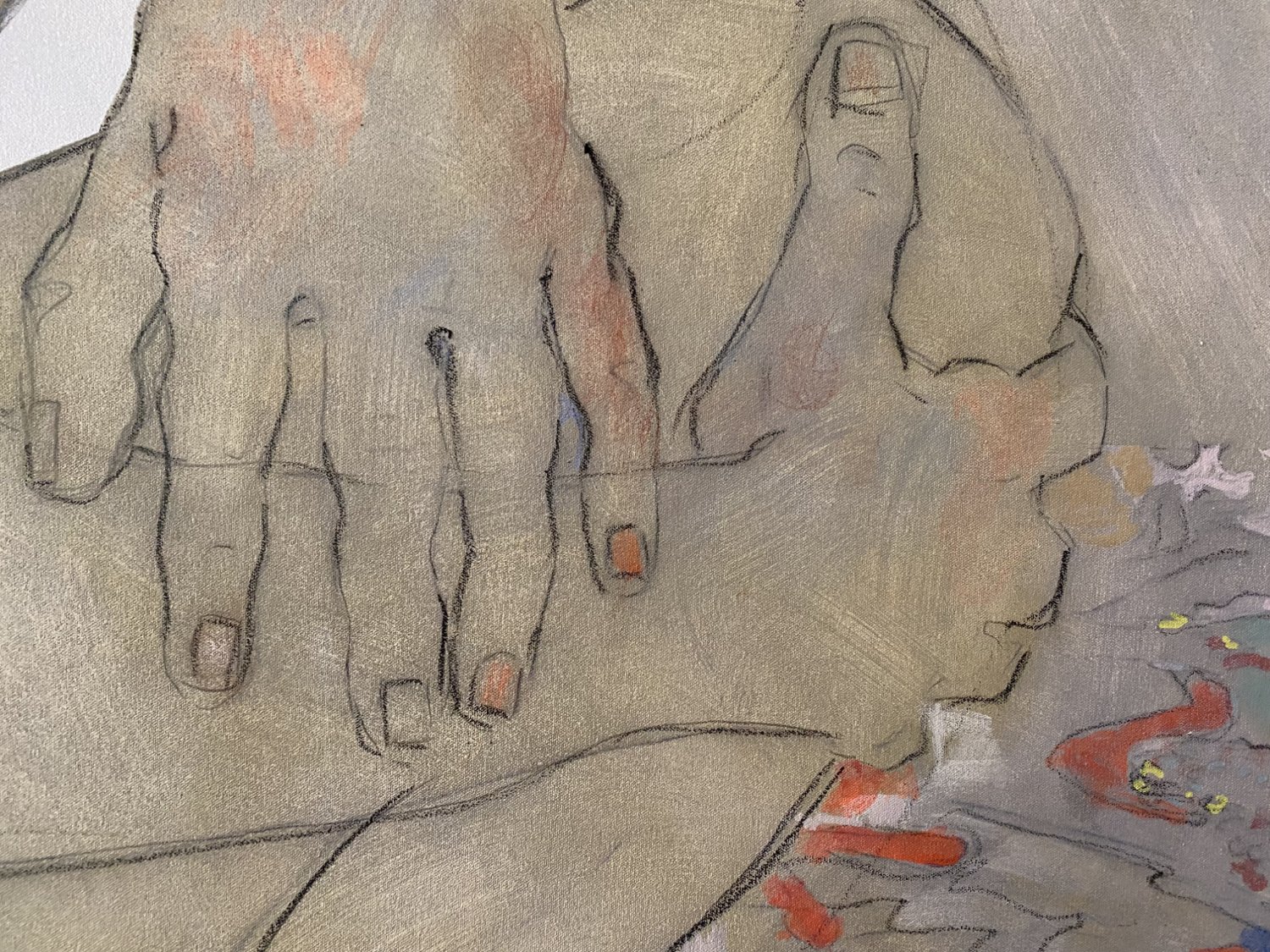
“APOLOGY”
Of Heaven or Hell I have no power to sing,
I cannot ease the burden of your fears,
Or make quick-coming death a little thing,
Or bring again the pleasure of past years,
Nor for my words shall ye forget your tears,
Or hope again for aught that I can say,
The idle singer of an empty day.
But rather, when aweary of your mirth,
From full hearts still unsatisfied ye sigh,
And, feeling kindly unto all the earth,
Grudge every minute as it passes by,
Made the more mindful that the sweet days die—
—Remember me a little then I pray,
The idle singer of an empty day.
The heavy trouble, the bewildering care
That weighs us down who live and earn our bread,
These idle verses have no power to bear;
So let em sing of names remember{`e}d,
Because they, living not, can ne’er be dead,
Or long time take their memory quite away
From us poor singers of an empty day.
Dreamer of dreams, born out of my due time,
Why should I strive to set the crooked straight?
Let it suffice me that my murmuring rhyme
Beats with light wing against the ivory gate,
Telling a tale not too importunate
To those who in the sleepy region stay,
Lulled by the singer of an empty day.
Folk say, a wizard to a northern king
At Christmas-tide such wondrous things did show,
That through one window men beheld the spring,
And through another saw the summer glow,
And through a third the fruited vines a-row,
While still, unheard, but in its wonted way,
Piped the drear wind of that December day.
So with this Earthly Paradise it is,
If ye will read aright, and pardon me,
Who strive to build a shadowy isle of bliss
Midmost the beating of the steely sea,
Where tossed about all hearts of men must be;
Whose ravening monsters mighty men shall slay,
Not the poor singer of an empty day.”
INCARNATA - 100 x 137 CM
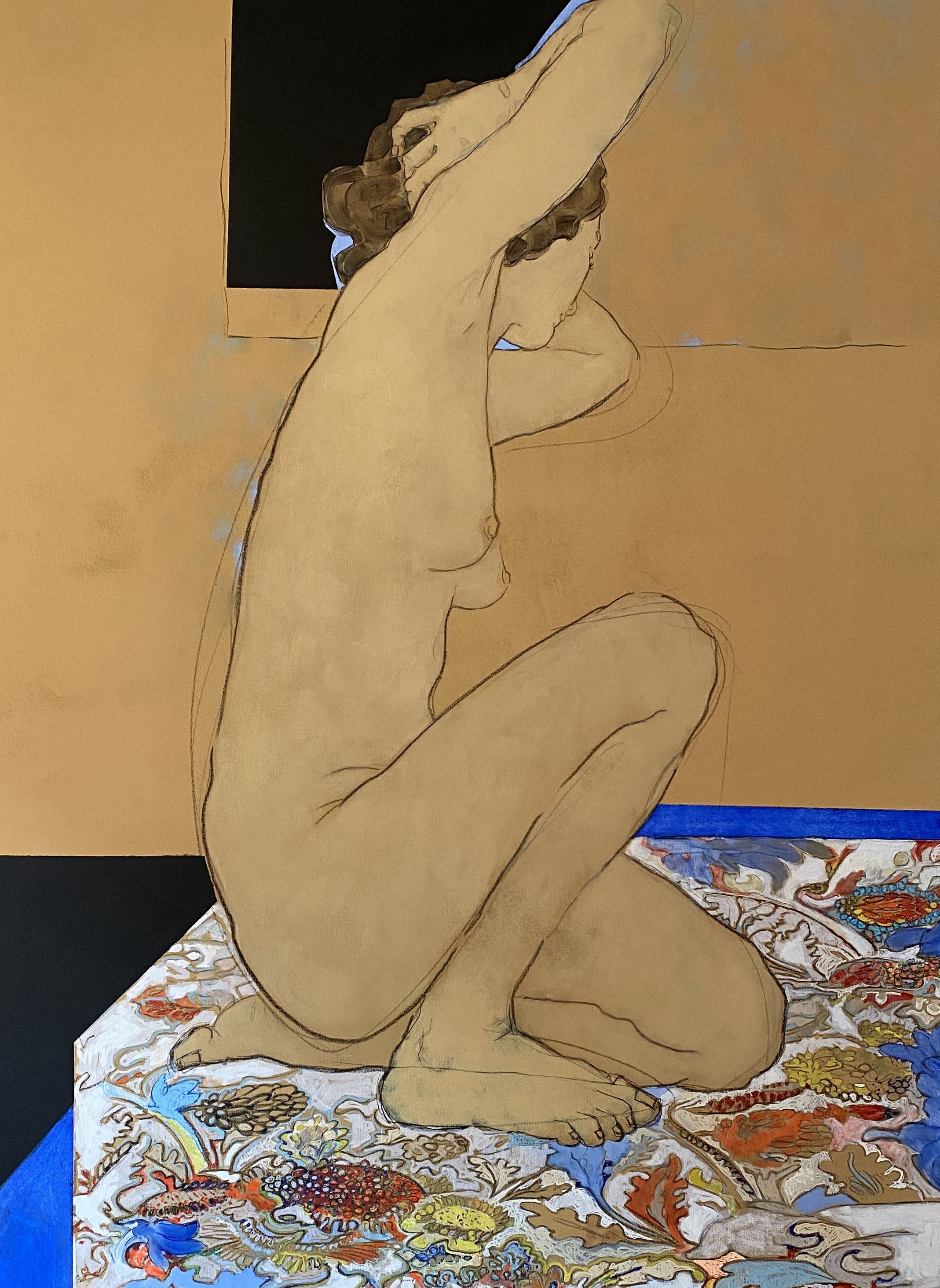
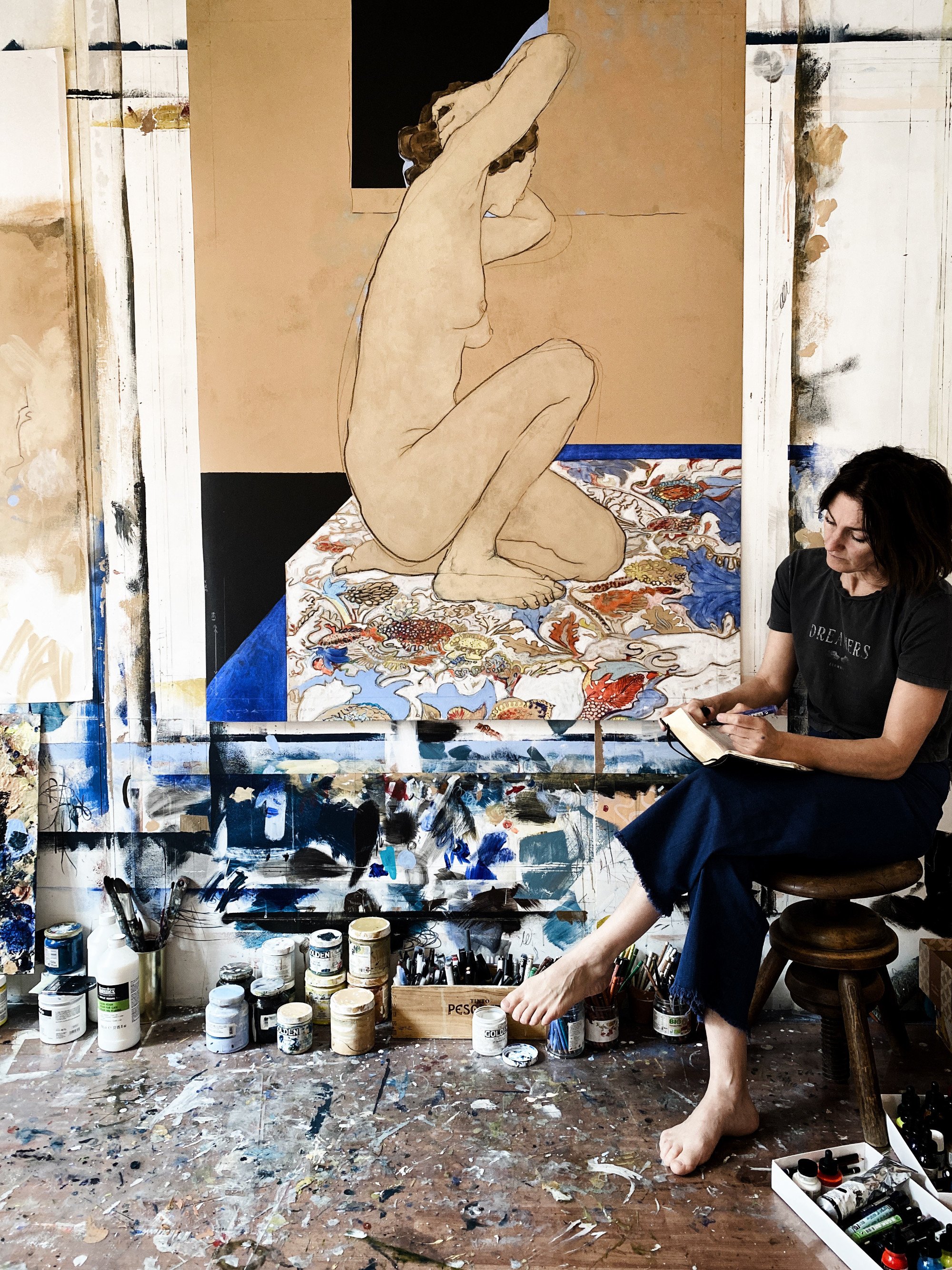
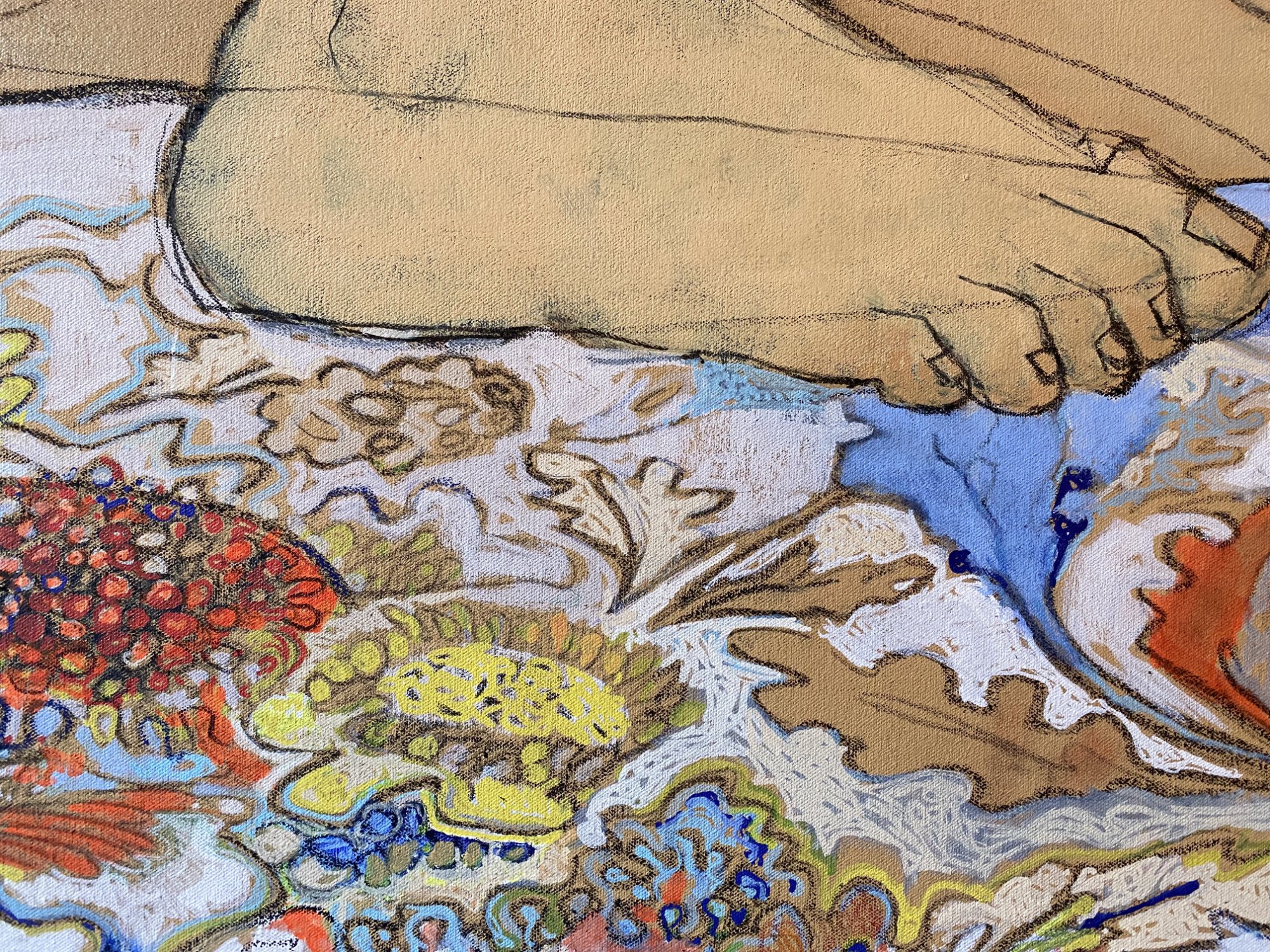
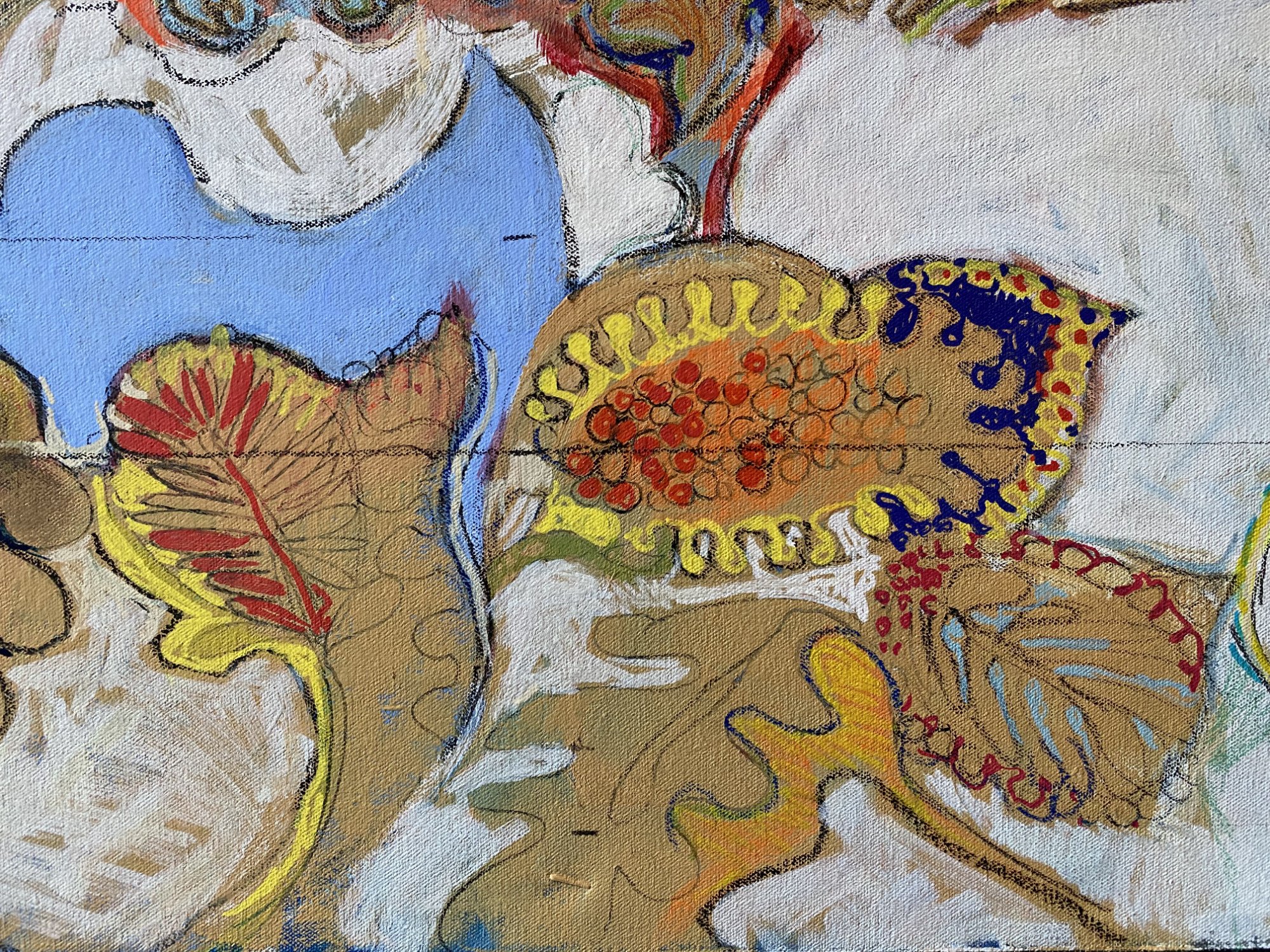

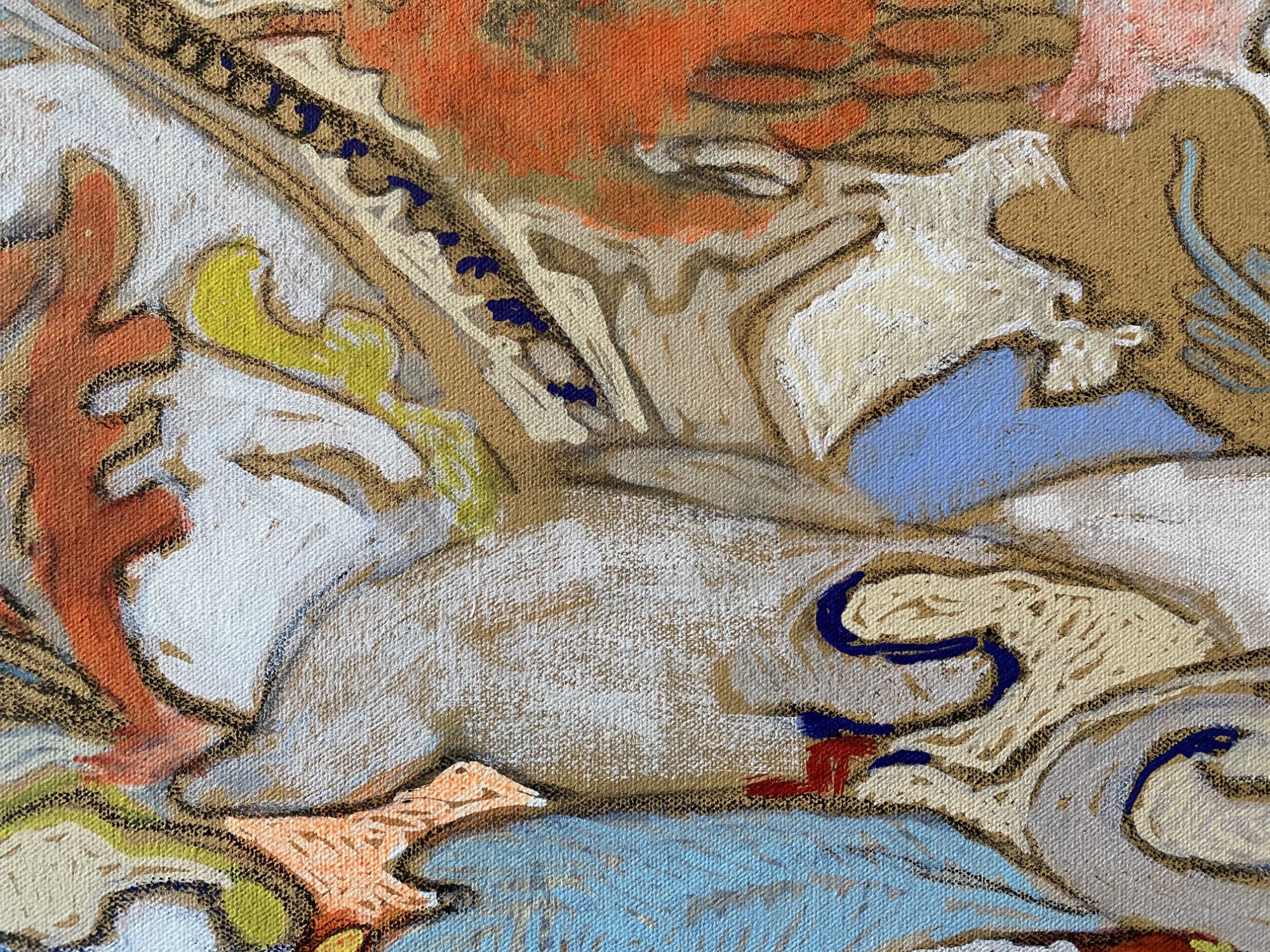
“SUMMER DAWN”
Pray but one prayer for me ‘twixt thy closed lips,
Think but one thought of me up in the stars.
The summer night waneth, the morning light slips
Faint and gray ‘twixt the leaves of the aspen, betwixt the cloud-bars,
That are patiently waiting there for the dawn:
Patient and colourless, though Heaven’s gold
Waits to float through them along with the sun.
Far out in the meadows, above the young corn,
The heavy elms wait, and restless and cold
The uneasy wind rises; the roses are dun;
Through the long twilight they pray for the dawn
Round the lone house in the midst of the corn.
Speak but one word to me over the corn,
Over the tender, bow’d locks of the corn.”
EARTHLY PARADISE
Thoughts, ideas and inspirations behind the Collection
To begin with, I must confess that I am much better at synthesising my ideas on canvas than in writing, hence whenever I try to explain my thoughts and ideas regarding my work, it inevitably turns into a long descriptive story rather than a short explanation. So I apologise in advance for my lengthy and somewhat floral phrases that may either enlighten you or leave you totally muddled up as to what I am talking about.
I was asked a number of times how I first drew inspiration from William Morris’s iconic textile designs. I was always slightly frustrated at having to give a simple and short response to this. The truth is far more fantastical, more riddled and not short at all. Hences, here is my full version:
William Morris and the strange way in which he entangled himself in my work. It began on a very windy day in London.
To be honest I was not seeking out William Morris and his work, rather it was him and his work that came hurling into my head. It all started on what must have been the windiest day in London. I had gone to the Victoria & Albert Museum for inspiration and ended up at the giftshop, as one does, looking for a gift for Rebecca Hossack as she had invited me to the Chelsea Arts Club for lunch. Nothing seemed to catch my undivided attention until I came in front of a whole shelf unit filled with William Morris books. There I got stuck, totally engrossed in leafing through books filled with his wall paper designs. I chose my favourite and decided it was a perfect gift for Rebecca as she loves flowers.
Thus I walked out of the V&A back into the storm outside. The wind was so strong it was tossing cafe chairs across streets. I reached the Chelsea Arts Club and rang the doorbell. Next thing I knew, I was in a reception room with low ceilings and walls covered in small framed paintings, among them paintings by James McNeil Whistler of course.
To me, in that moment, it was like entering a somewhat Alice in Wonderland room. Everything seemed perfect yet everything was different and odd. Further in, a carpeted staircase leading to the second floor and on the middle landing, a black and white cat, sleeping, undisturbed by human activity. In the background I could hear cheerful murmurs of ladies and gentlemen dining. I was led into the lounge area to wait for Rebecca who had not arrived yet. Through the window I could see the garden and terrazza area. Outside the wind was ripping the garden to bits, as if a tornado was gripping time itself. Inside, only the sound of a glowing fireplace and low background music. Time had been suspended.
Finally Rebecca arrived and we sat down for lunch. We discussed my new ideas for a new collection. I had in mind to add rugs or carpets at the feet or base of my nude figures. I had a vague idea that I wanted to add flowers and more colours to the paintings. However the idea was still veiled behind heavy fog. When I gave Rebecca her gift we flicked through the pages together looking at the closeup images of William Morris wallpaper designs. That is when it happened. In a heartbeat.
The idea must have been blown in by the wind, like Marry Poppins when she appears gloriously out of the sky and descends from above to land in front of George Bank’s front door. In a split second, the collection was laid out right in front of my eyes and Rebecca was talking about it as if it had already been created and completed. I was wary of the idea I must admit. Because think of it; there were going to be flowers, after all, in my paintings. But how and where? Was I not the one who wanted to paint the muses ‘void of distraction’, simplicity and restrained colour palette? Was that not my staple signature? Well, it seemed no longer. I am convinced that somewhere or somehow, William Morris himself must have been determined to make himself noticed that day.
I had come across William Morris’s work before, however I had not had the opportunity to really discover everything about him. That very day, full of excitement, I went to the book store and got several books on William Morris himself, his designs and his poetry. Thus began the journey and my research. The following day the storm had cleared and I flew back home to Madrid. That was the beginning. Only the beginning. The idea and inspiration, the first heart beat. But now the work had to start and that was going to be many many hours, days and months of heartbeats to come. So I began the work and a year later here I am, or rather, here are the paintings.
Now, it might be helpful to understand the way in which I happen to work. It is always a magical but nerve-wracking moment when any idea or image comes into my mind in that typical unexpected manner, hidden behind codes and finite frequencies, and daring me to decodify it. I often, if not always, have to work out the formula that equals the result, working my way from Z back to A. William Morris and his epic designs came to me in such a manner, entangling themselves in my thoughts and ended up bursting out of my paintings.
Just like one used to find the right radio channel by dialling the little knob on the radio to find the minutely exact position and catch the right frequency of the radio station, I find myself perpetually tuning into my inner world and searching the exact position on that metaphoric dial, that will reveal to me some hidden insight and guide me..
Differing from my previous collections, there is new tension that has appeared in this collection, that of the intricacy and intimacy of each pattern that was born uniquely for each painting. Willam Morris’s designs were the spark that triggered a whole mechanism of ideas. However, with each painting, I was starting from scratch, no matter how much I had refined the technique and method with which I had painted the previous painting. Each painting had its own secret code. As you will notice, although the collection is inspired from Morris designs, the actual flowers and patterns are not a copy of his work, nor are they a repeated pattern as would be a ‘wall paper’ design. Each flower is born from the previous one, hence they are all slightly different. These represent the heartbeat of life. They represent each individual heart beat of the muse posing in the painting.
William Morris and his aspirations became a source of inspiration that resonated with many of my feelings from the start. I found this beautiful quote by William Morris that has accompanied me throughout the year I worked on this collection.
“The true secret of happiness lies in the taking a genuine interest in all the details of daily life.”
William Morris had many aspirations during his life, a poet and artist of the Romantic movement he was also very involved and actively supporting social reform. But one of his main aspirations was to create beautiful and crafted designs and objects that would also have purpose in one's daily life and home. He sought to depict nature in all its glory and beauty in many different forms. This dedication towards creating beauty for daily life, to improve one's state of emotion, resonates with my ideas and my daily life. This new direction in my work allowed me to rediscover in detail the world as a place of wonder and to nurture the emotions through finding beauty in every corner of the canvas and of my heart.
Hence this collection has three main cornerstones: finding beauty in every detail of life, reviving the ideology of the Romantic Movement and on a more personal note, painting the patterns of the heart onto canvas.
Another aspect of his life and work that resonated with me was the whole Romantic Movement that emphasised the importance of the moods of the heart, beauty and nostalgia. This artistic movement is also often associated with the idealism of the muse, which symbolises the belief that the world is beautiful, and that the imagination is a source of inspiration. A desperate romantic himself, Morris was married to Jane Morris, the idyllic model of the Pre Phaphaelist painter Gabriel Dante Rossetti. She was a muse, a real muse, also to become Rossetti’s lover. The lady with long wavy hair, thick lips, was a real muse, not an idealised woman Rossetti had made up.
I found photos of Jane Morris online. She was something out of this world. Her exotic beauty, her tremendously nostalgic gaze. This is where Jane became an additional connection and inspiration to my own work. There was a muse in Morris’ life, a woman, a wife, a mother, a lover, who had longings and feelings, with a distinctly unique heartbeat. And finally, I discovered Morris’s poetry, they blew my mind. Romantic, complex and thick with nostalgia. I was trapped in a whirlwind. Everything about his life and aspirations pulsated a living heartbeat. Everything about his ideas and his work was whispering in my ears, longing to get out into the world again.
This collection tells a story, a story of romanticism, of an ideal garden, an earthly paradise. The muse in this collection, speaks of the longing for a thousand kisses upon her face, of a thousand promises for the future. The flowers represent her heartbeat and they speak of a thousand caresses upon the skin.
The patterns of the heart are a mystery, a whirling mass of energy, never satisfied with one single emotion, always seeking more complex ones. The heart watches the tapestry of springtime colours, the stillness of a winter day and it beats its unique pattern of life.Each flower in these paintings are slightly different from each other because each heartbeat is ever so slightly different to the previous one. Our emotions determine the speed of each heartbeat. Thus with each heartbeat we evolve into a slightly new person. This new collection is an evolution, the evolution of myself as well as of my muses who have also grown into new women since I started my very first collection.
This collection seeks to describe the tapestry of the heart.
The addition of William Morris’s poetry on the back of each painting is perhaps the most intimate part of the painting. The part that one only sees if he or she can detach the painting off the wall. I have added this element of writing on the back of my paintings for quite a number of years now.
In each painting, the muse posing for the painting, I capture the external aspect of her body, maily her back, so that one can feel the presence of her unique character, rather than be distracted by the nudity. Then we have the symbolic backgrounds that represent her inner thoughts, her heartbeat. And finally the inscriptions on the back together with the colour palette of the painting, represent the more codified aspects of the painting, perhaps the more mystic part of a person, the soul. The additional poetry or text and colour palette on the back, are as important to me, much as the renaissance painters used to inscribe the formulas of determined colours they created from raw materials. It is a secret corner and tiny detail to the painting.
The initial research for this collection began through reading about William Morris and his work. After which I would go back to imbue my eyes with his designs with the start of each painting. Each painting was named after the latin name of a flower. Each painting carries with it a poem of William Morris. The collection was name ‘Earthly Paradise’ after the poem he wrote which is divided in the 12 months of the year. Eventually it was decided, for the exhibition, to call the collection ‘The Strawberry Thief’ ( that is the name of one of the patterns that I was inspired by). In both cases, these two titles resonate with the collection as it represents the beauty of nature and the romantic idealism of life, both very present in my heart. We could say that William Morris's designs stole a little piece of my heart. I believe that the difference in my work to the traditional Odalisque portraiture is that I paint the woman from a woman’s perspective, that of nudity not being an object of sexual desire. For me, the nude was a way to portray the person’s soul. My very first model and muses were mothers themselves as these were at the time my friends, being myself a mother with young children as well. I have since kept that course, inviting more women who are mothers to pose for the ongoing collections.
In a way, I wanted to honour motherhood from a different angle. Hence in the paintings, there are no hints that suggest these muse are all mothers. In the end they are beautiful striving women, who bloom with each passing day. They are still individuals that have a romantic heart, longings, ambitions, dreams. These paintings are an everlasting reminder that they have remained unique secular icons and sources of inspiration. Each muse is an individual person with her unique story, and although their names are anonymous to the public, they are real and proud of being part of these collections.
I have recently been asked how I see my work evolving in the future. I must admit that this is an almost impossible idea to foresee. Any plan I try to imagine will be replaced by what the new ideas floating in the air will bring in, unexpectedly, in its most surprising manner. In a way, the paintings that come to me are already paving the future path for me. Each new creation feeds towards the next one, even when a new collection starts, there is always a gradual evolution of the work and style. I try to not over plan, stay true to my instinct. I believe that the application of new colours in my work, more intricate details in the form of flowers will continue to evolve into my new collection, but exactly how these paintings will look is a mystery to me until the day they bloom. I suppose it is a little like planting an unknown seed into a pot and watching it grow from a tiny sprout into a green plant, and suddenly one morning being filled with wondrous delight at finding that it has bloomed into flowers, bursting with colour. You knew it would happen but you didn’t know when it would happen and what colour the flowers would be. And so just like that, in a heartbeat, something that did not exist before, is created out of thin air and bursts into life.
To be continued with the following collection…




